

Blossoming Creativity: 40+ Delightful Spring Crafts and Activities for Kids!
Welcome to a world of vibrant colors, blooming flowers, and endless creativity! As the warm breeze of spring breathes life into nature, it's the perfect time to engage your little ones in a whirlwind of fun and educational crafts and activities. In this exciting blog post, we've curated over 40 spring-inspired ideas that promise to bring joy and laughter to your home.
From adorable flower crafts to nature-inspired scavenger hunts, our collection is designed to spark imagination and foster hands-on learning. Whether you're a parent, teacher, or caregiver, these activities cater to a range of age groups and skill levels.
So, grab your crafting supplies, put on your gardening gloves, and join us on a journey filled with creativity and exploration. Let's celebrate the season of renewal and growth with these engaging spring crafts and activities that will leave your kids smiling from ear to ear!
We had so much fun with our dandelions yesterday we wanted to keep exploring ways to play! This is such a fun and easy nature play inspired activity that will have children mixing all kinds of concoctions as they learn and play!
Go on a nature walk in your community and begin collection dandelions, grass, rocks and other ingredients for your soup!
Once you have your ingredients add them to your playtray compartments and fill your playtray with water. Then add yellow food colouring and cornstarch then mix! Add bowls, sieves and scoops and then begin mixing in your ingredients.
Invite children to scoop, pour, measure, mix, and explore!
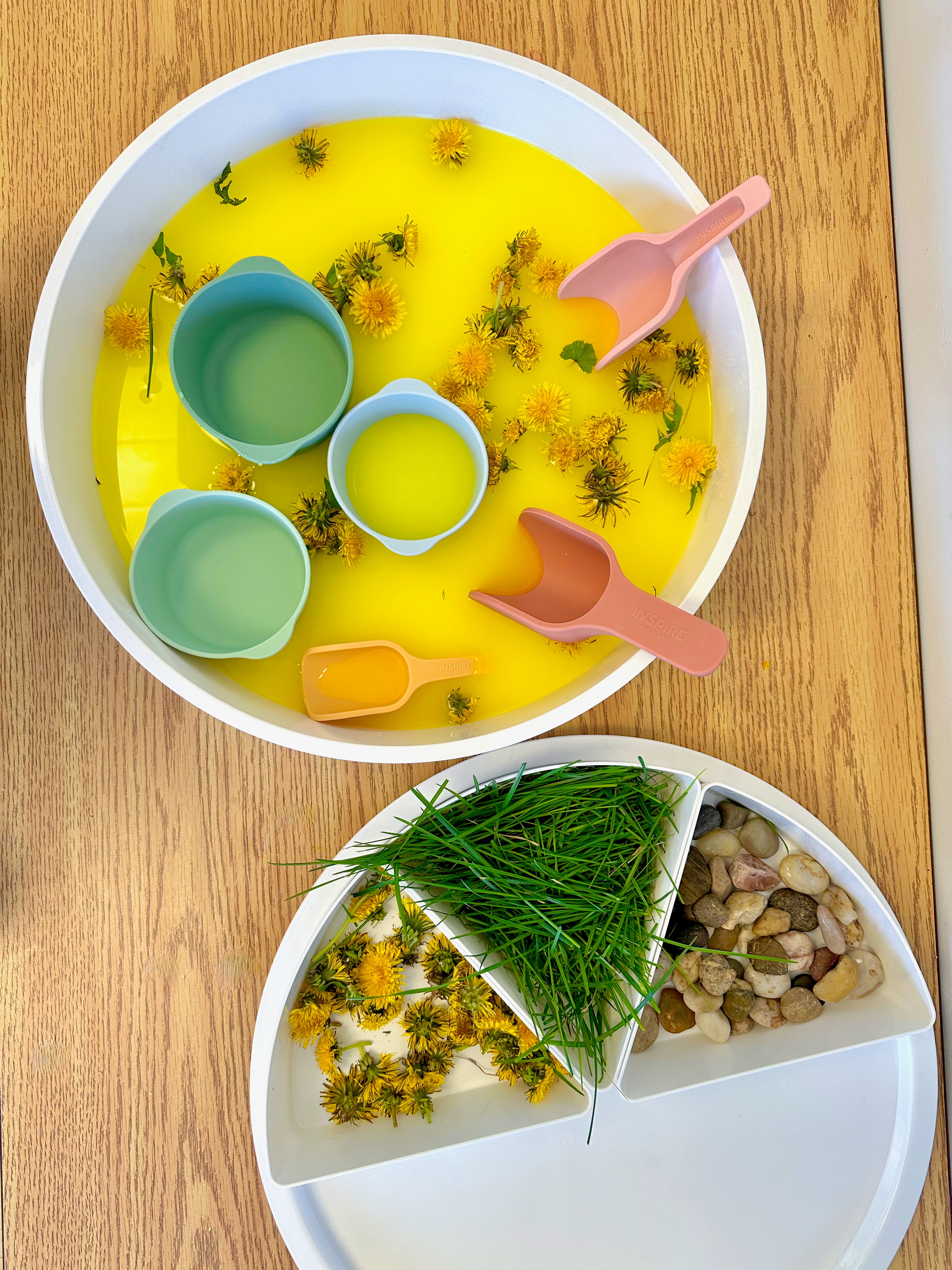

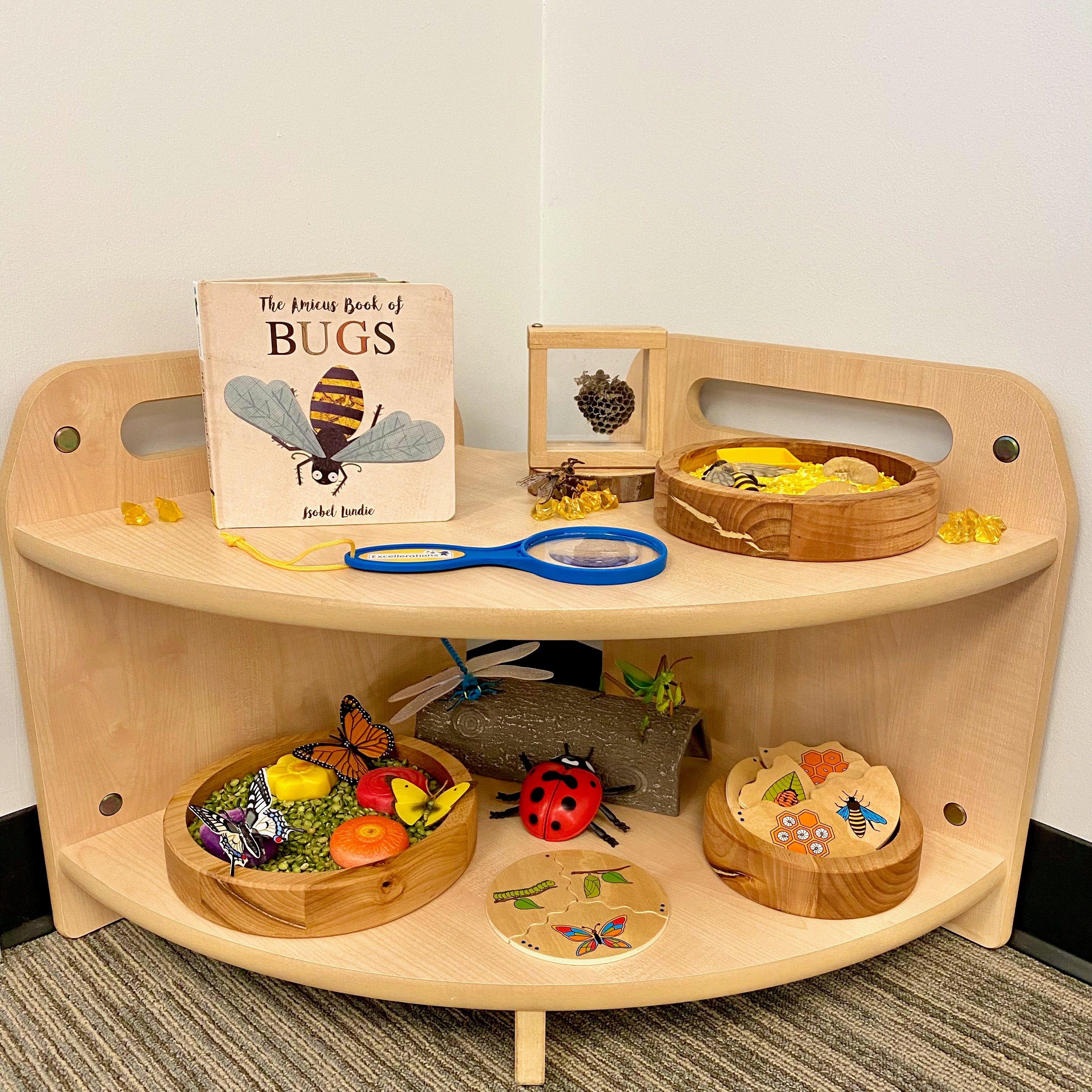

Bug Investigations Inquiry Shelf
What stories will children create or discover as they explore this bug and life cycle themed shelf? Themed shelfies are a great opportunity to expand on a specific child led interest that supports their inquiry in many different facets!
Some inquiry points that are supported by this shelf:
-Can you identify the bugs? Which ones do you know? Which ones do you want to read about in the book?
-Can you build the life cycle of the different bugs?
-What do you notice about the honey bee hive? Can you draw it?
-What are the role of pollinators in our gardens and communities?
-Can you make bug fossils out of playdough?
-What stories can you create with items from this shelf?
Nature Investigations
Go on a nature walk in your local community or backyard with children and collect all kinds of unique and different nature treasures! Bring them back to your learning space and place them in a tuff tray, add magnifying glasses, a microscope, a book about nature, nature investigation stones and take observations on paper or a whiteboard.
Children can compare the stones to their nature treasures, make observations of up close discoveries, take rubbings using wax crayons, make imprints in playdough and more! They can also start a nature journal and continue to make connections with nature in their daily exploration.
Conserving nature begins with connecting to nature! Research shows that giving children opportunities to engage in hands-on nature-based activities can increase children’s excitement toward environmental behaviors. As children participate in observing nature it can promote that connection to nature.
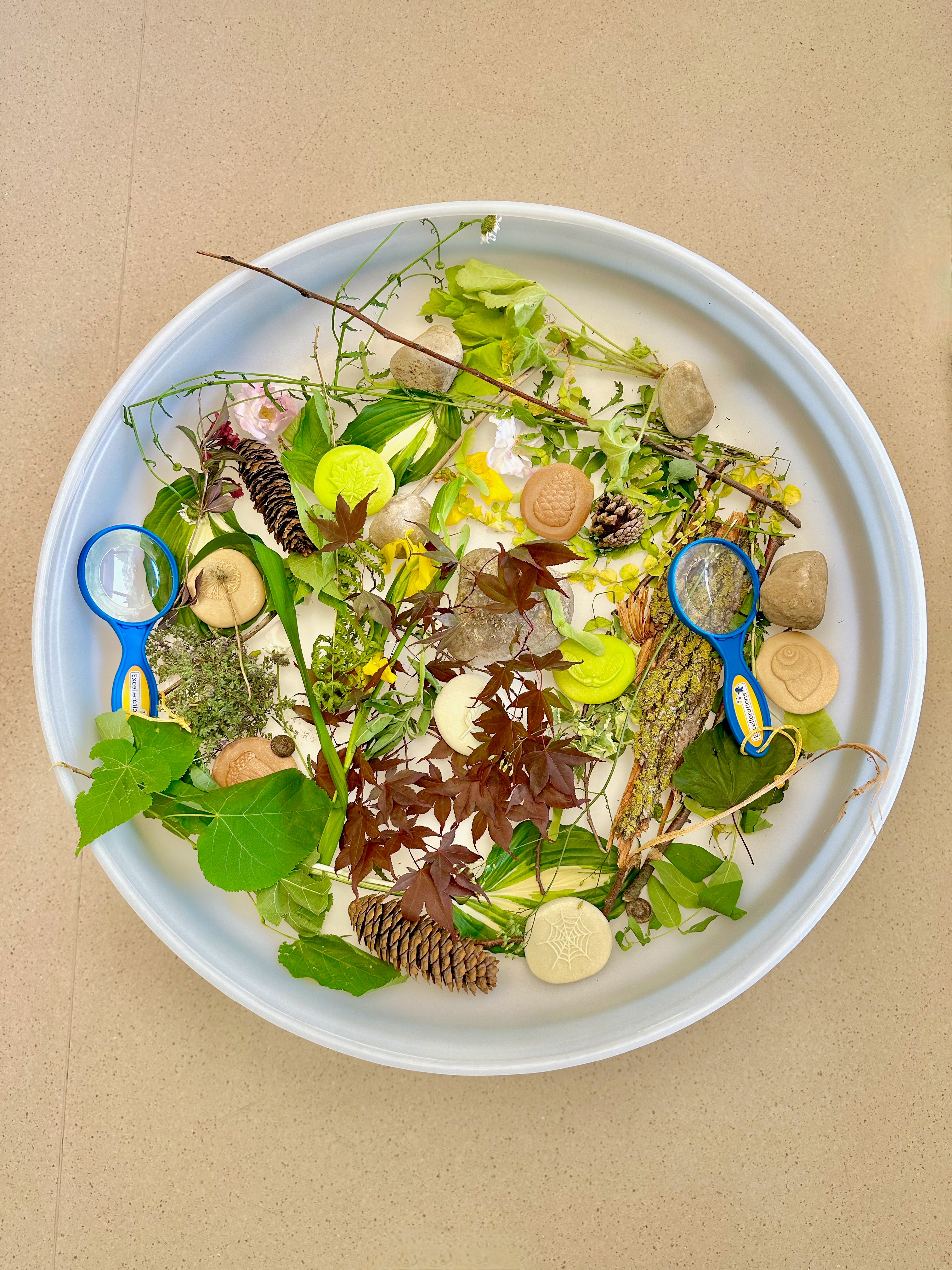

Process Art Paint Mix Butterflies
This fun and easy process art activity allow children to explore colour mixing, paint patterns and creates a beautiful & unique butterfly each time!
All you need:
-Thick card stock
-Washable Tempera Paint
-Scissors
Step One: Fold your sheet of cardstock in half and then draw the shape of half a butterfly along the folded edge! When ready, cut out the shape of your butterfly.
Step Two: Take washable tempera paint and on half of your butterfly add any colour in any design you want and fold it into the blank side and flatten the paper to spread the paint.
Step Three: When ready, open your butterfly to reveal its unique colouring and design!
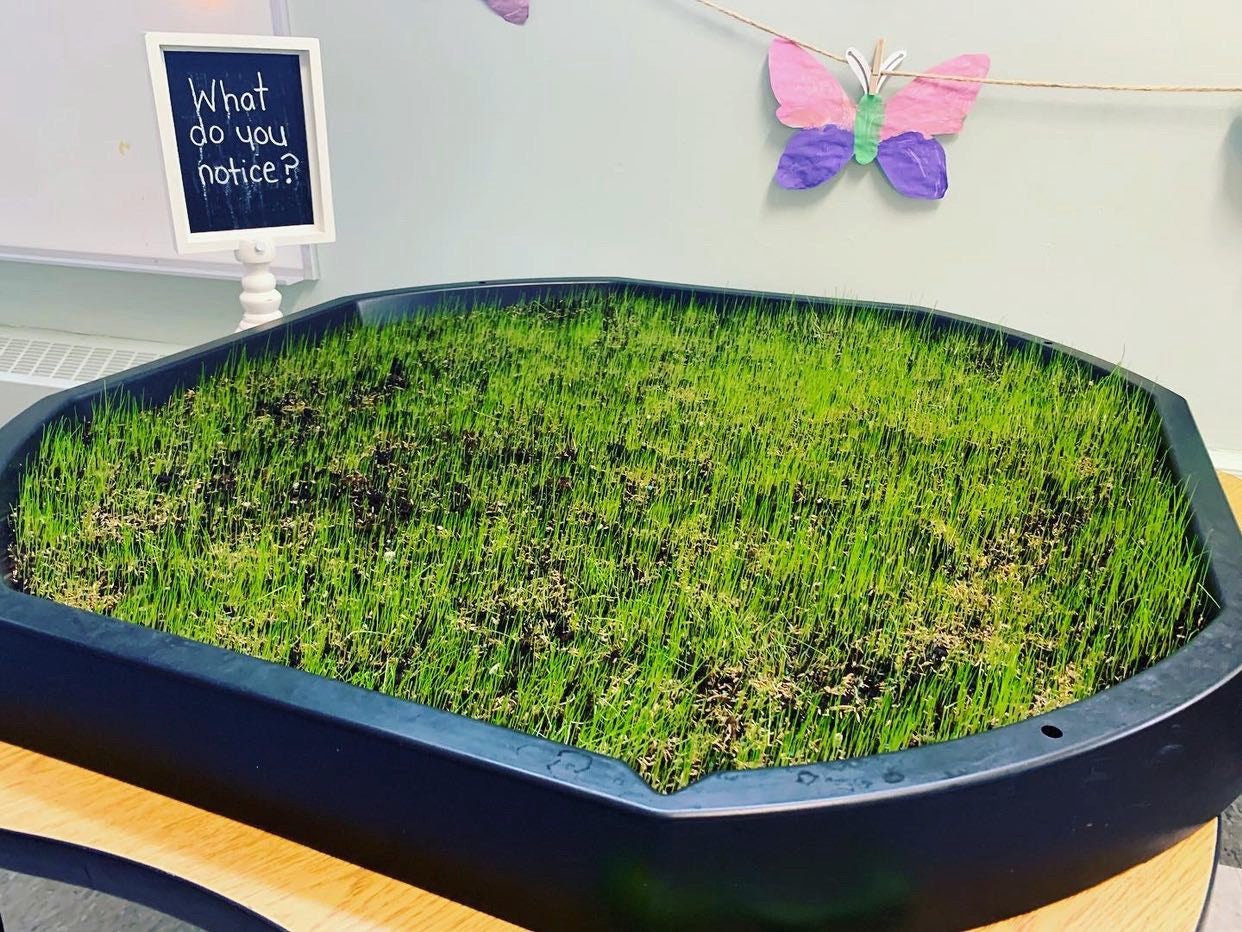

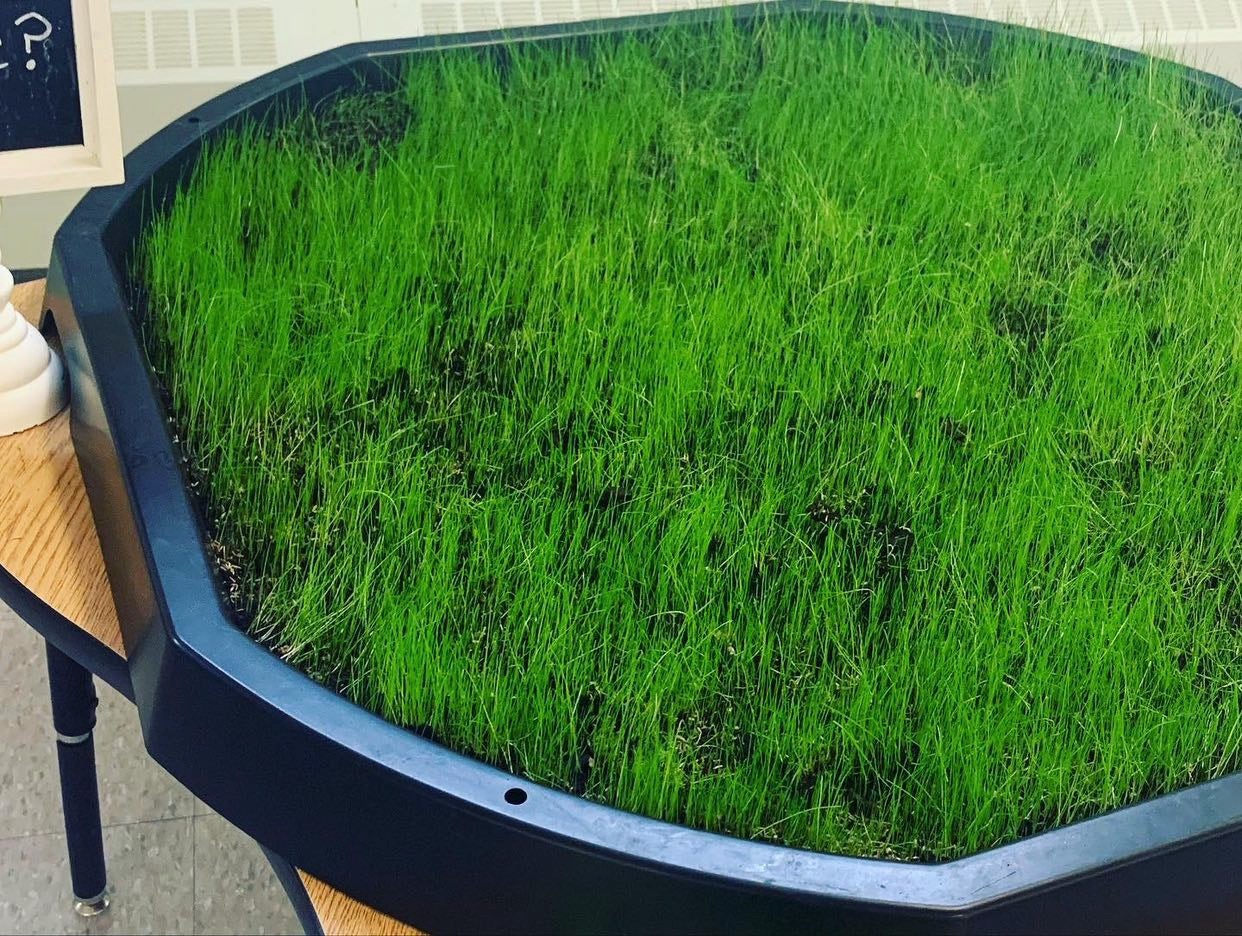

Growing Grass
To grow your own grass in the tuff tray fill it with potting soil and then sprinkle grass seed over your tray and thoroughly water it! Then loosely cover with a cut open garbage bag to keep the humidity in. The humidity will help the grass to sprout. Note, It can grow a little mold, but it will go away as the grass dries up. Water every night!
This is such a fun and easy nature potion play activity that children will love. They can pour, scoop, measure and create!
Go on a nature walk in your community and collect flowers, leaves and grasses. Then take your deep tuff tray outside and fill it with water and dye it with food colouring! Add your flowers, scoops, tea pots, potion bottles, etc. Then invite children to mix and explore creating floral potions!
As children play they build fine motor skills as the children pluck and snip flowers and leaves as they collect. They will make decisions as they choose their ingredients for their soup. Build math knowledge as they explore measurement, weight and more!
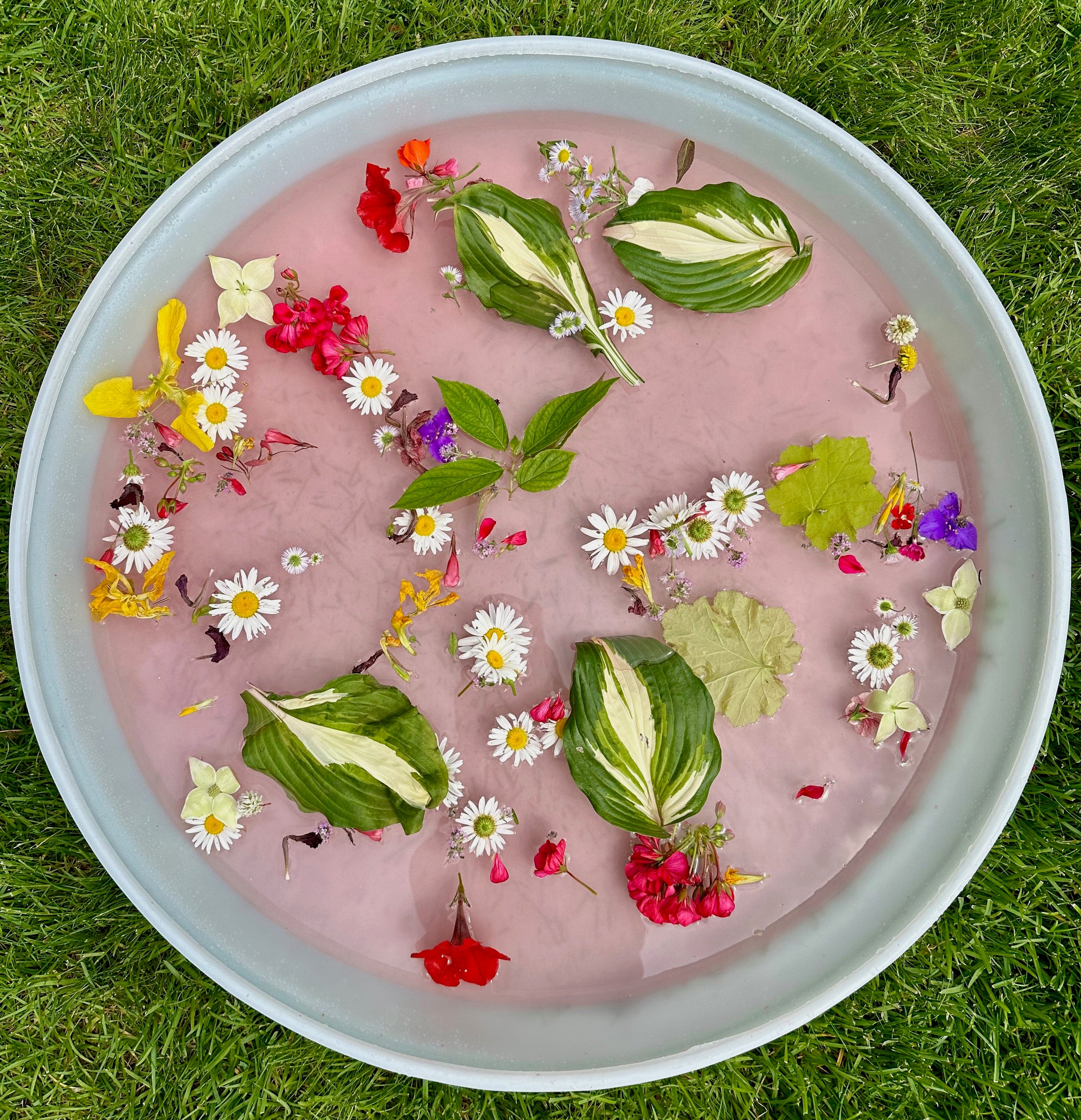

Dandelion Painting Process Art
This is such a fun and easy nature inspired process art that you can do right after a nature walk.
Take your little learners outside on a nature walk and collect dandelions! Once you have collected enough dandelions for everyone, offer tempera paint on a paper plate and dip your dandelions in the paint and stamp them on the paper!
Notice the textures and imprints of thee dandelions on the canvas!
Nature Bird Feeders
This fun and easy outdoor nature inspired craft that will have your local birds coming by to visit all the time! All you need is 1/3 sugar, 1/3 water, 1/3 flour and birdseed!
In a playtray pour in all your birdseed so children can easily cover their craft roll in tasty treats for the birds! In one of the compartments add your sugar, water and flour to make a paste and then with paint brushes and have children cover the craft roll and then dip it in the bird seed! Add string through and then hang them up in trees for birds!
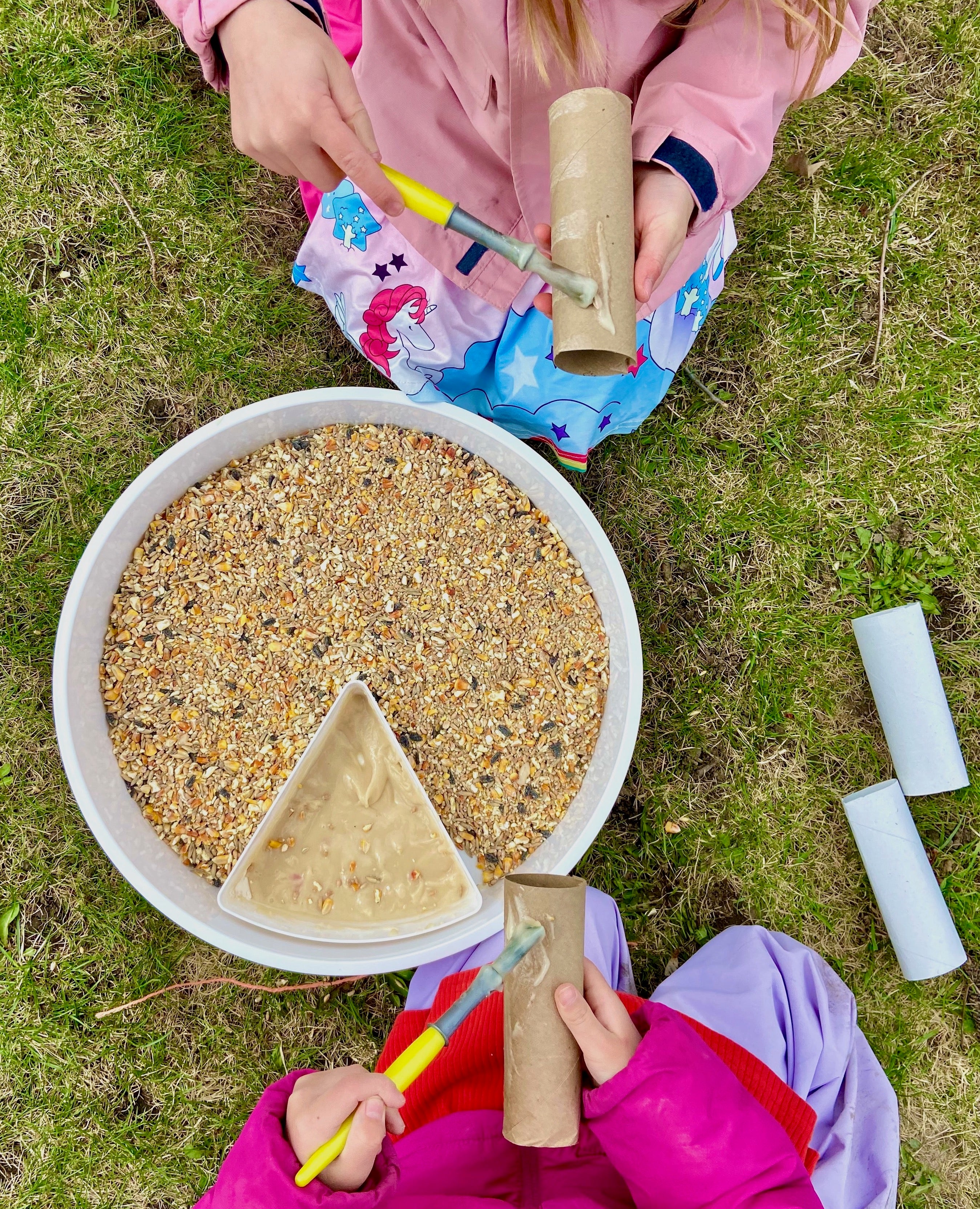

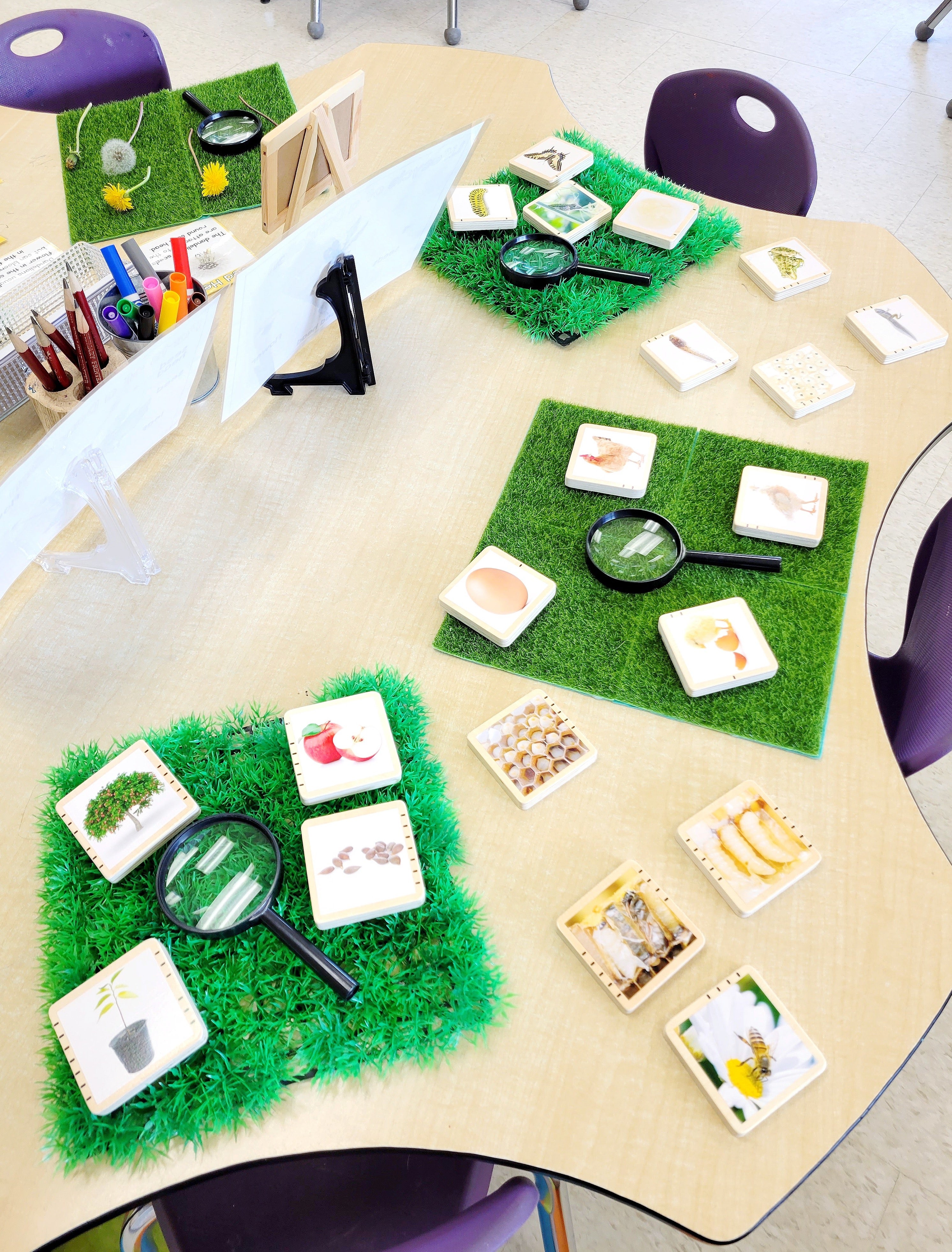

Children are naturally curious about the world around them, they are inquisitive and love to wonder about nature. As we enter spring it is the perfect time to naturally observe the lifecycle as it naturally occurs in nature as a sign of spring! This invitation inspired by the process of the lifecycle and its different stages!
Showing 4 stages for each lifecycle, the self-correcting tiles illustrate the growing and development process of humans, bees, frogs, apples, butterflies and chickens. Perfect for teaching children to understand the concept of lifecycles, and how different species are similar and different during their lifecycle process. The tiles are self-correcting, so children can easily sort into species groups and learn to identify each stage.
This is such a fun and easy process art activity that children will just LOVE.
All you need:
-Washable Tempera Paint
-A Salad Spinner
-Construction Paper
-Googley Eyes
Take a circular object and trace it on paper to create the shell for your snail and cut it out! Using tape secure your snail shell to the bottom of the salad spinner and then pour paint of all colours over the shell. Spin, spin, spin! Then reveal your shell.
On a piece of construction paper draw the body of your snail and cut it out! Cut an additional strip and cut it in half and attach to the head and choose large googly eyes to attach! Then using white glue attach your snail shell to the body to create your unique and colourful snail.
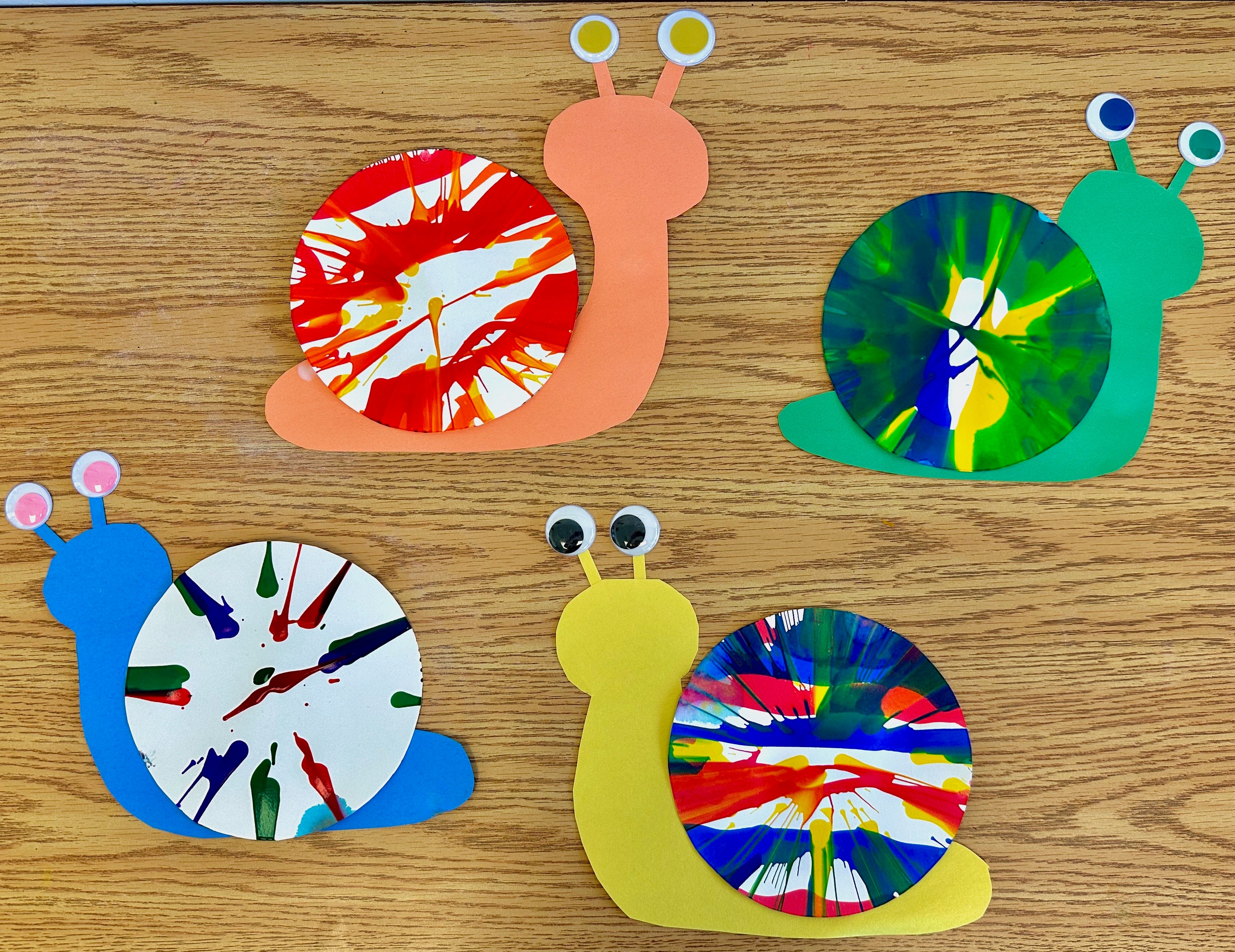

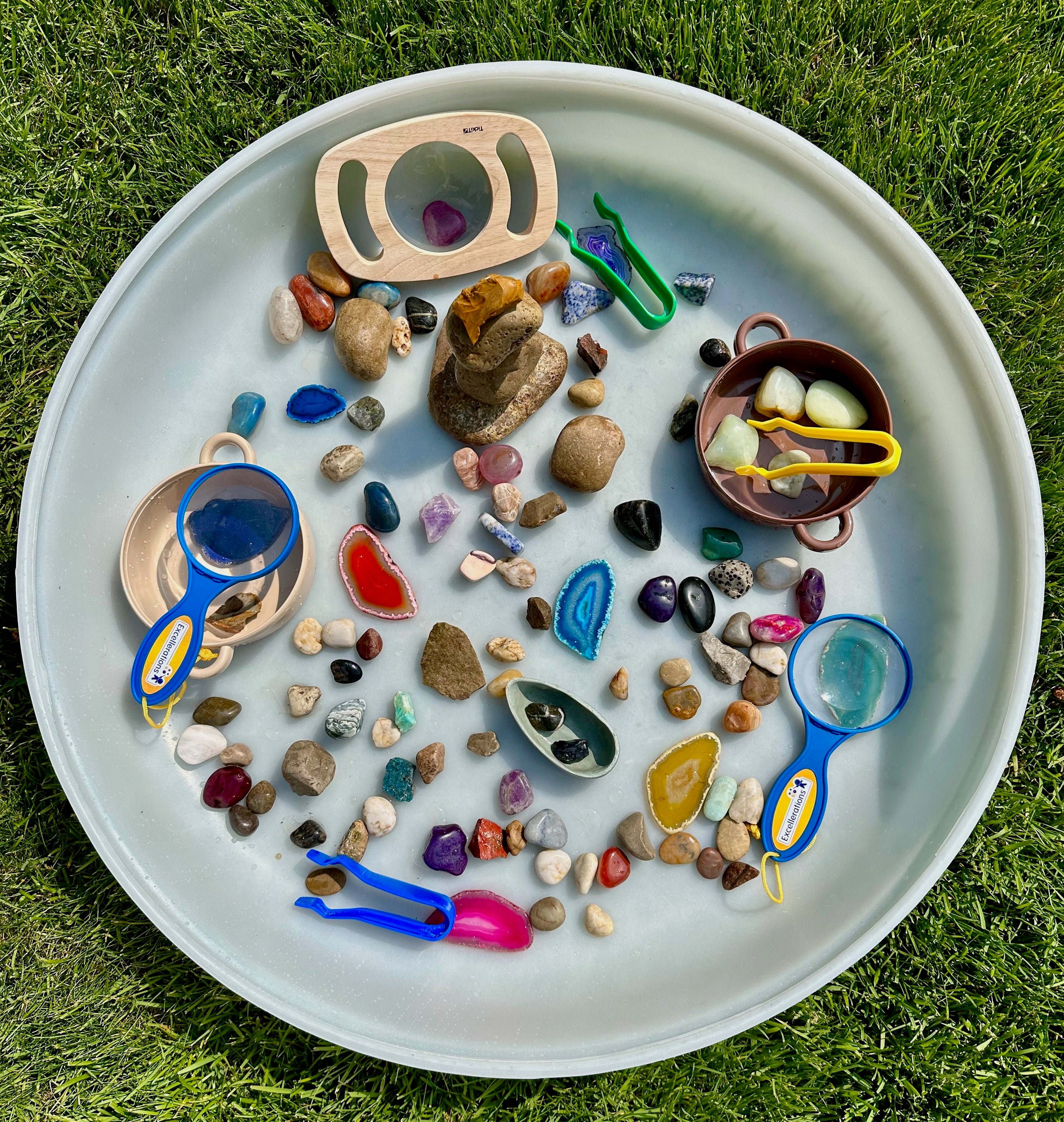

Rock Investigations
Children love investigating the natural world around them and often their first choice of nature treasure to take home with them are rocks! They love their unique shapes, colours and designs. This tray allows them to investigate and explore rocks up close.
Go on a nature walk and invite children to collect rocks they find interesting, you can even ask them to bring some from home! Place them all in their tuff tray and add tools for investigation; magnifying glasses, paint brushes, bowls with water, writing materials, rock guides, books about geology and more.
Wash the rocks by dipping them in water and scrubbing them clean with brushes. Children can look closely at them and start comparing them to the rocks on rock guides or books!
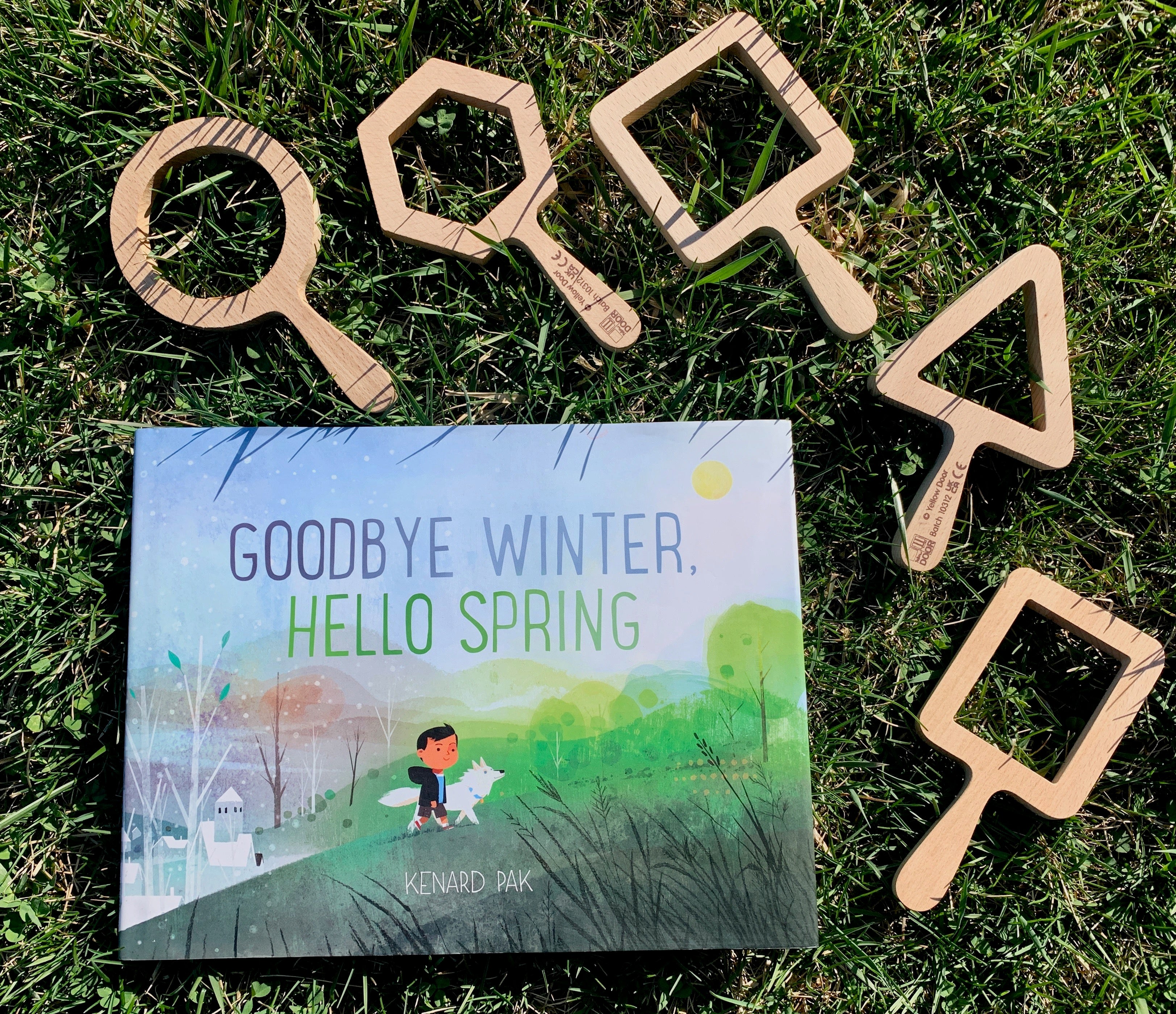

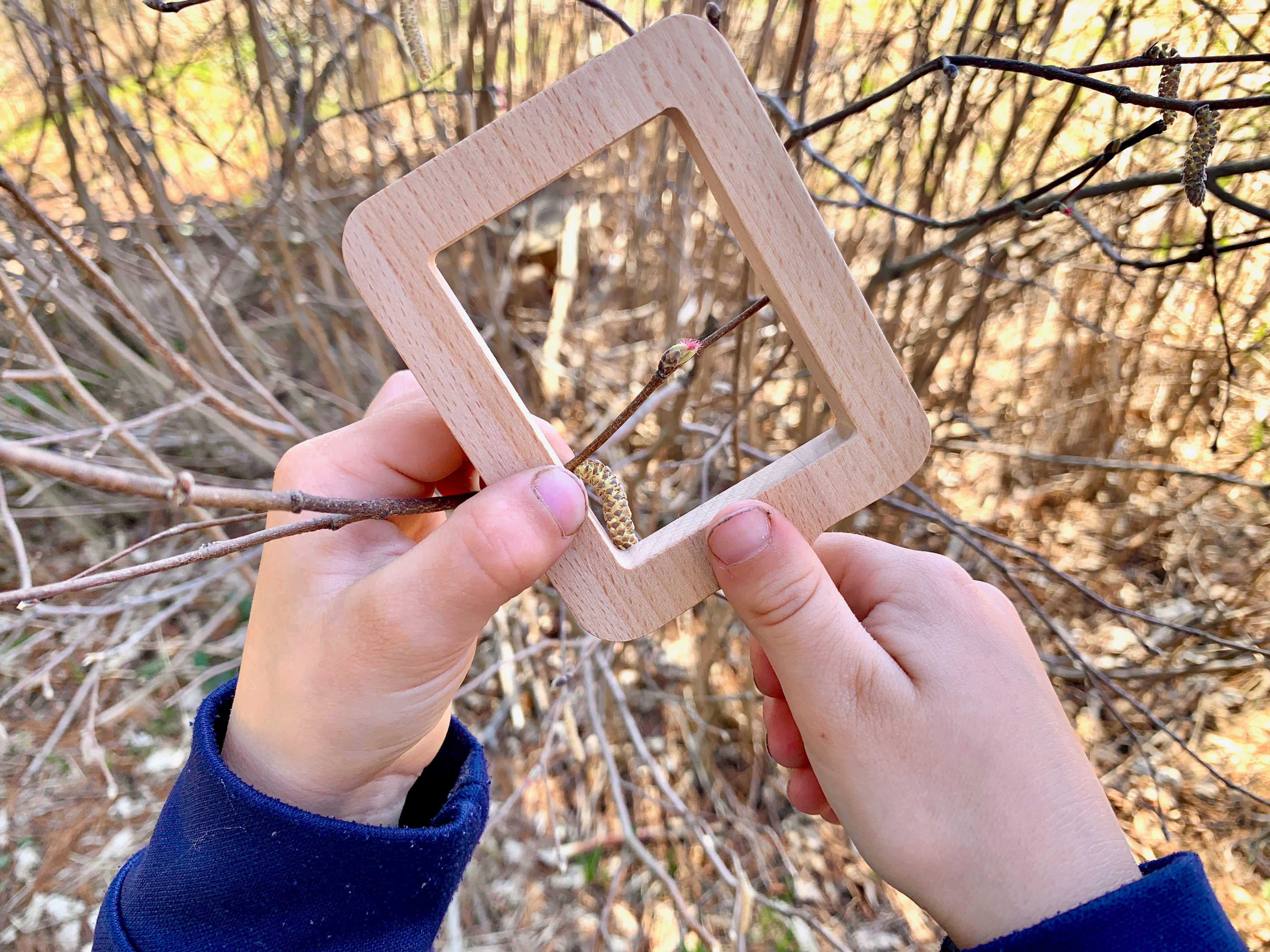



Vegetable Garden Harvest & Wash
Can you help harvest the vegetables from the garden and clean them off so they are ready to be eaten?
This activity is a fun way to practice real life skills through play! In a sensory bin pour potting soil and mix in water to create a mud mixture. Once your mud is ready begin planting your vegetables in the dirt and then add garden tools. In the tuff tray place a tray full of soapy water and spray bottles with soapy water to help clean the vegetables! Begin finding all the vegetables and washing them!
Ways to extend the play:
-Read a book about growing your own fruits & vegetables
-Talk about the process of different fruits & vegetables growing - what do they look like as they grow?
-Talk about when you know they are ready to harvest!
-Talk about what fruits and vegetables can easily be grown at home!
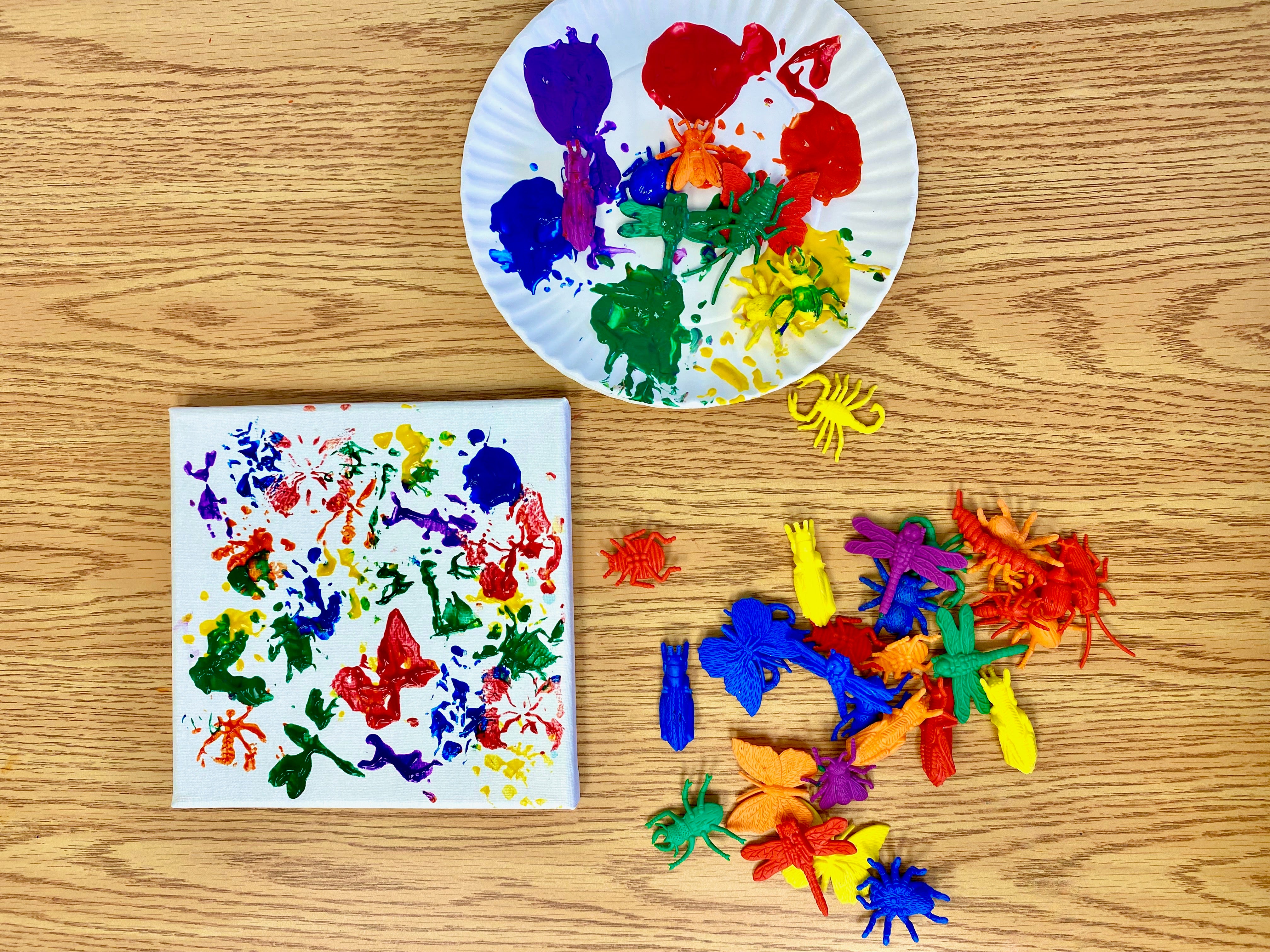

Bug Paint Prints
This is such a fun and easy spring bugs inspired process art!
All you need:
-Insect Counters
-Stretched Canvas
-Washable Tempera Paint
Have children observe the bugs! What do they notice? How many legs do the bugs have? Do they have wings? Then dip them in paint and then on the canvas to take an imprint of their shape.
After it dries you can try and match the imprints or talk about what you notice!
Nature Insect Hunt
Can you find all the bugs that are hiding in this small world? This activity is a fun way to explore insects and explore natural items and talk about how insects are part of and impact our ecosystems!
To create this sensory bin pour topsoil in a container. Add natural pieces from your local area like sticks, flowers, moss, leaves, wood rounds and more! Take your insects and hide them throughout the sensory bin. Once all your insects are hidden, place magnifiers in the bin to aid observation!
Ways to extend the play:
-Talk about insects and the role they play in ecosystems!
-Do you recognize any bugs in this ecosystem? Can you identify them? Do you see them in your local area?
-Read a book about bugs or create a bug hunt matching sheet and have children match the bugs!
-Ask them to draw a certain insect they see!
-Record notes about each insect as you look at them up close with the magnifiers, what colour are they? Do they have wings? How many legs?
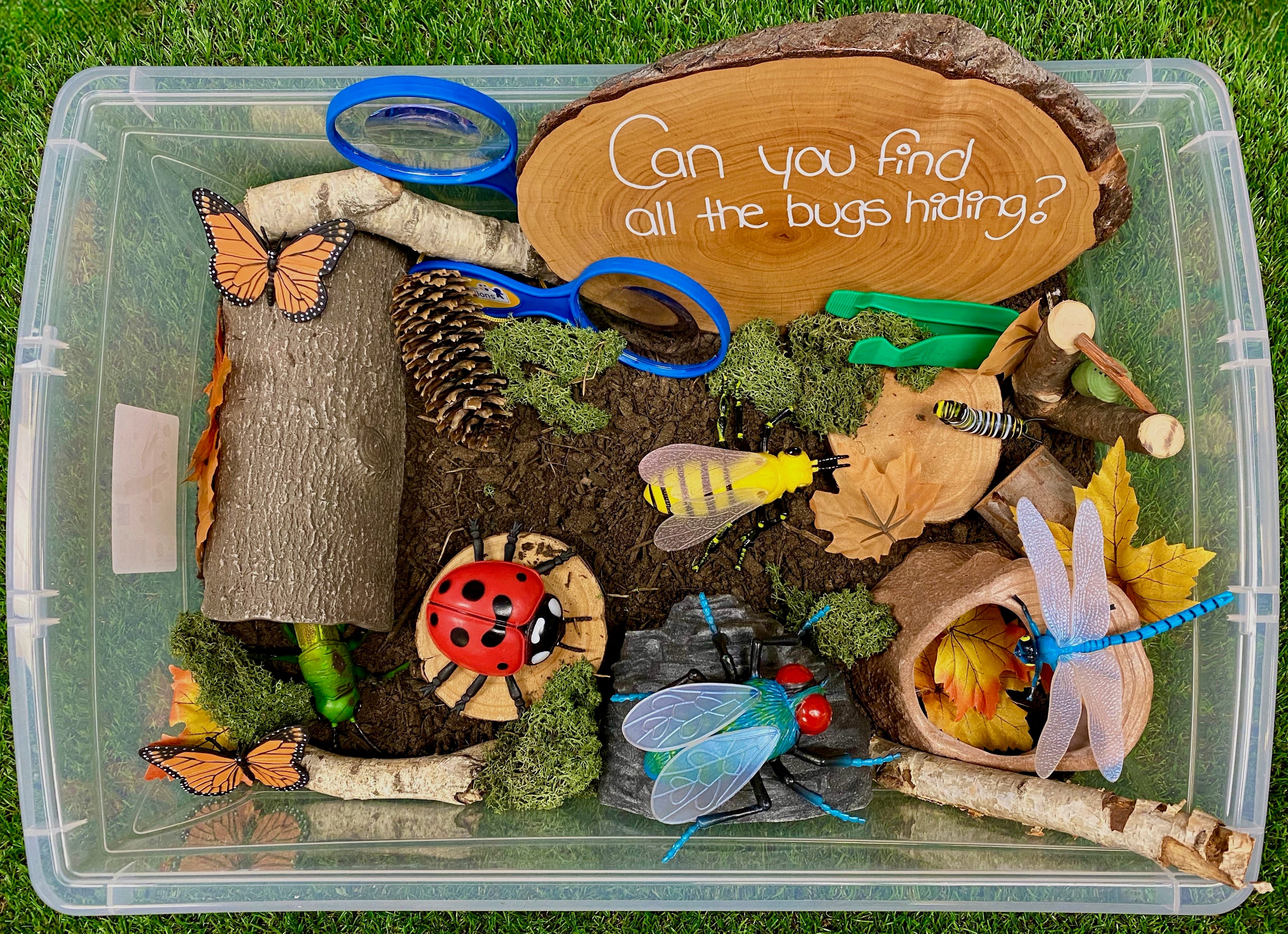

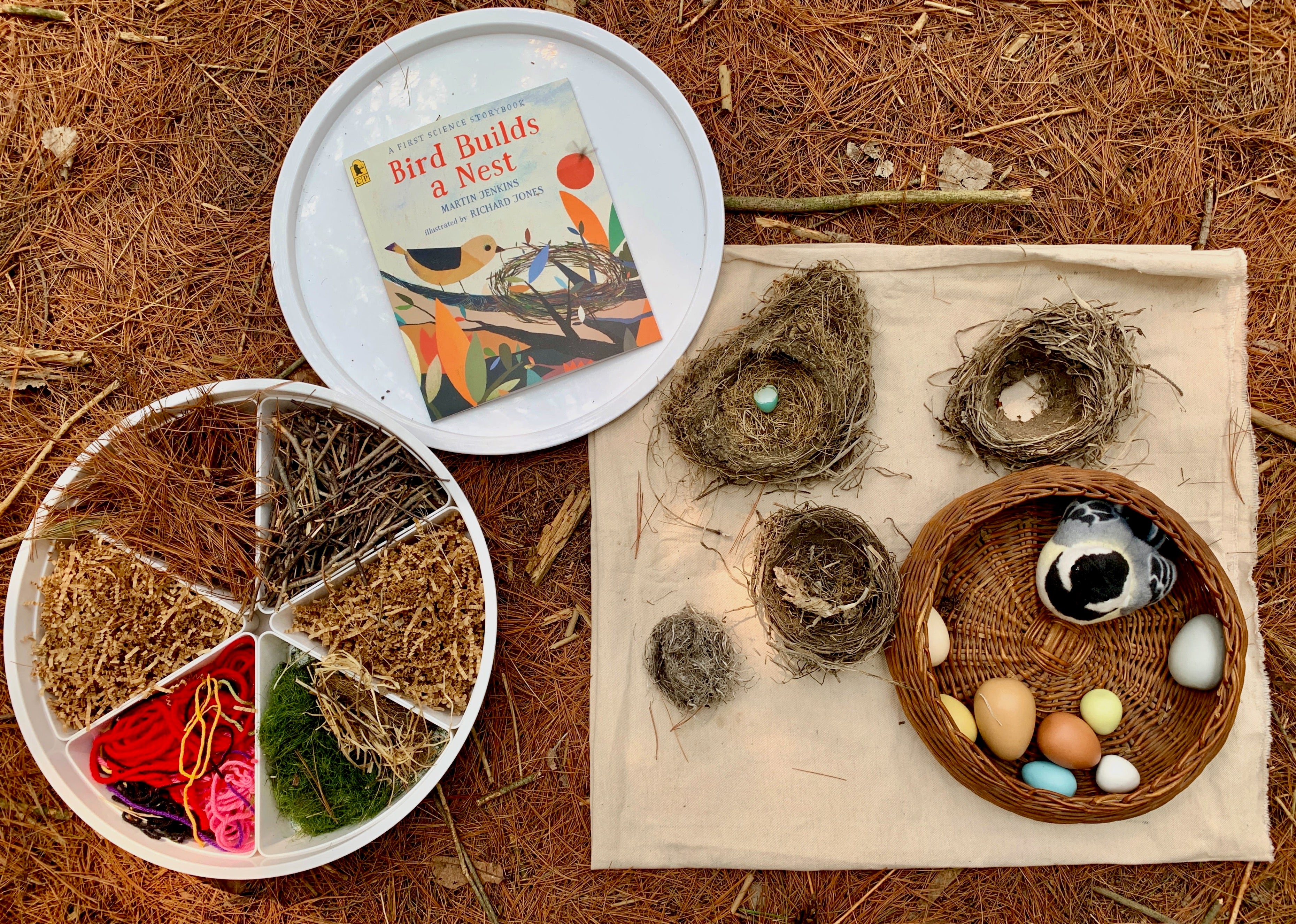

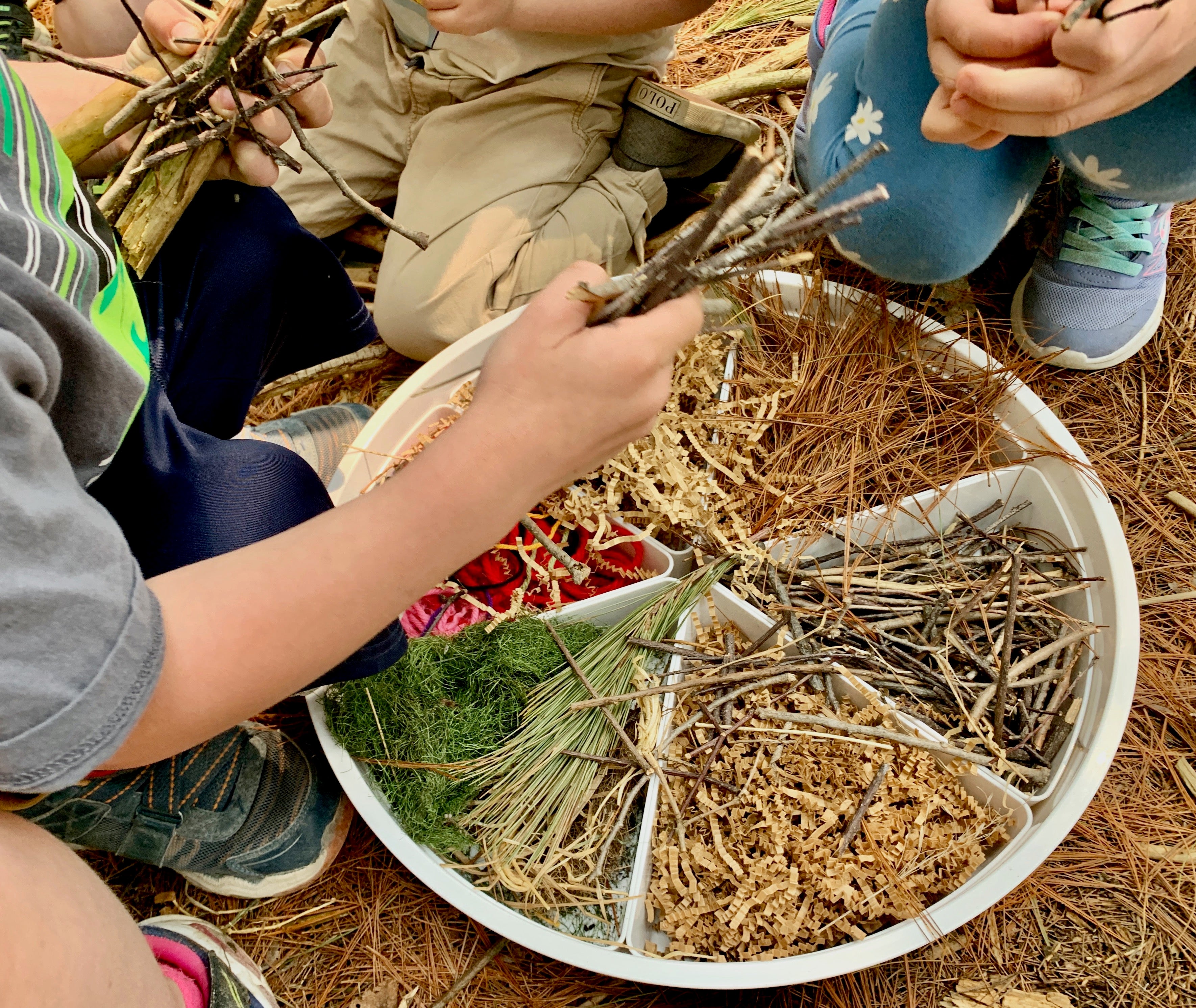

This is such a fun and easy process art activity that allows children to explore creating their own paint and mark making.
Go on a nature walk in your community and collect dandelions. Then place your dandelions in a container and using either a pestle and mortar or a rock crush your dandelions! You want to see loose petals and dander gently coming out. Then pour a quarter cup of boiling water in with your dandelions and wait! Watch as the water continues to change and grow more yellow naturally dyed by your dandelions! Then using a sieve filter put your dandelions so you are left with your dyed watercolour then paint away!
Children will love exploring mark making and painting!


Can you help water the garden?
This activity is a fun and easy to cool off as you play outdoors!
On your tuff tray use chalk markers to draw a garden full of flowers of different colours and heights! Once you have created your garden full water spray bottles and jugs and take your tray outside and lean it up against a fence and encourage children to water the garden!
Worm Graphing
Can you find all the worms and graph them by colour? This is a super fun spring themed math invitation.
In a sensory tray pour in a black sensory base or dirt and add your worms! To make the worms, cut pipe cleaners to a smaller size and bend them. Make sure they are all colours and length! Then add magnetic wands and invite them to dig for worms!
Ways to extend the play:
-Measure the worms based on length
-Compare worm lengths
-Count colour worms!
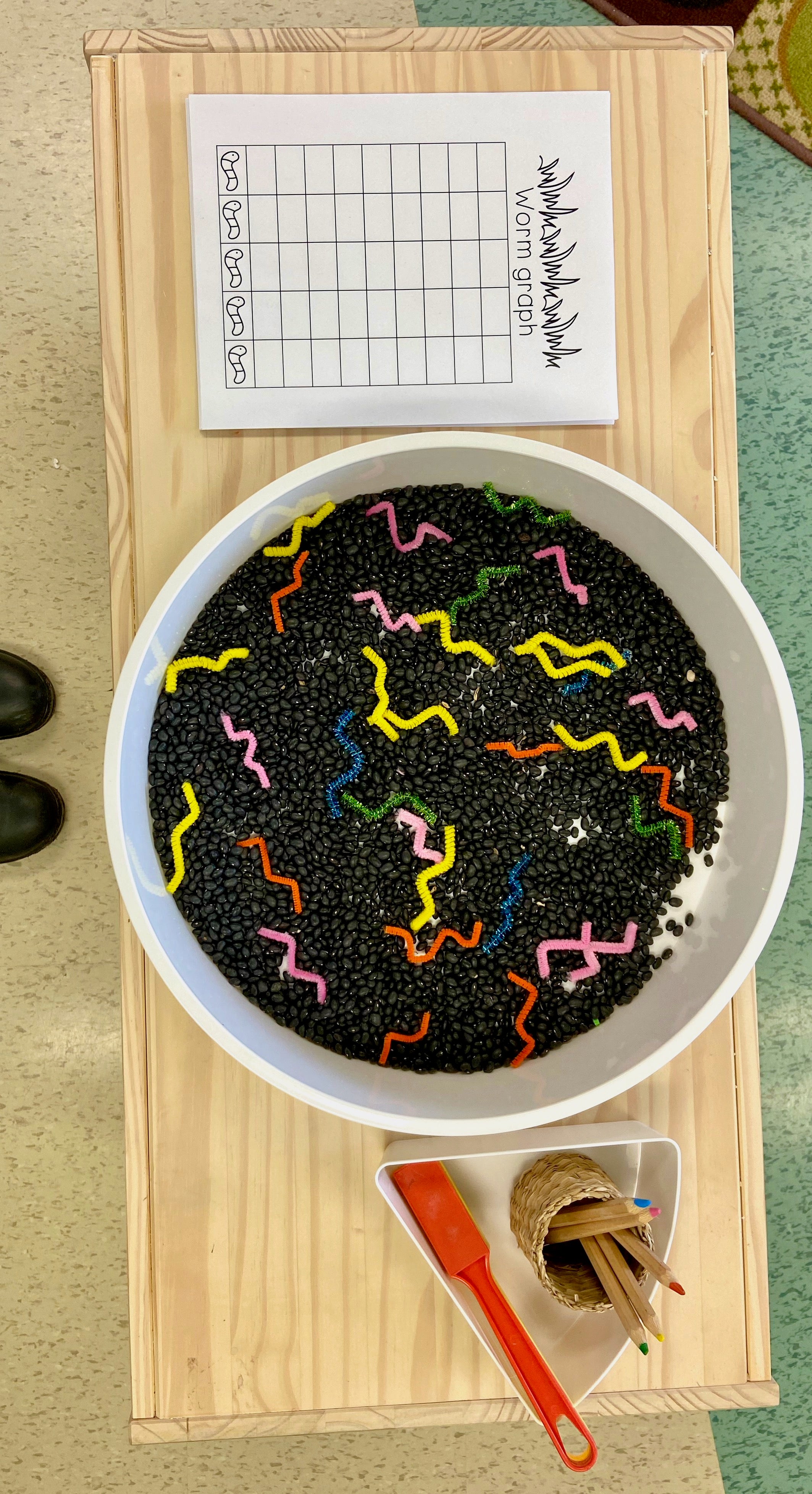

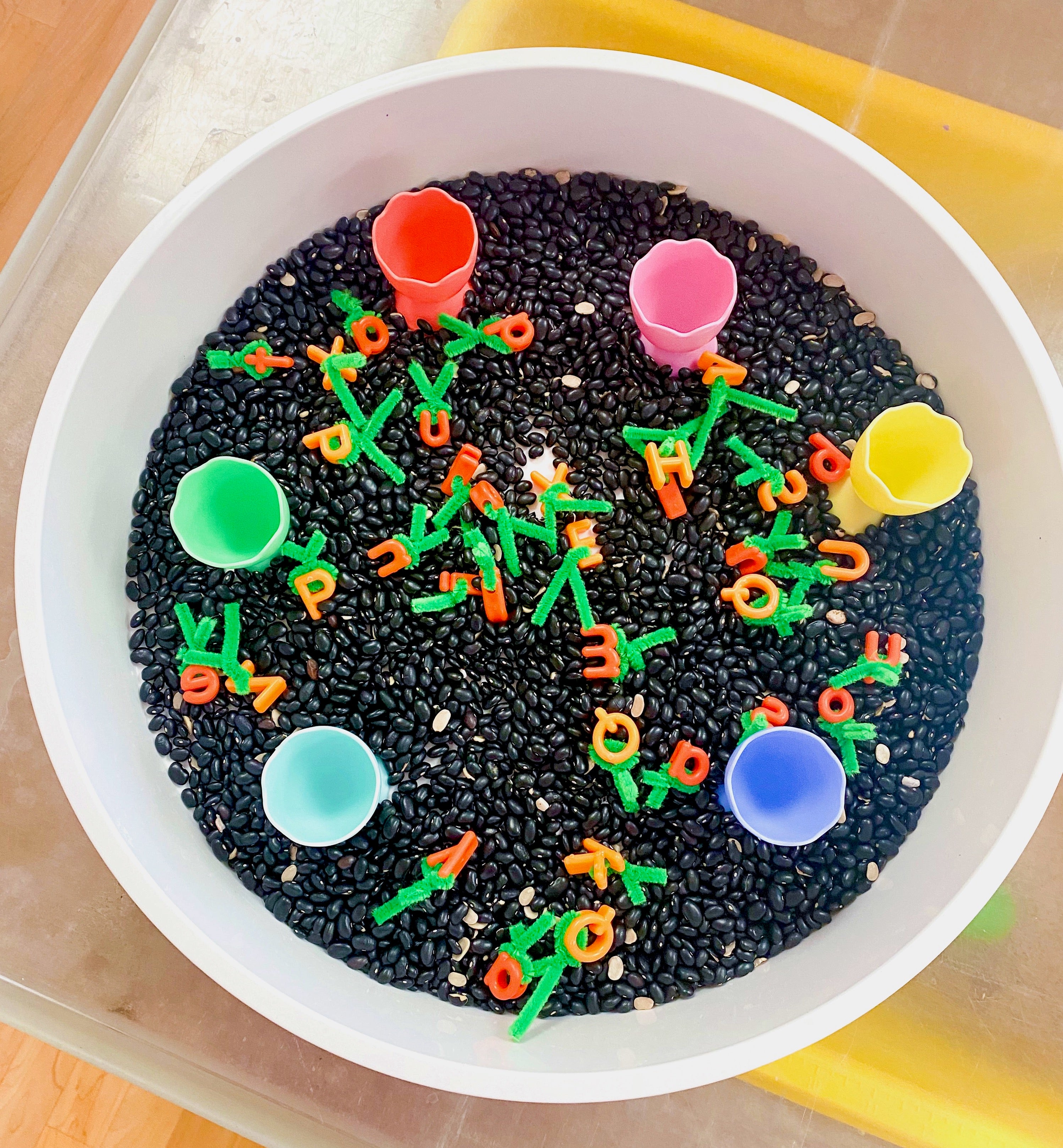



Let’s Grow a Letter Garden
This is a great simple sensory bin for your little learners to explore seeds, planting, letters and high frequency words!
Pour dried black beans in your playtray to act as your dirt! Then sort your alphabet beads so you have all the orange letters and then take green pipe cleaners and thread it through and twist so they resemble a carrot. Add plant pots and gardening tools! Then on your PlayTray lid use a dry erase marker to write high frequency words.
Invite children to plant letters, dig for letters to create words, sort constants and vowels, plant words and more!
Can you help plant and grow a garden?
This is such a fun and easy sensory table for children to explore gardening and planting!
In a container pour in soil and add plant pots, rocks, a trowel, and flowers! Then on the other side add a container of seeds (or beans to act as seeds), more plant pots, a mini rake and a watering can! You can also add insects you would find in your garden or flowers to plant! Encourage children to explore the lifecycle of a plant and talk about the process of growing food and flowers and how we care for them.


Nature Rainbow
As we take children on nature walks they love to collect different treasures that interest them! They are drawn to nature and its bright colours.This activity offers your children an opportunity to get out in nature, use their treasure in art, talk about colour, be creative and play!
All you need to get started:
Rainbow coloured nature items
Cardboard
Sponge brush
Parchment paper
Glue
Take your child on a rainbow colour hunt in your garden or local forest! Bring all your collected items home and sort them into different piles based on their colour.
Find a large piece of cardboard and cut it in the shape of an arc with a flat bottom. On the cardboard with a pencil draw another rainbow arch leaving a few centimeters of space between your arch and the edge of the cardboard and cut out your inner arch to create a template.
Add glue to the outside of the cardboard and then glue it to the parchment paper shape for the inside of your arch template.
From there begin gluing your nature items in rainbow order to create your rainbow! Allow to dry then hang in a window to see the colours shine through.


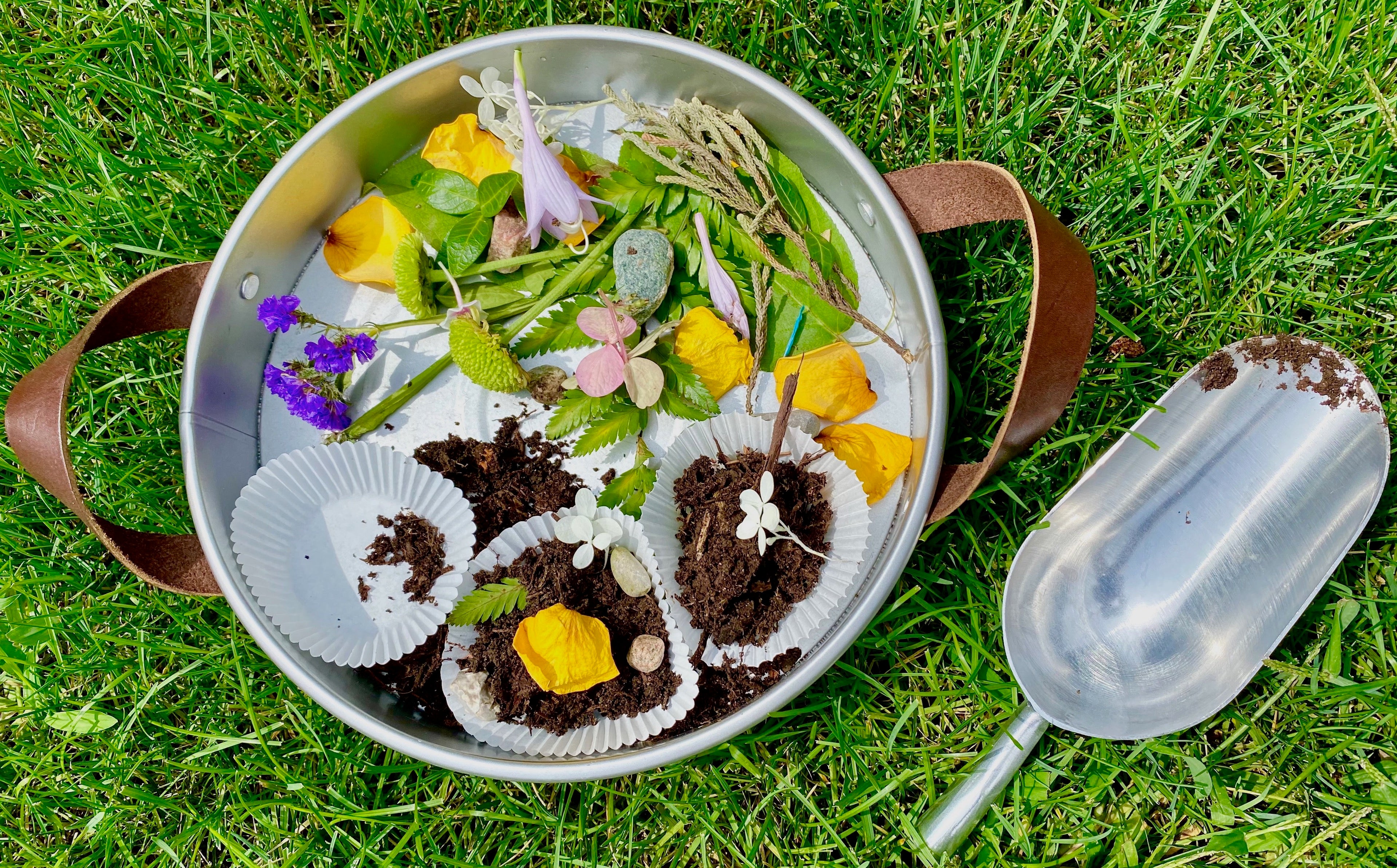

This activity is an easy way to get outside and explore your yard or local community and offer your children an opportunity to be creative and even better is that this activity can be set up in five minutes or less!
All you need is a tray, scoop and some cupcake liners! Go for a nature walk in your yard or local community and collect interesting colourful treasures and place them on one side of the tray and on the other scoop in some dirt and place cupcake liners with them and encourage children to create ✨
Cardboard Camera Nature Snapshots
This is a fun and easy DIY project that encourages children to get outside and explore nature!
Take a piece of cardboard and cut out a rectangle and then trace a smaller rectangle in the middle. Cut out the inner rectangle! Once complete draw extra "camera" pieces you usually see on a digital camera. Take your cardboard camera outside and “capture” different nature shots.
You can encourage children to search for nature items of similar colours, different kinds of trees, animal tracks, habitats and record your findings or ask I Wonder.. questions!
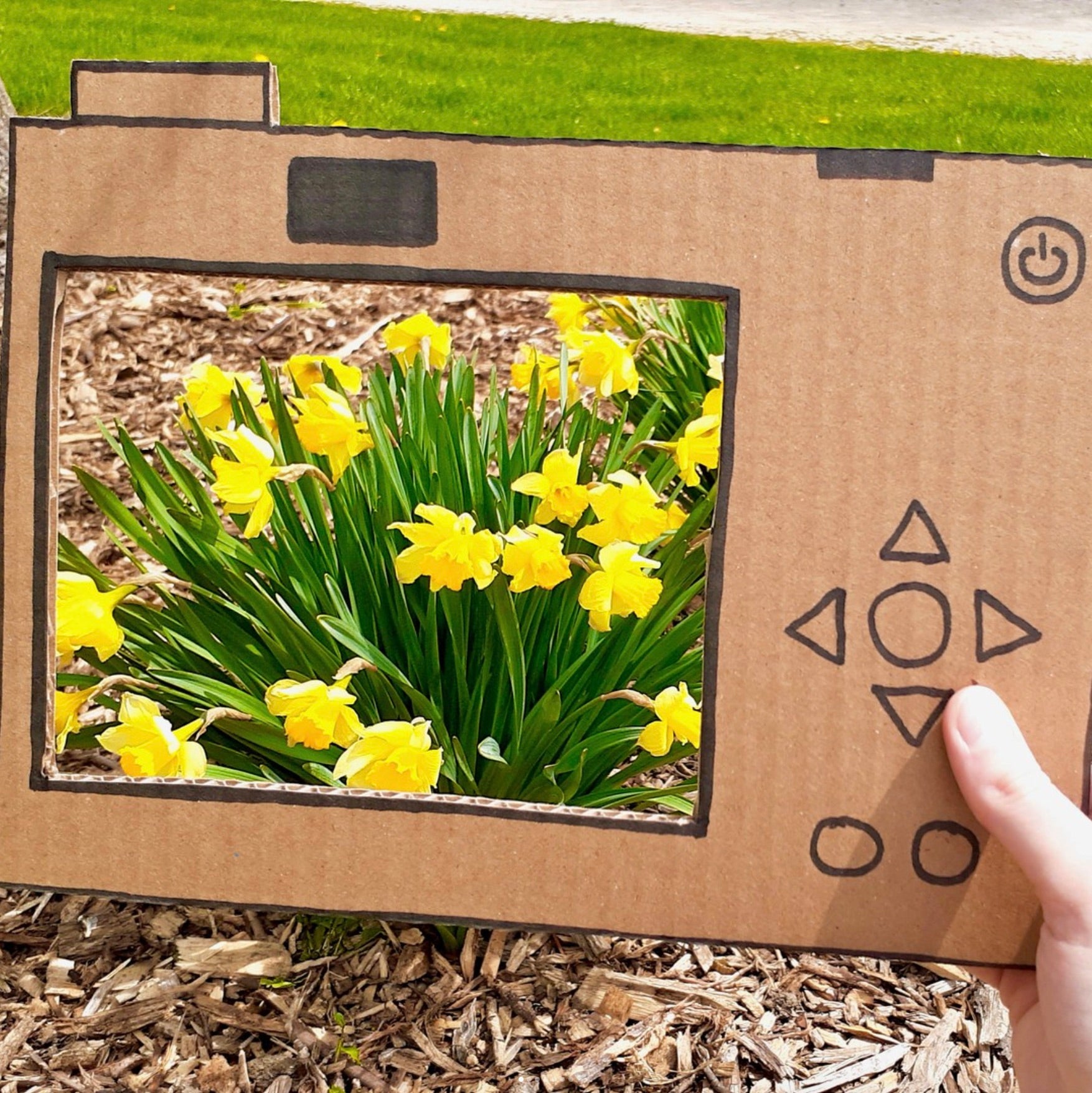

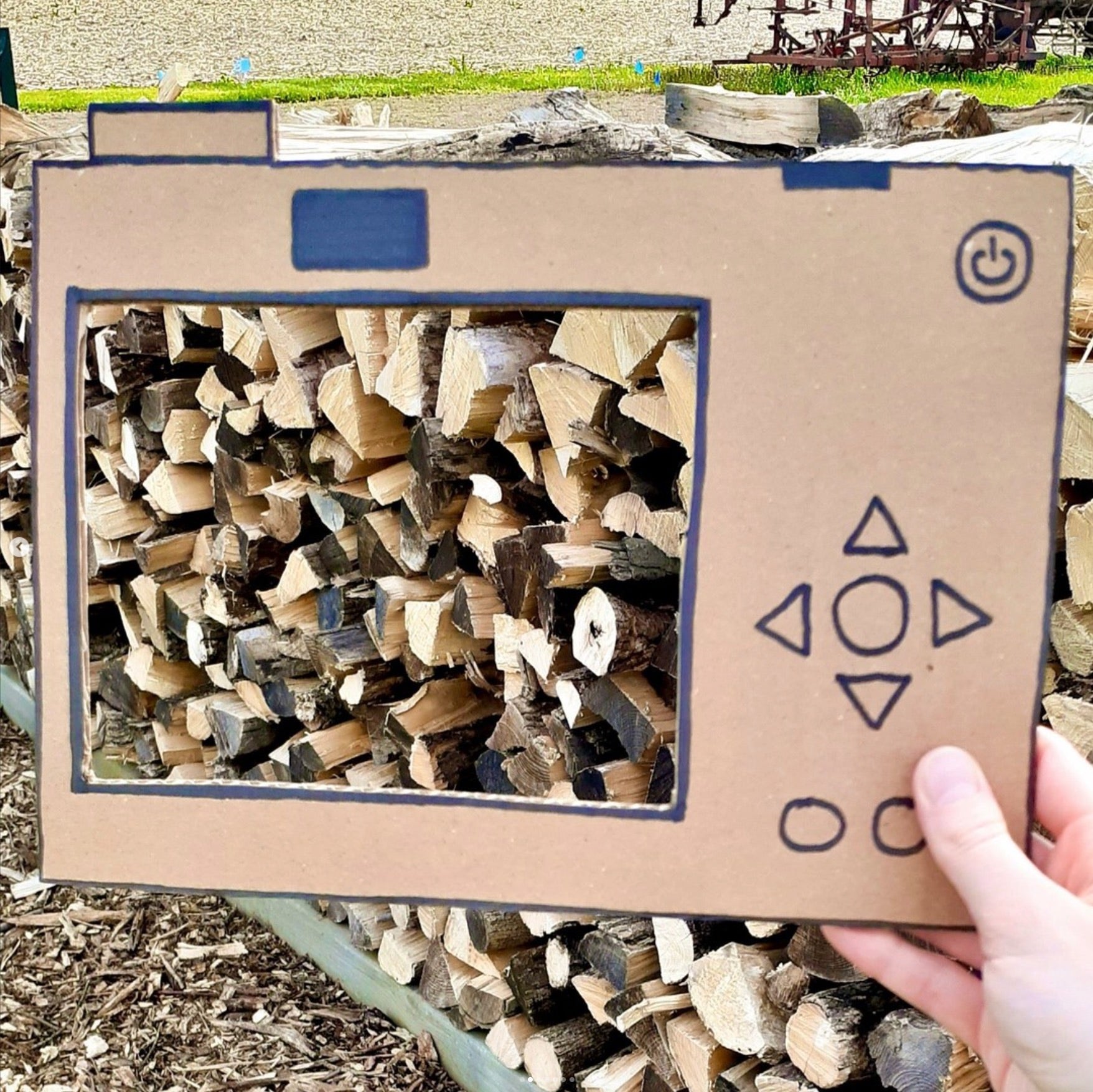

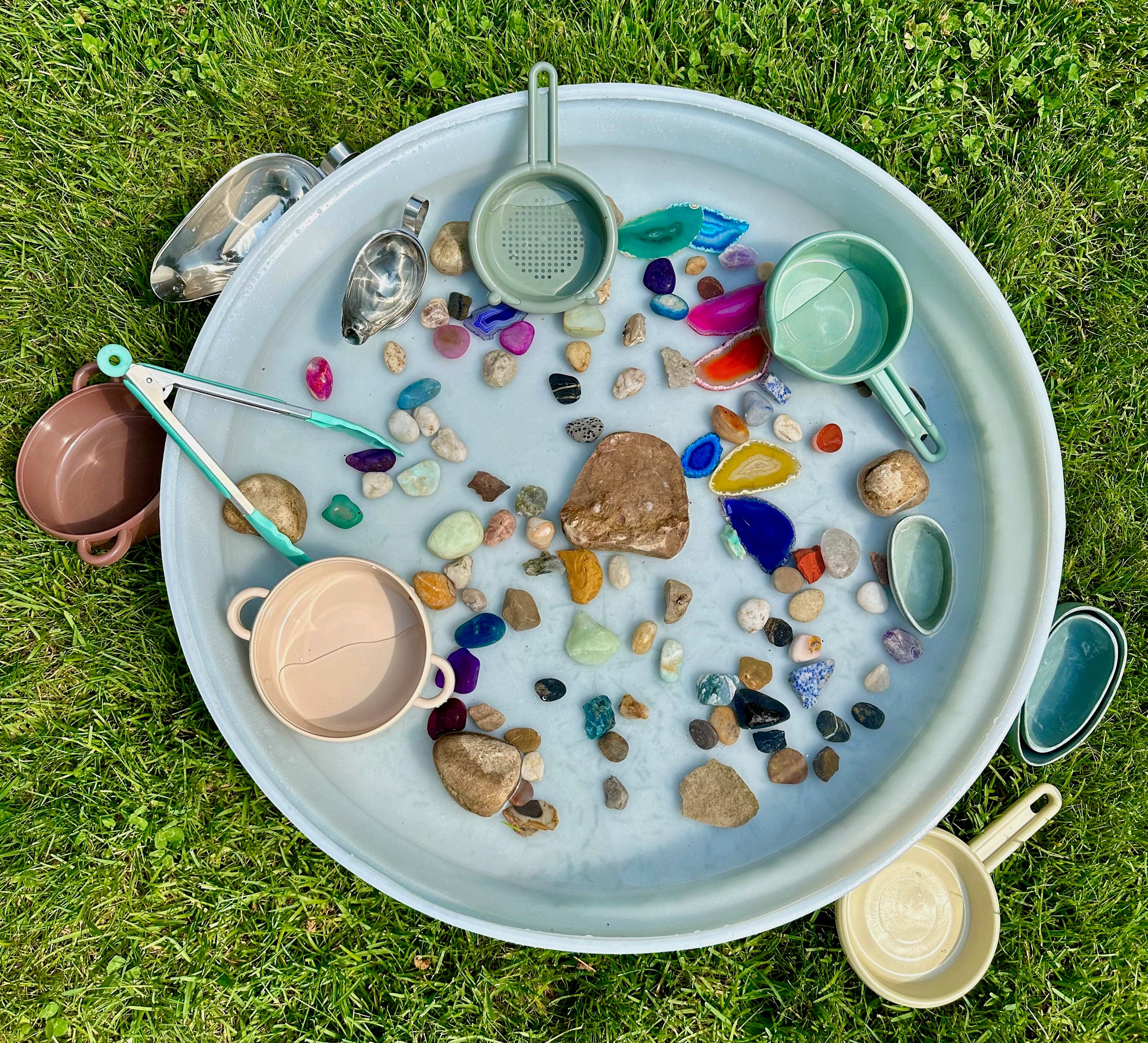

Stone Soup
Children love investigating the natural world around them and often their first choice of nature treasure to take home with them are rocks! They love their unique shapes, colours and designs. This is such a fun and easy water play activity allows them to explore rocks and enjoy mixing up soup.
Go on a nature walk and invite children to collect rocks they find interesting, you can even ask them to bring some from home! Place them all in a deep tuff tray, pour in water and add kitchen tools and allow children’s imaginations to take it from there.
They can mix, measure, pour, scoop and sift through their rocks and even add nature materials!
Can you collect and plant all the flowers in the garden?
This is such a fun and easy tray to help welcome spring flowers and introduce children to gardening!
In the middle of your tuff tray use chalk markers to draw grass and leaves then our potting soil in the middle! Place gardening tools and planting pots around the edge. Add flower stones, faux flowers and insects! Then begin using your tools to start potting and planting your flowers!
Ways to extend the play:
-Identify all the bugs in the garden! Do you see those bugs in your garden? What do you notice about them?
-Can you match the flower stones with the actual flowers?
-Can you identify parts of the flower?
-How do you take care of flowers?
-How much dirt fits in each plant pot?
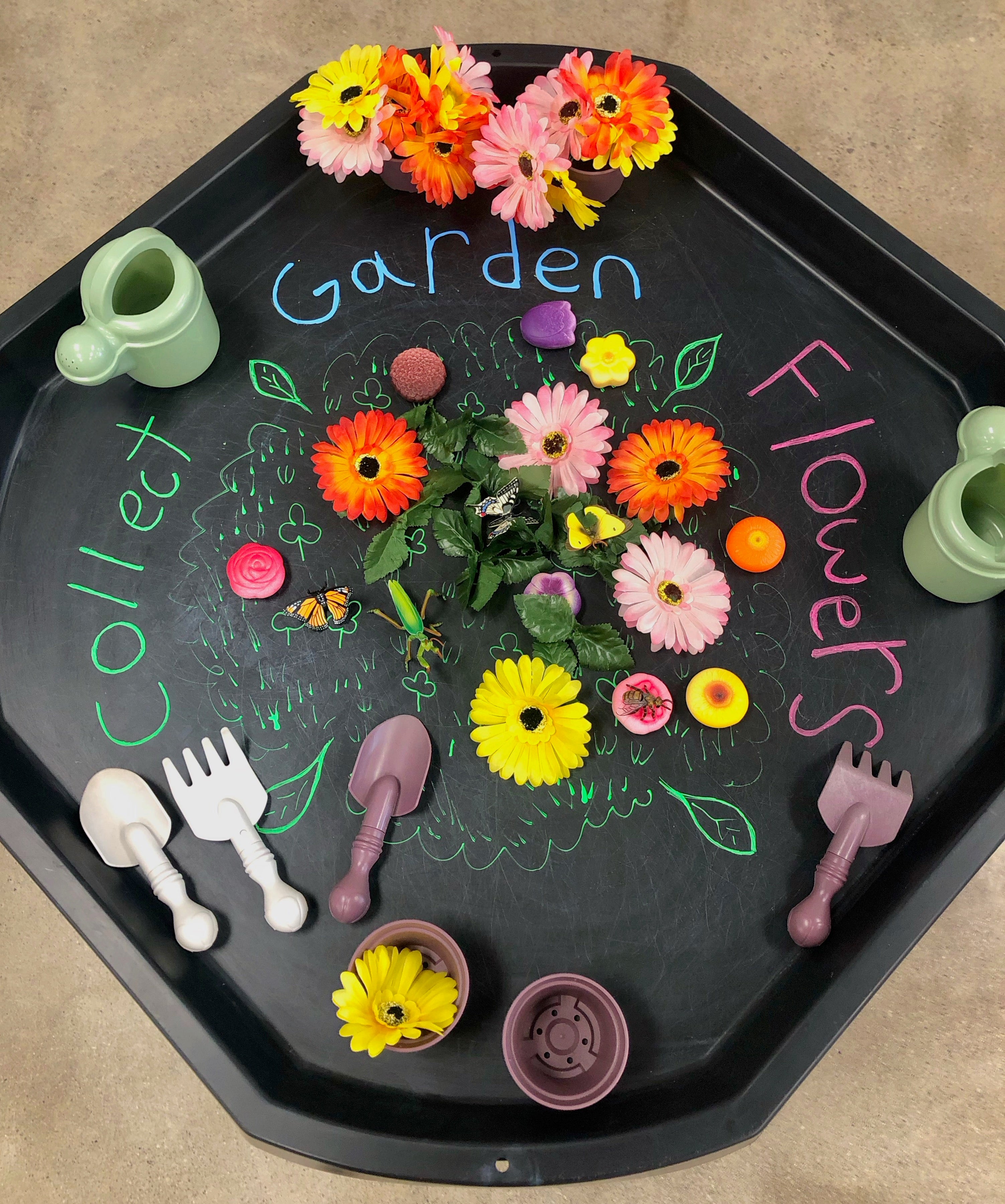



Pond Small World
Let's explore the pond! Children are naturally curious about the world around them, they are inquisitive and love to wonder about nature. This invitation inspired by the lifecycle of a frog and the ecosystem that exists in a pond is a great way to introduce children to the lifecycle and its different stages!
In your tuff tray begin crafting your pond habitat using nature items collected from your local community or a nature walk! To begin, lay down blue play scarves to simulate water and then add grass, rocks, leaves, branches, nature inspired loose parts and small world pieces to create your habitat. Then add all the bugs and insects you would find in a pond. Invite children to explore, play and tell you what they notice.
Ways to extend the play:
-Talk about what animals live in the pond
-Identify the lifecycle of a frog and what they do for the pond ecosystem
-What plants do you see? What grows in a pond?
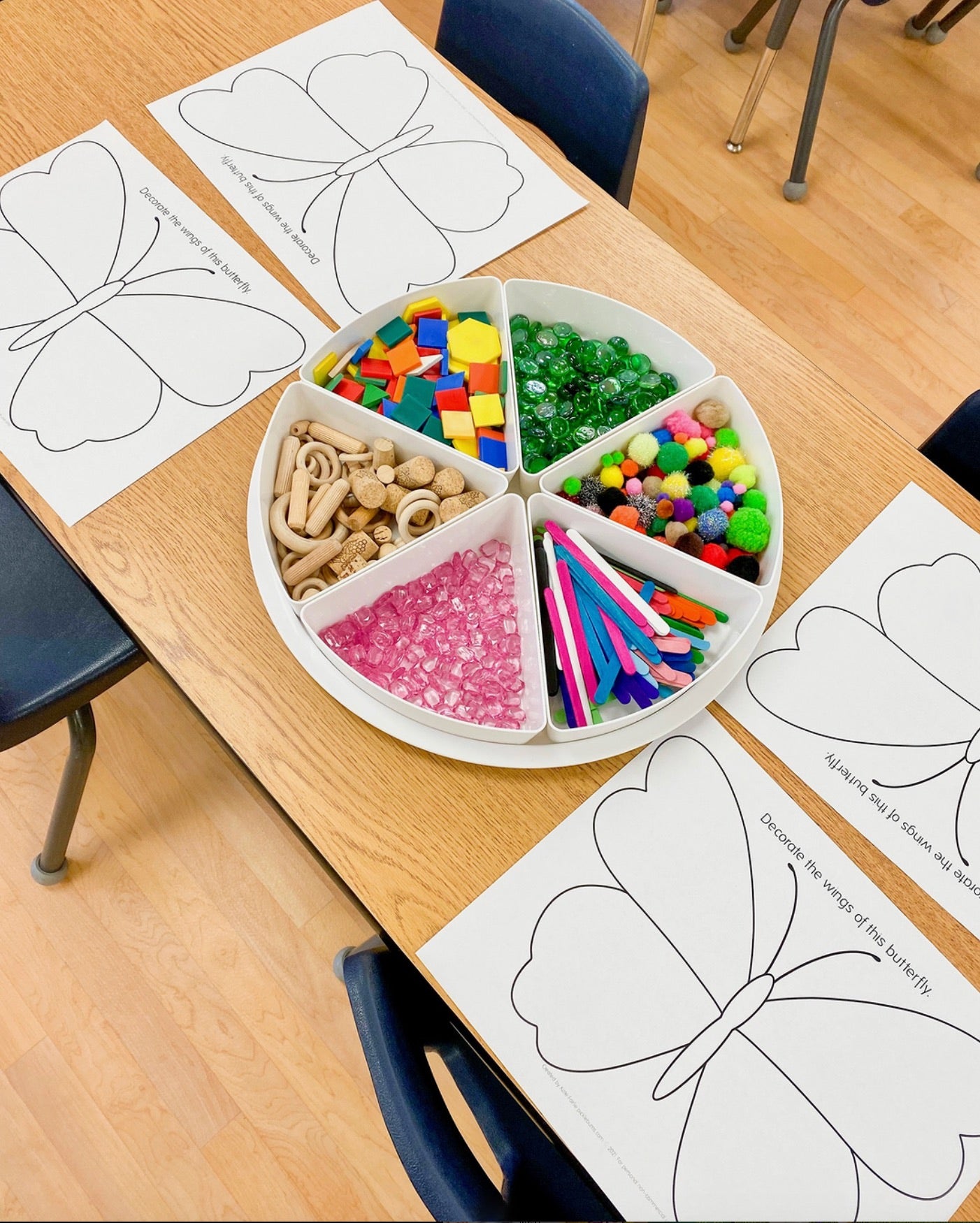

Loose Parts Butterflies
Can you design wings for your butterfly? This is such a fun and easy loose parts invitation that gives children an opportunity to be creative and explore early math concepts!
Simply print off a photo of a butterfly and offer it to each of your students. Fill your playtray compartments with all kinds of loose parts and craft materials to support their creativity. Invite them to create!
Ways to extend the play:
-Explore symmetry, create symmetrical butterfly wings
-Invite them to create a design with a certain amount of loose parts!
-Invite them to make designs using a certain number of shapes!
Let's Collect Pollen
This is such a fun and easy way to investigate how bees transfer pollen from flowers to their hive!
Take different coloured pieces of construction paper and cut out the shapes of flowers and then take yellow paint and pour it in the middle of the flowers to be your pollen! Then go online and print out a paper bee hive for children to transfer their pollen to. To help transfer the pollen wrap a black pipe cleaner around your finger to create the shape of antenna and then they can gently dip the atenna in the paint to transfer the pollen to the hive!
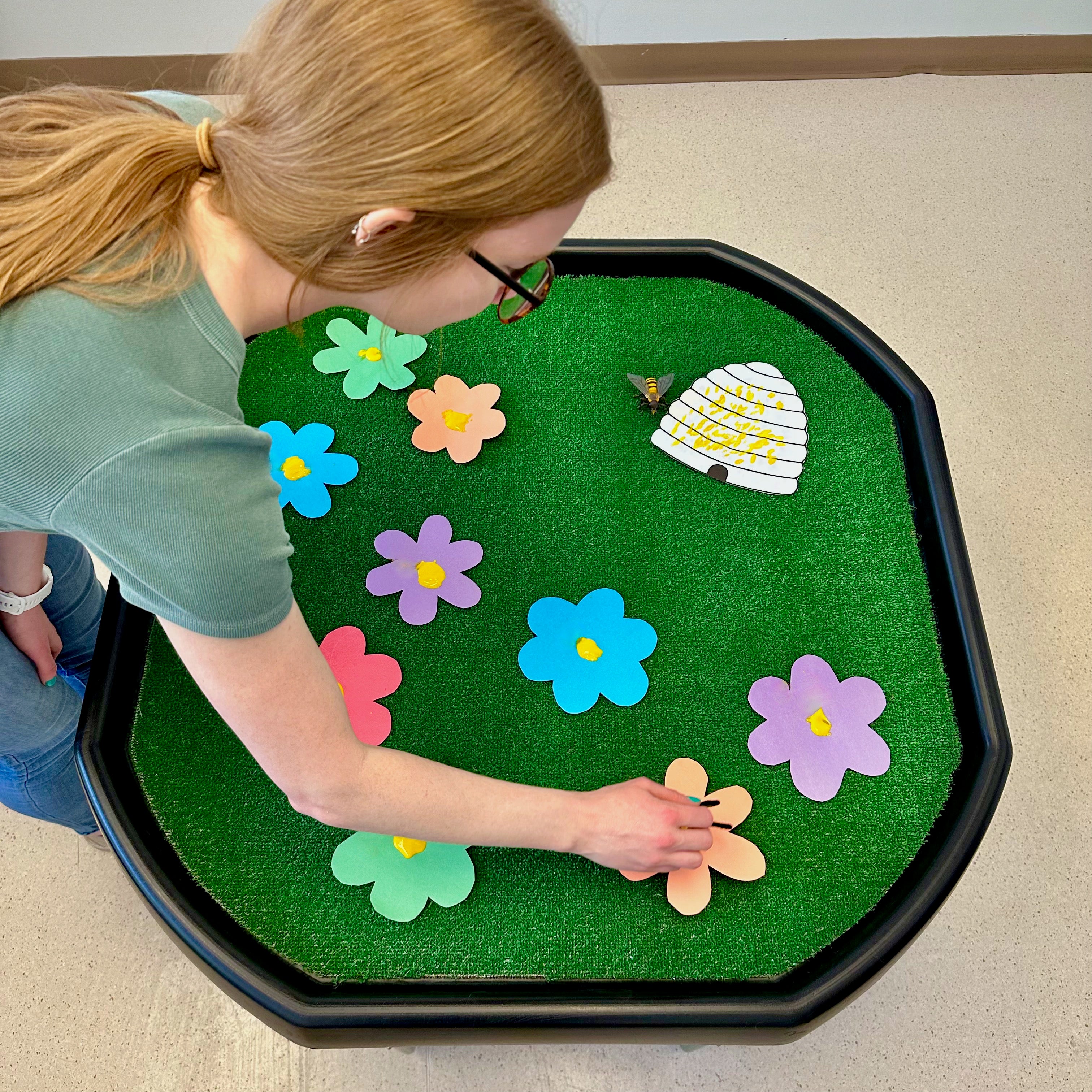

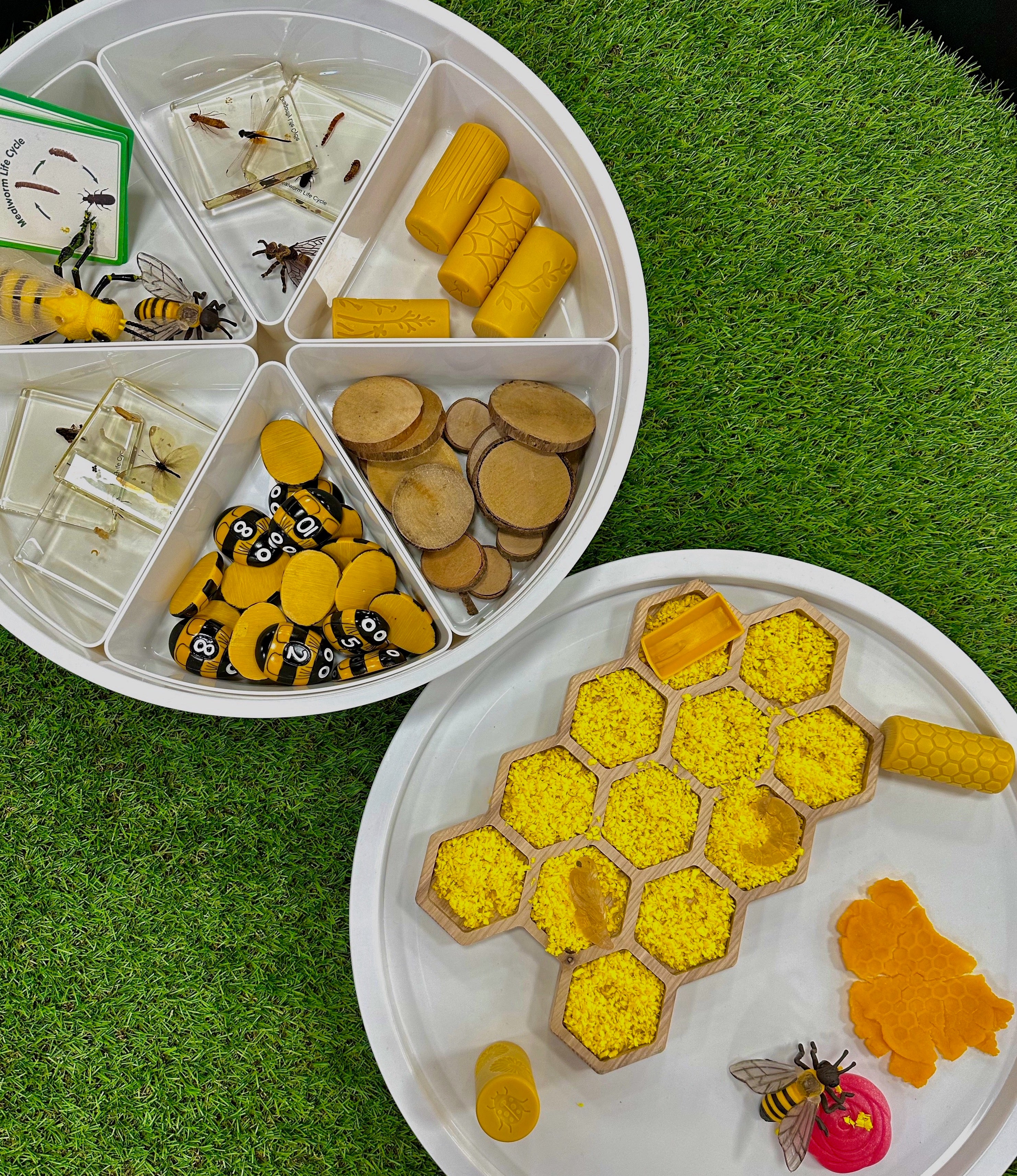

Where do bees come from?
Let’s explore the lifecycle of bees and investigate bees and their purpose in nature! This invitation allows children to explore the lifecycle in many ways.
In a playtray add wood rounds, gardening gloves, some playdough, wow sand, honeybee counting stones, life cycle of the bee, and a book about bee’s!
Allowing the children to scaffold and continue to explore in depth and but then also allowing our younger toddlers still the opportunity to learn and explore this life cycle by asking opening ending questions like:
-What do we think bee’s make?
-What do bees look like?
-What would happen if we didn’t have bee’s?
-Do you think bee’s have eyes and legs?
Process Art Watercolour Flowers
Spring has sprung, so lets create a unique boquet of watercolour flowers!
All you need:
-Coffee Filters
-Pipettes
-Pipe Cleaners
-Liquid Watercolour Paint
Take a coffee filter and gently flatten it out on a tray! Pour liquid watercolour paint in paint pots and add your pipettes to the paint. Begin using the pipettes to cover the coffee filters with paint, you can create designs, mix colours or splatter art! Then allow your coffee filter to fully dry. Once dry, fold your coffee filter in half, and in half again. Then gently twist the bottom and then take a pipe cleaner to act as your stem and twist it arond the end. Once your stem is created trim it to fit in your vase!
Then you will have a unique and colourful spring boquet of watercolour flowers.
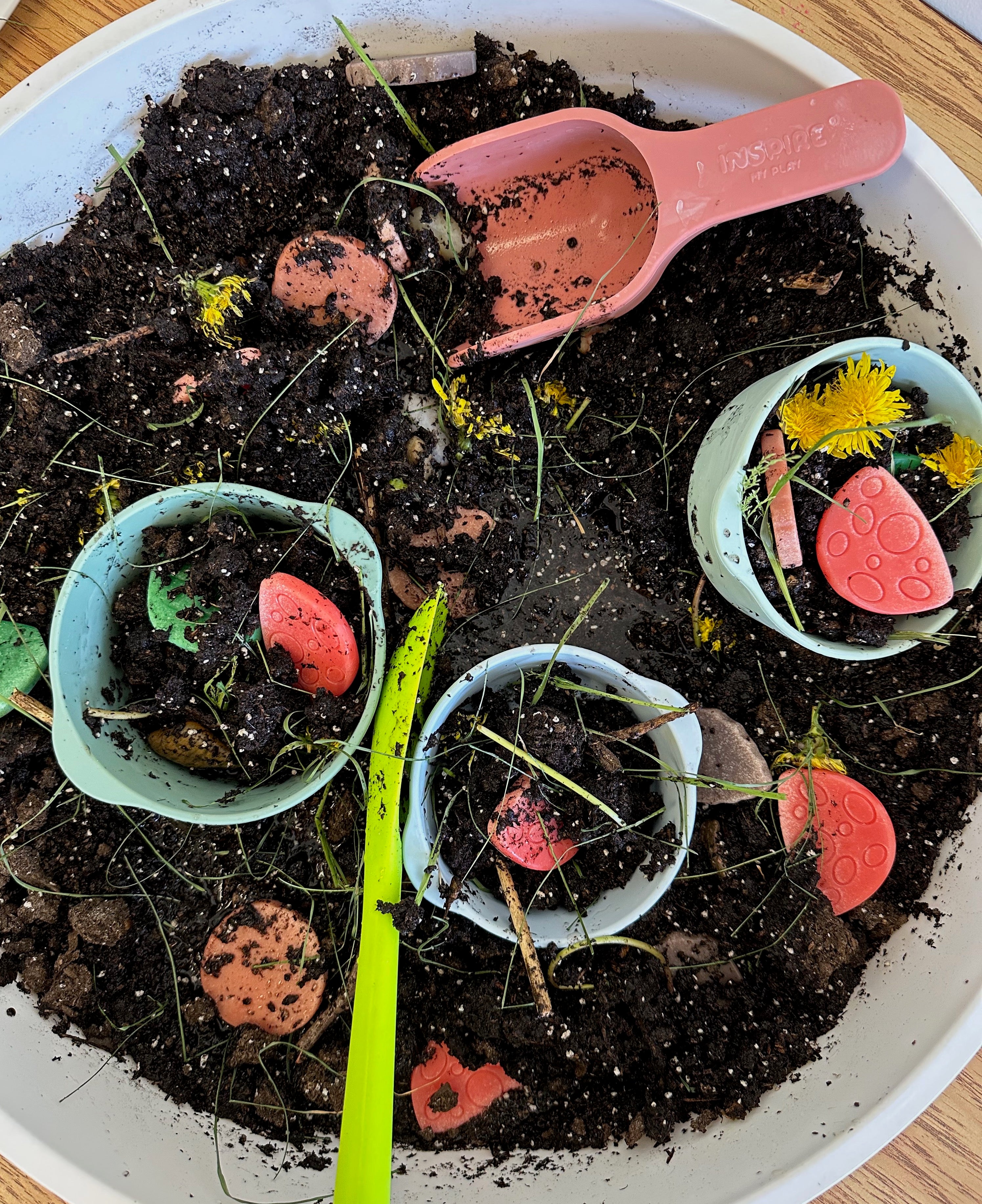

Go on a nature walk in your community and begin collection dandelions, grass, rocks and other ingredients for your soup!
Once you have your ingredients add them to your playtray compartments and add dirt or potting soil and water then mix! Add bowls, sieves and scoops and then begin mixing in your ingredients.
Invite children to scoop, pour, measure, mix, and explore.
What does spring look like to you?
This activity offers an opportunity to go outdoor, explore and then be inspired by nature and spring! You can mix loose parts and natural items you find on a nature walk to decorate and create your tree!
For this activity all you initially need are sticks and branches to form the shape of the tree (you can also provide a photo of a tree for reference)! From there, offer different materials to decorate your tree inspired by spring.
-Invite children to use loose parts and nature items to recreate things they observed or associate with spring (birds nest, mushrooms, flowers, blossoms)
-Talk about what happens in the season when spring starts?
-What colours do you associate with spring?
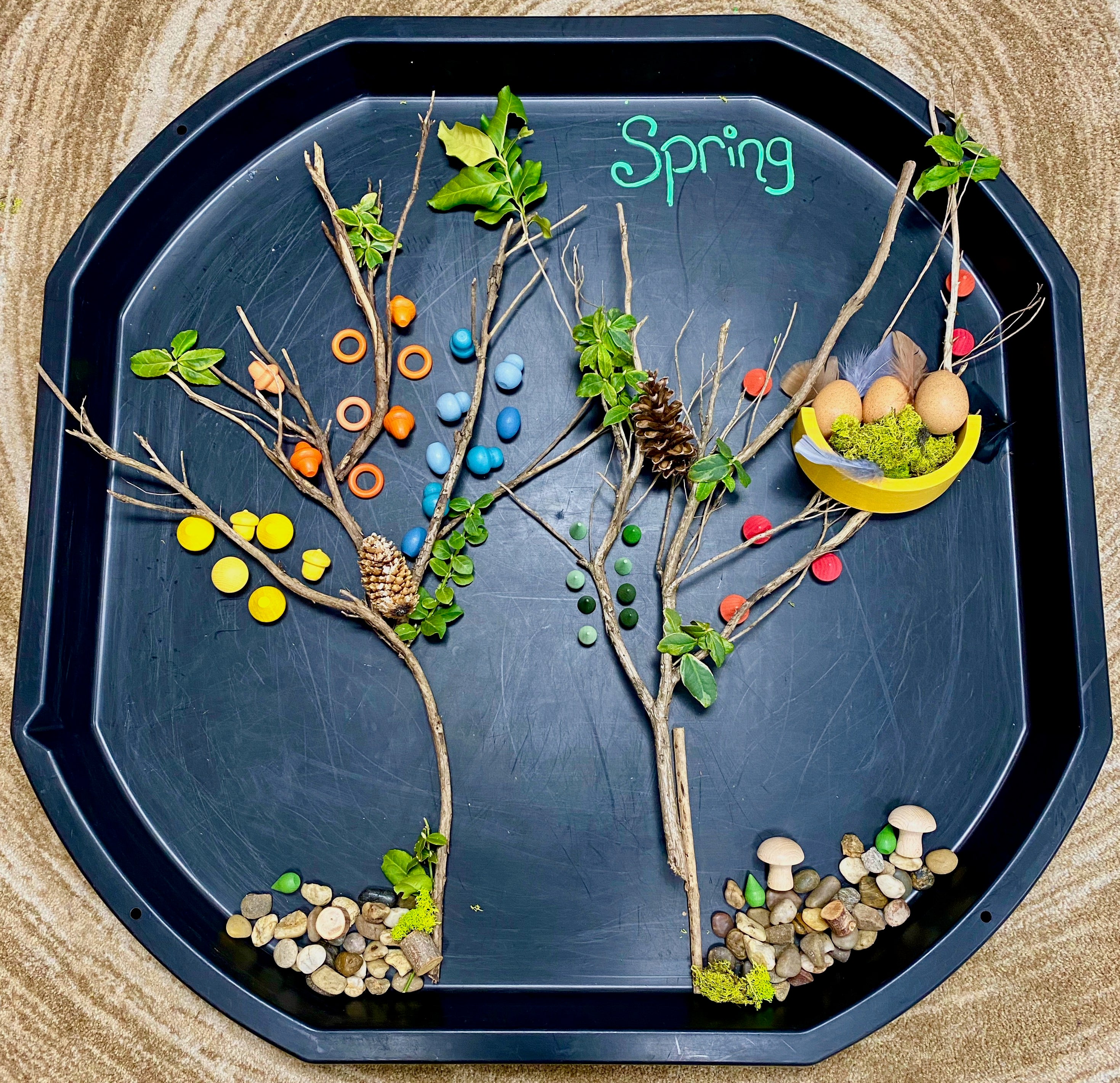

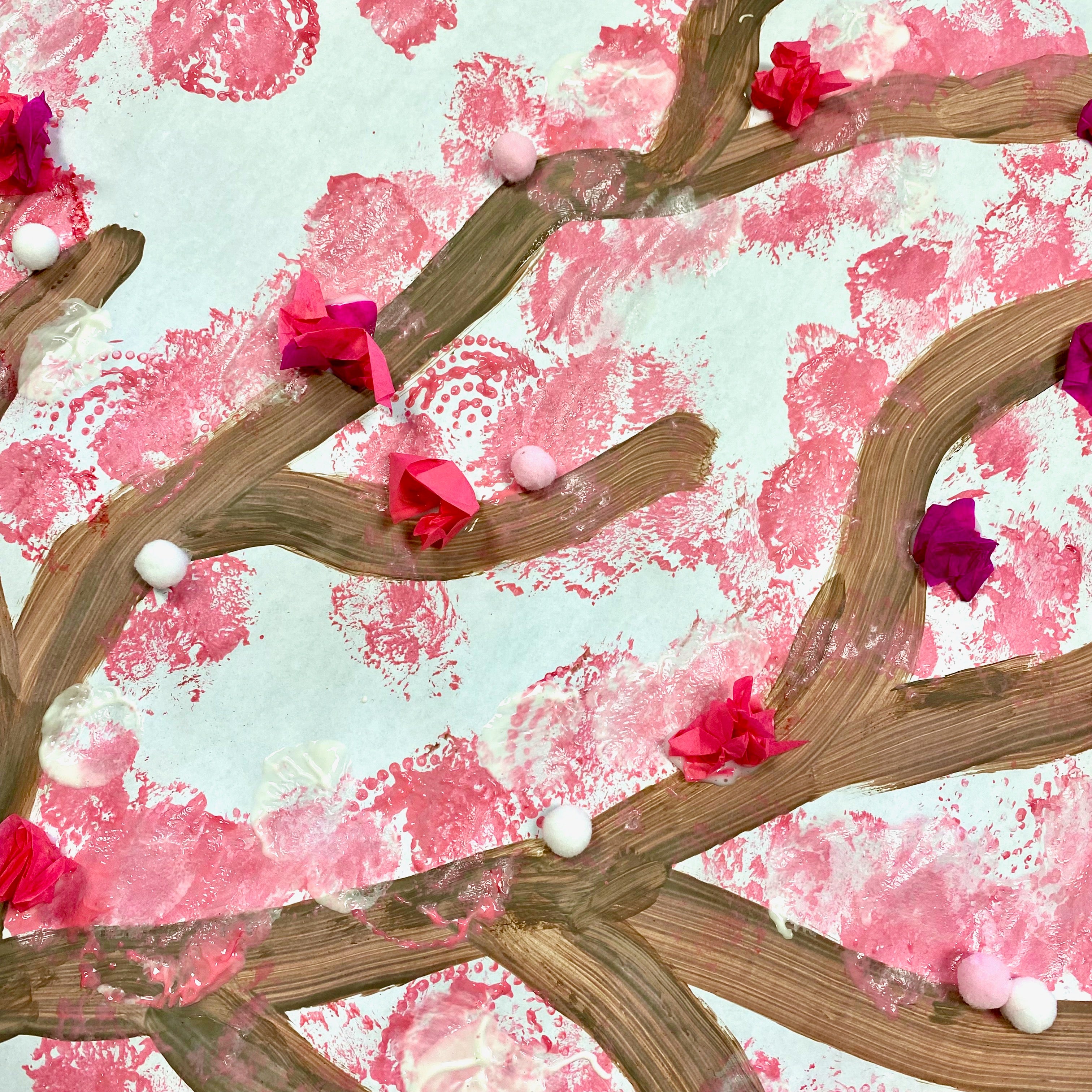

Process Art Co-Create Cherry Blossom Tree
Cherry Blossoms actually have an important significance in Lunar New Year Traditions! Cherry blossoms represent new beginnings and a renewal of life. And because they have long branches, they also represent longevity.
This easy process art co-created inspired activity is a great opportunity to collaborate and be creative but also celebrate Lunar New Year!
Cut a large sheet paper to the size of the bottom of your tuff tray and secure it with tape! Using brown paint, paint the shape of your tree. Then mix red and white paint together to form pink for your blossoms. To create blossom shapes secure a pom pom to a clothespin and gently dip it in the paint and begin dabbing along your branches! Repeat with white paint! Then add small white and pink pom poms to represent blossom buds and the beginning of renewal. Gently scrunch pink tissue paper to create 3D blossoms and dip them in glue and place them along your branches!
Then you will have a beautiful mixed media cherry blossom tree!
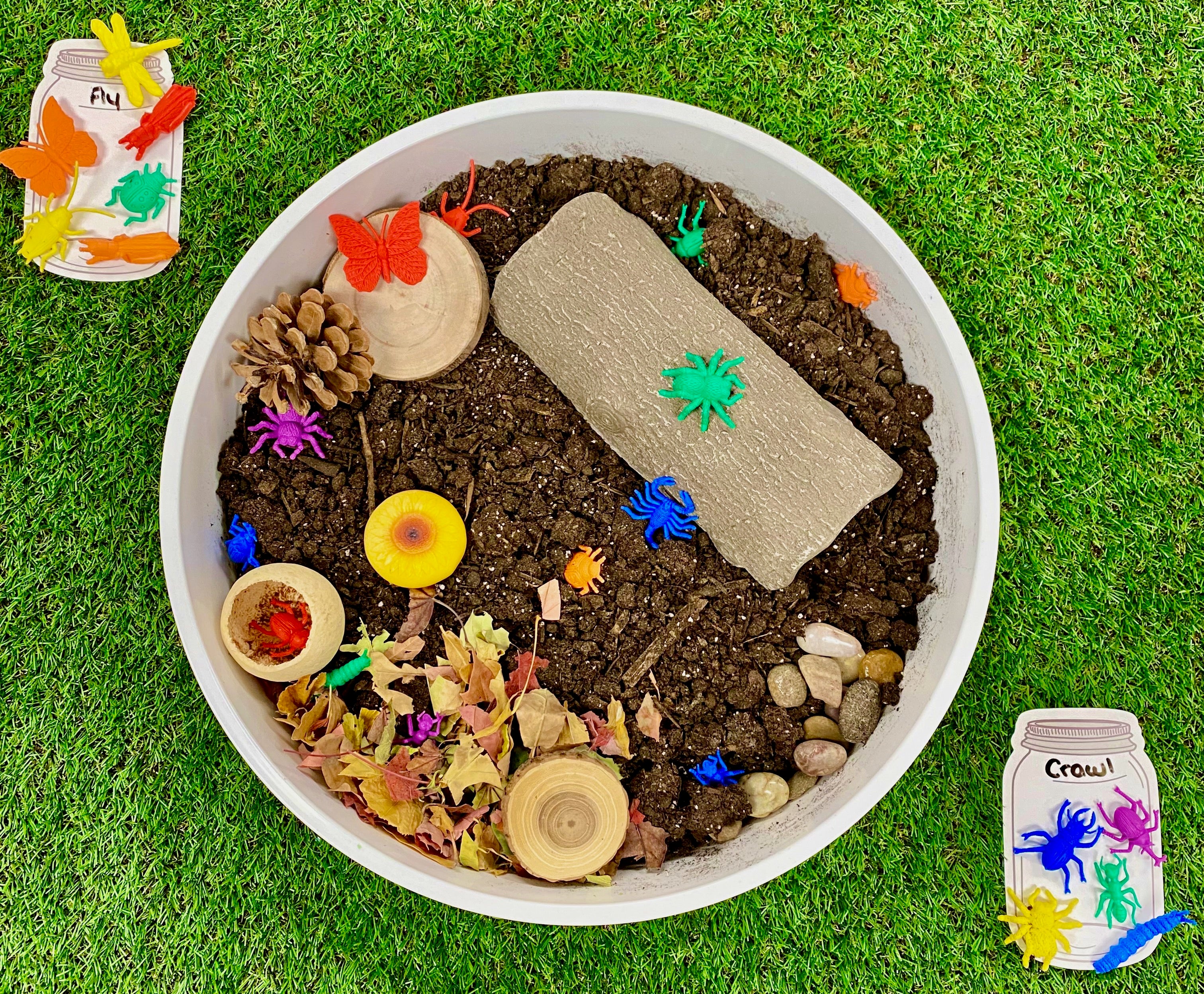

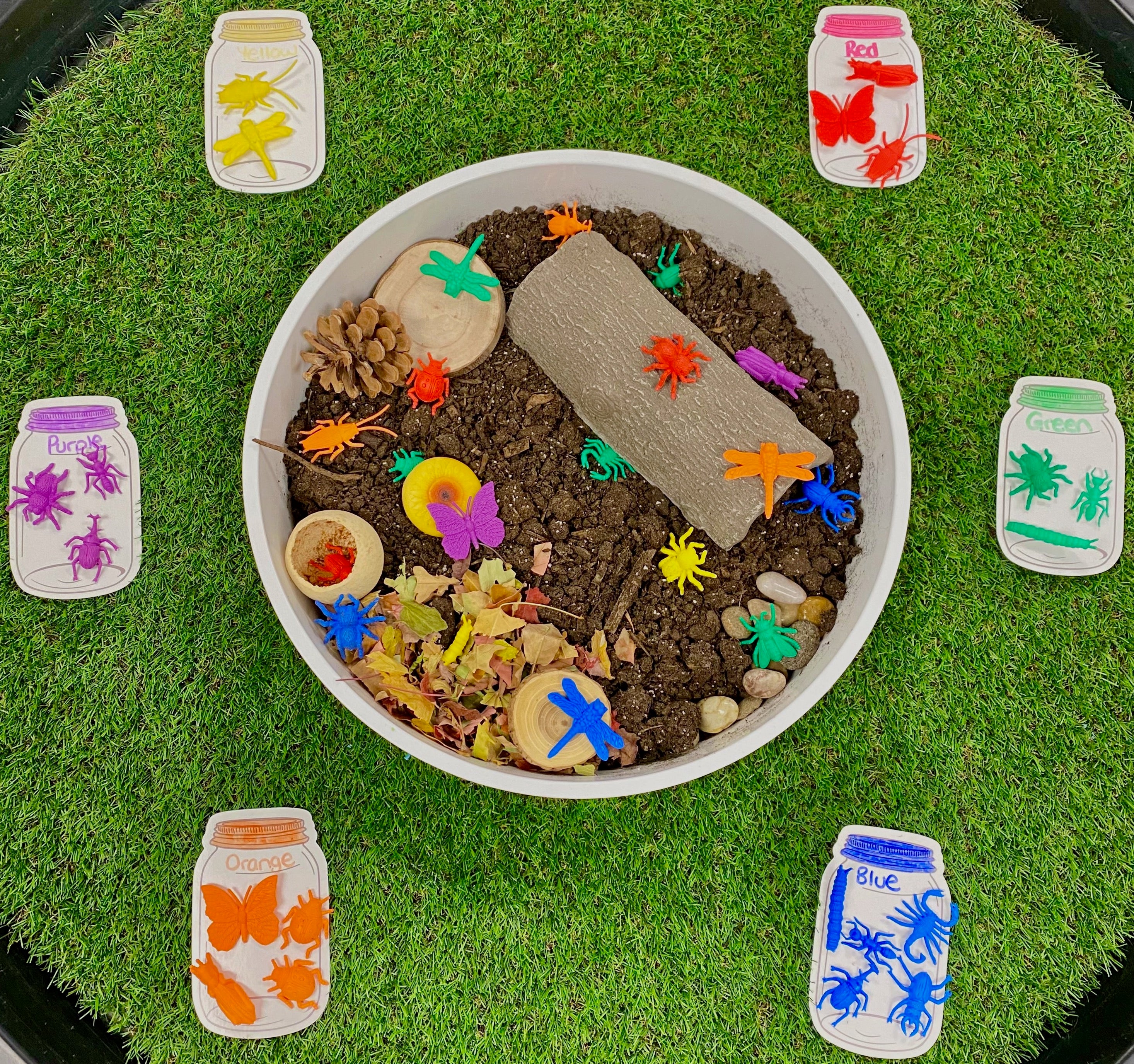

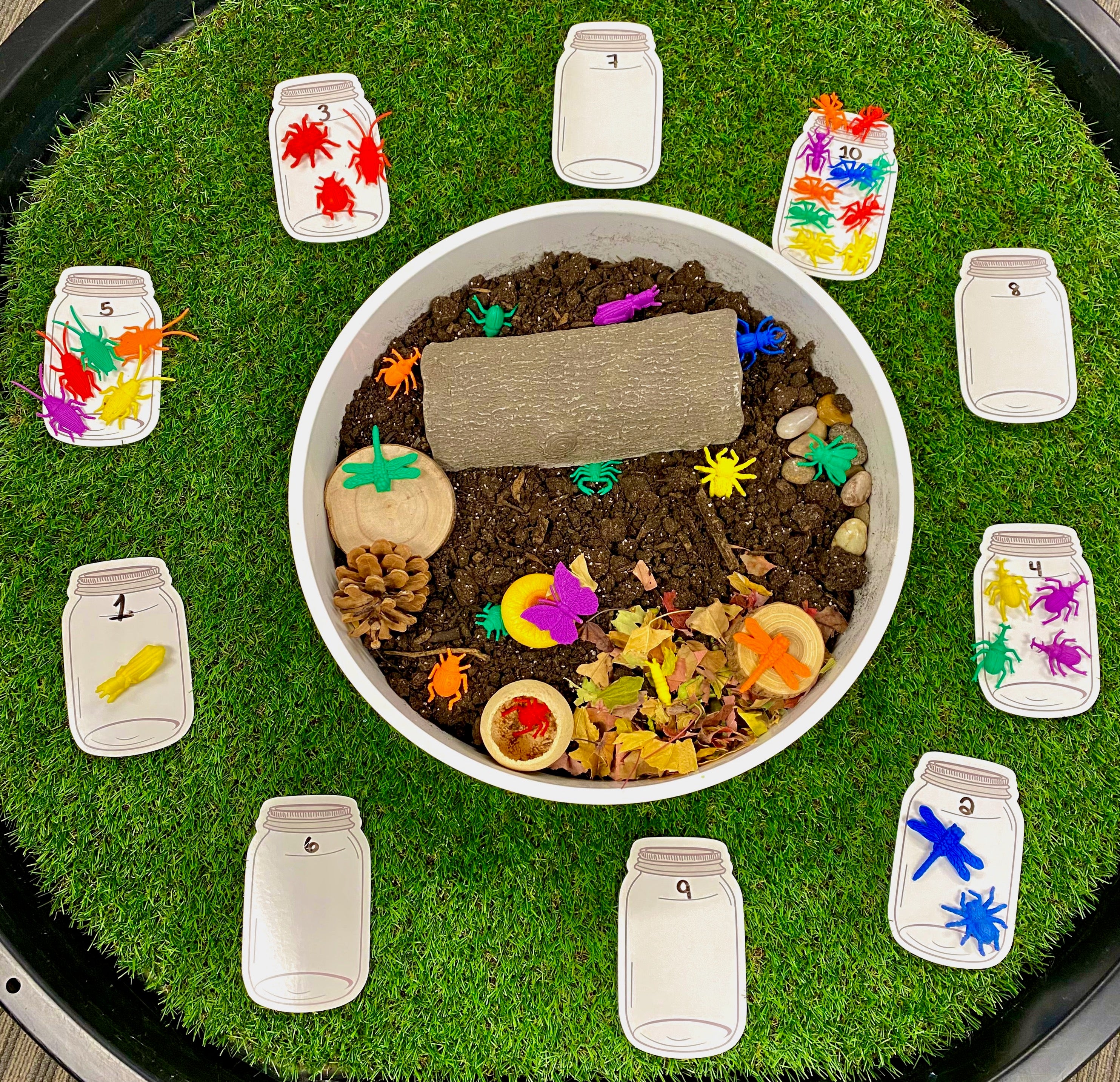

Discover the Bugs 3 Ways!
Can you capture all the bugs in the garden and sort them three different ways in all the jars? Sort by do they crawl or fly? Can you sort them by colour? Can you count and sort them.
Pour a layer of potting soil or dirt in your playtray and add natural materials (wood rounds, leaves, pinecones, stones, etc) to create a garden. Then hide your bug counters all through the tray for children to discover! Once you have created your bug small world garden place it in a tuff tray and add mason jar cut outs with the lids labelled to help to encourage sorting.
Watch as your flower bloom as you place them in your pond! How colourful are they all as they gently unfurl.
On your computer find a printable colouring sheet of a flower and print off multiples! Encourage children to colour the flowers all kinds of bright colours then cut them out! Gently fold each petal towards the middle and then fill a sensory tray with water and dye it blue. When ready, place them in the pond and watch them bloom!
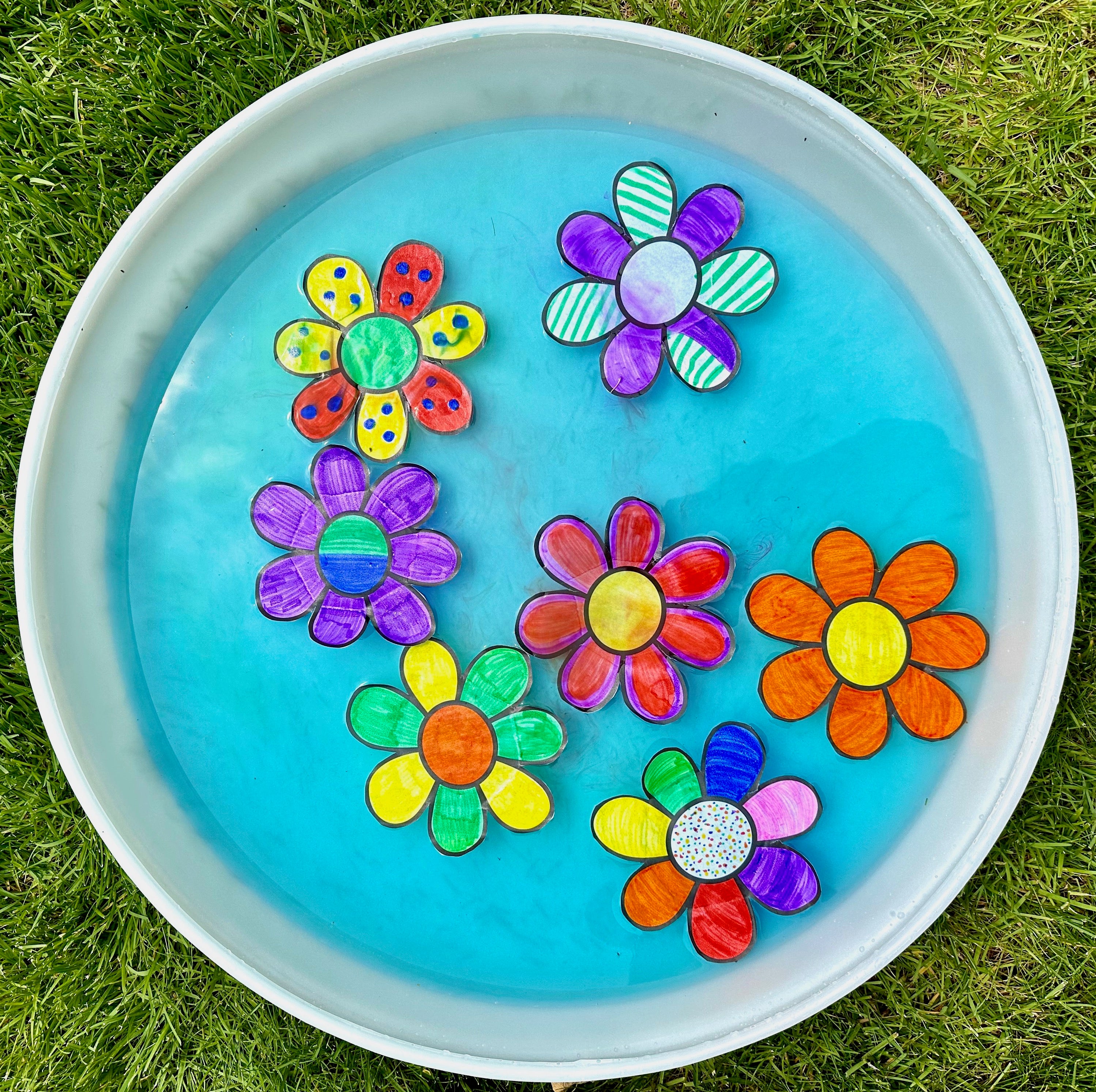

Coffee Filter Butterflies
This is such a fun and easy process art activity that will have you create an entire unique flock of colourful spring butterflies.
All you need:
-Coffee Filters
-Pipettes
-Pipe Cleaners
-Pony Beads
-Liquid Watercolour Paint
Take a coffee filter and gently flatten it out on a tray! Pour liquid watercolour paint in paint pots and add your pipettes to the paint. Begin using the pipettes to cover the coffee filters with paint, you can create designs, mix colours or splatter art! Then leave your coffee filters to dry. Once dry, begin folding your coffee filter back and forth to create your butterfly wings. Once fully folded pinch the middle and grab a pipe cleaner and create an overlapping half circle and place the wings in the middle. Then gently twist the bottom and twist the top to form the body, add beads on the top part of the body and gently bend the pipe cleaners to form antenna. Take your coffee filter on either side and gently spread the coffee filter to act as wings!
Soon you will have an entire flock of unique and colourful butterflies!
Nature Rainbow
This activity is a great way to get out with your children and explore your local neighbourhood or backyard for a scavenger hunt for colour themed nature treasures!
Simply take your sidewalk chalk and draw a rainbow and encourage children to find different nature pieces of all the colours that match the arches.
This activity is a great way to talk about:
-Identifying different colours and shades
-Talking about what nature items you have found: flowers, leaves, stems, etc
-Build fine motor skills as they place thier treasures on the arches
-Talk about how we see some of more colours than others in certain seasons!
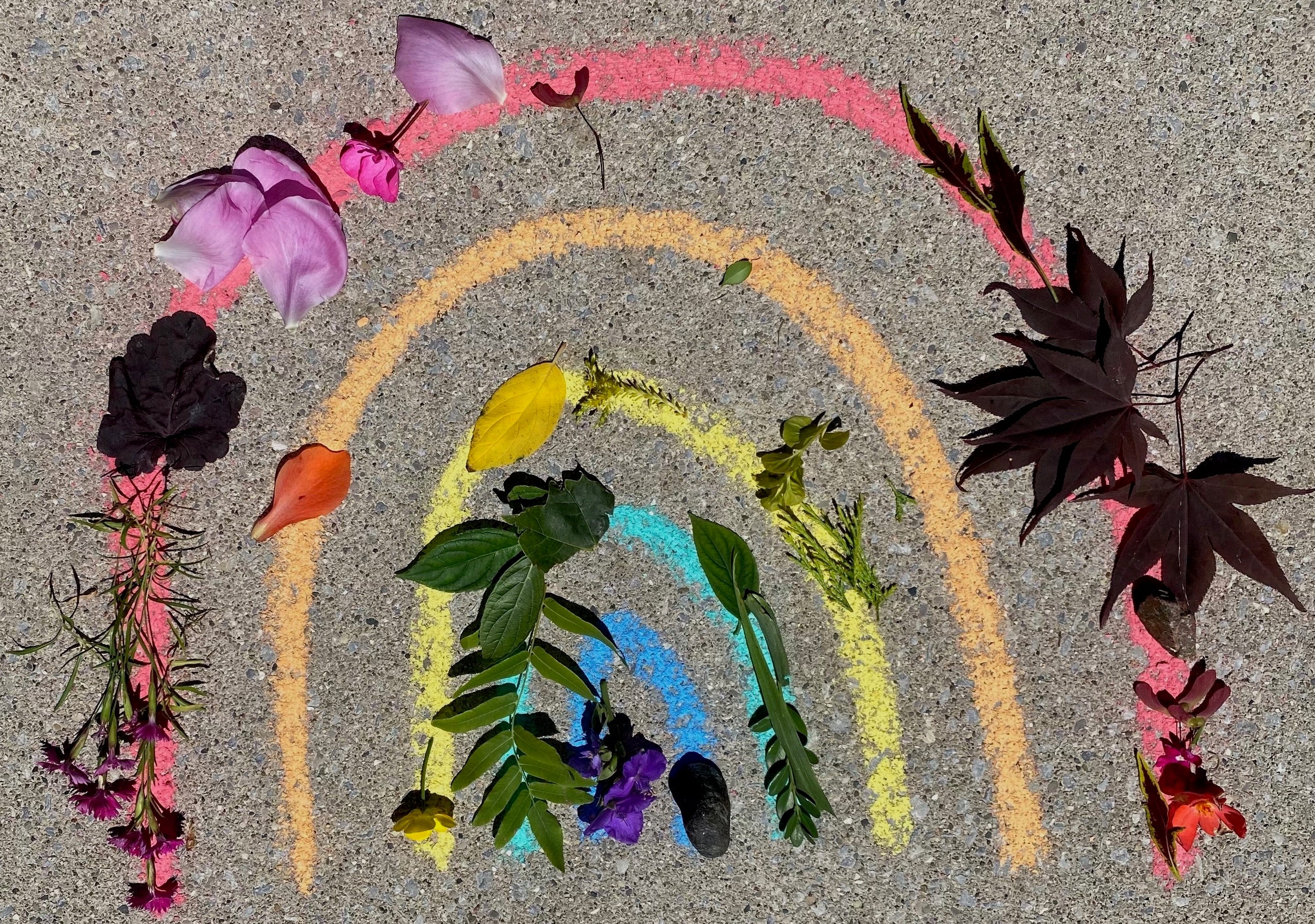

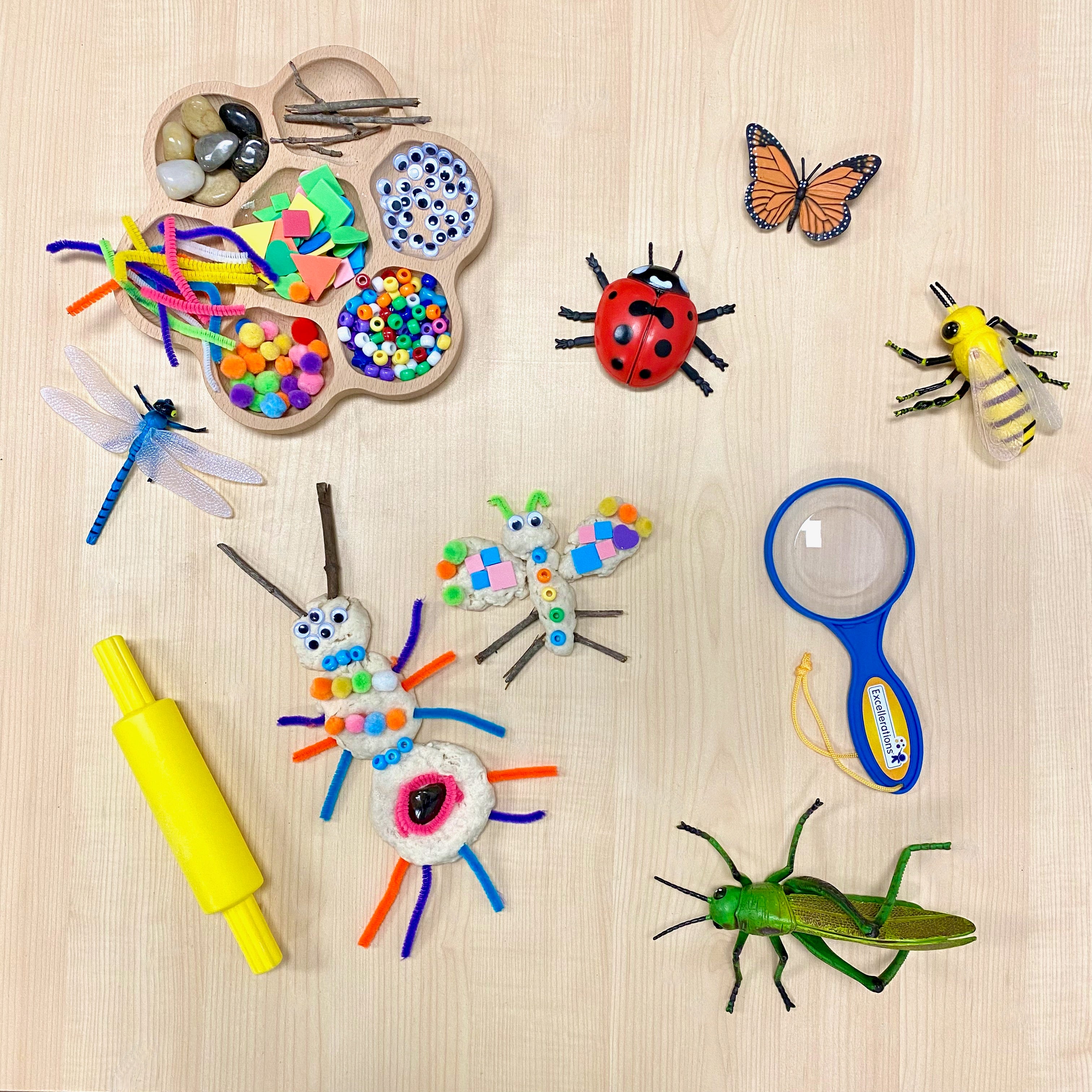

Can you create your own insect inspired by insects we see in our gardens? Children are fascinated by bugs and love to look at them up close so this inquiry invites them to either recreate a bug they know or be creative and make their own!
To extend the learning ask children to describe their bug and name it! Identify its distinguishing features; how many legs does it have? how many eyes? does it have wings to fly? what colours is it?
In tray offer play dough, dough cutters & tools, loose craft pieces and natural materials then let your child's creativity lead! This play dough tray offers children an opportunity to be creative and share their interpretation of a bugs!
Colour Sorting Butterflies
This activity is a fun way to explore colour sorting, build fine motor skills while getting into the spring season!
To create this activity, take egg cartons and cut them so they are seperated into groups of four! Round the edges and cut a v shape to emulate wings. Once the body of your butterfly is created, paint the inside of the egg cartons the same colour of your pom poms! Then take a small section of pipe cleaner and fold it to create attenae and tape it to the bottom of your carton to form the face.
Place butterflies throughout the tray and then pour pom poms in the tray and add fine motor tools! Encourage children to sort the pom poms to the correct butterfly wing to create the butterflies ✨
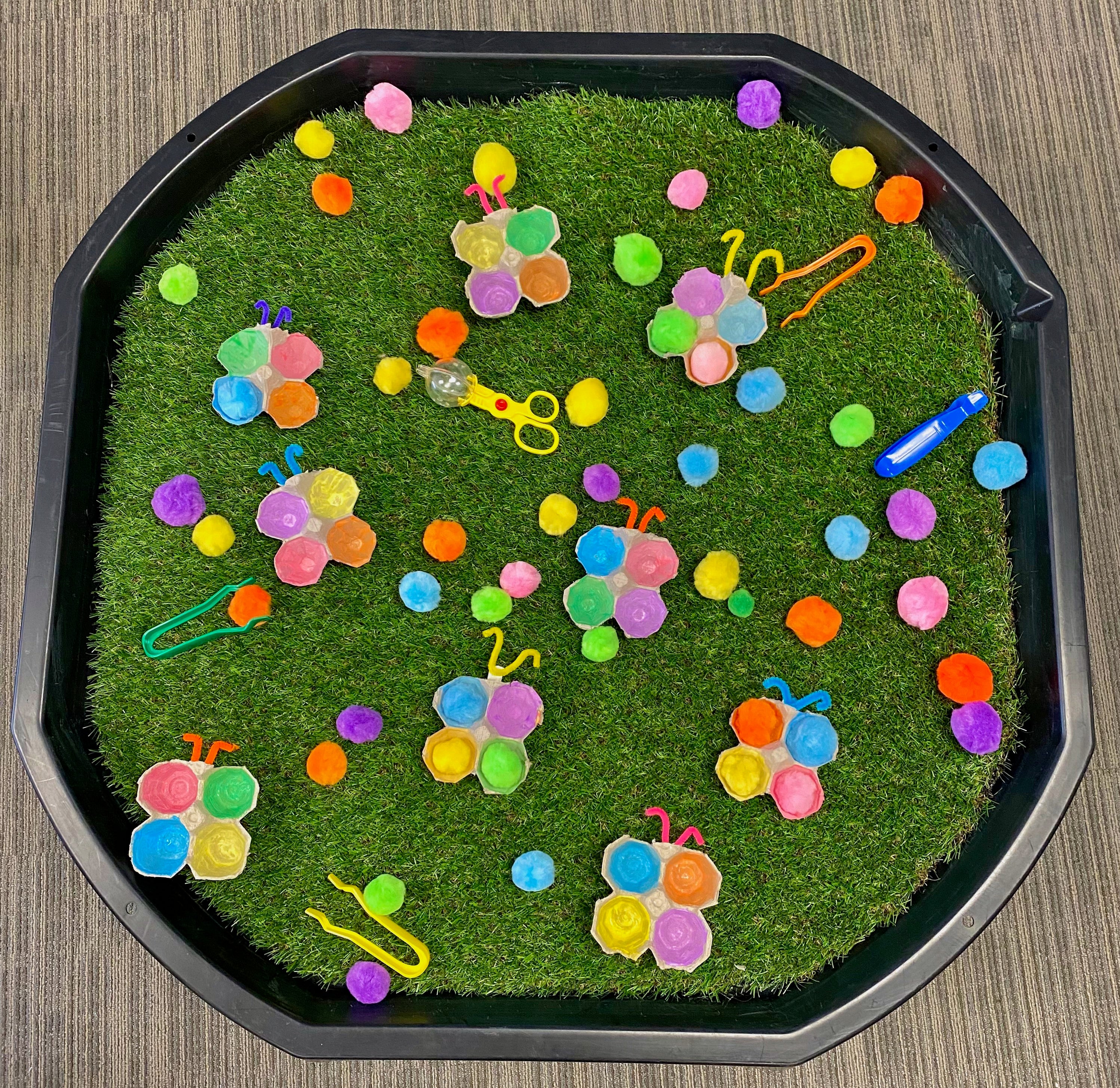

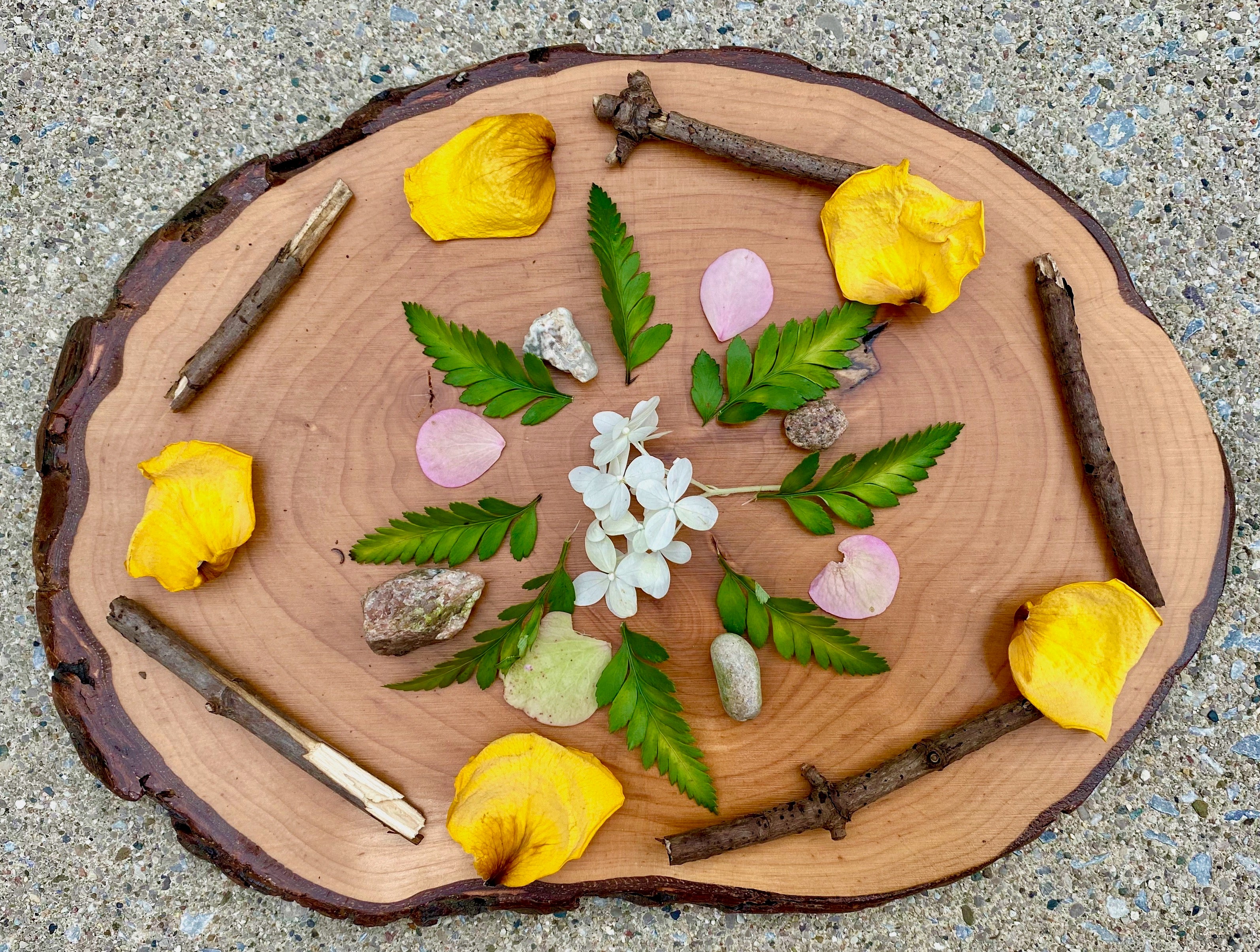

Nature Mandala
This activity is a way to allow children to be creative, explore symmetry and connect with nature.
You can see mandala patterns in natural objects from the radiating petals of a flower to tree rings, spiderwebs, seashells, crystals and more. Mandala is actually a Sanskrit term that means “circle.” Mandalas are circular with a design that radiates out symmetrically from a unifying center. The circular design is meant to express the concept that everything is connected in life.
Talk to your child about the origins of the mandala and ask about their creation. What inspired their pattern? What colours did they choose and why?
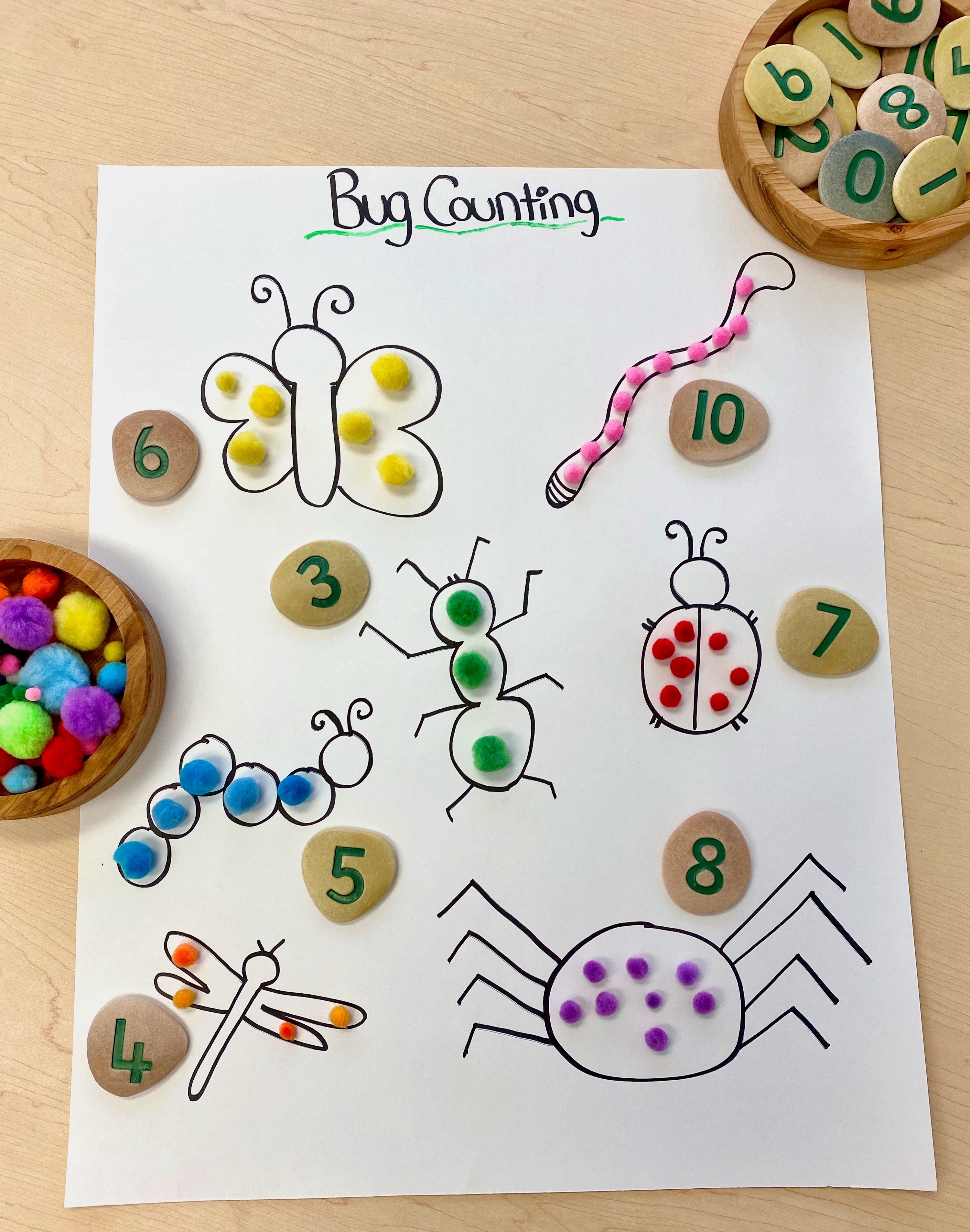

Can you count the spots on the bugs?
This fun counting activity is a great fun way to welcome spring and encourage children to practice number recognition, counting and forming numbers!
Take a piece of bristol board and draw the outlines of different bugs all over the page. Then place number pebbles in a bowl and pom poms in another bowl. Place them beside your bug board and encourage them to count and match.
You can start by:
1. Placing numbers beside the bugs and encouraging children to count and place that many spots on them!
2. Placing dots on the bugs and encouraging children to count and find the matching number!
Ways to extend the play:
-Create number sentences by placing pom poms of different colours to represent numbers and amounts. For example: 3 dots on one wing in green and 1 dot on another wing in yellow! 3+1 = ?
-Place the number pebbles beside the bugs and invite them to put the correct amount of spots on!
-Offer bug counters or dramatic play bugs and invite children to match them to the bug they think they are
-Identify the bugs on the page!
To use your Bug Board over and over again make sure to laminate it! That way it will last forever and you can take it indoors and outdoors


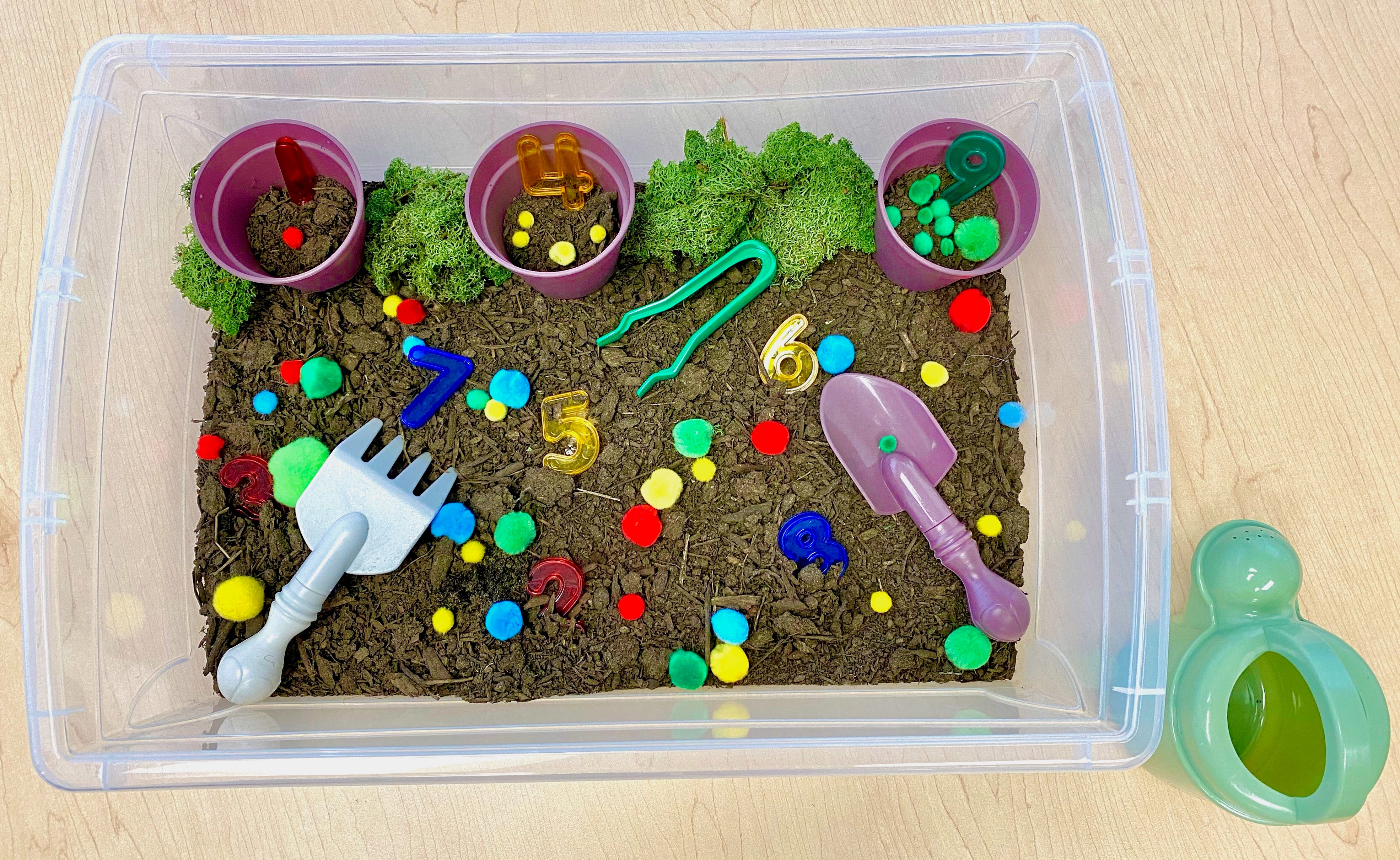

Planting Numbers
Can you help plant the right amount of seeds in our number garden?
To make your number garden pour topsoil in a tray or container and add the plant pots along one edge! In the plant pots place numbers and spread the rest of the numbers in the bin. Place pom poms of the same colours as the numbers to act as your seeds in the soil. Add different gardening and fine motor tools to help your children "plant" the correct amount of seeds in the plant pots.
This activity is a fun way to work on building fine motor skills, number recognition and other early numeracy concepts!
Lifecycle Exploration Tray
Children are naturally curious about the world around them, they are inquisitive and love to wonder about nature. As we enter spring it is the perfect time to naturally observe the lifecycle as it naturally occurs in nature as a sign of spring! This invitation inspired by the lifecycle of bugs is a great way to introduce children to the lifecycle and its different stages!
In your playtray lid add a green sensory bin filler to act as grass, then incorporate elements from the outdoor natural world in your community such as flowers, trees, rocks, wood rounds and more! Then add your life cycle figures, lifecycle tiles and books to support children’s inquiry!
Ways to extend the play:
-Ask children to place the lifecycle figures in order
-Use a magnifying glass to look at them up close
-Collect the pollen like a bee
-Talk about what nutrients the insects need at different points in the life cycle!
-Talk about what the habitats are like for the lifecycle to occur
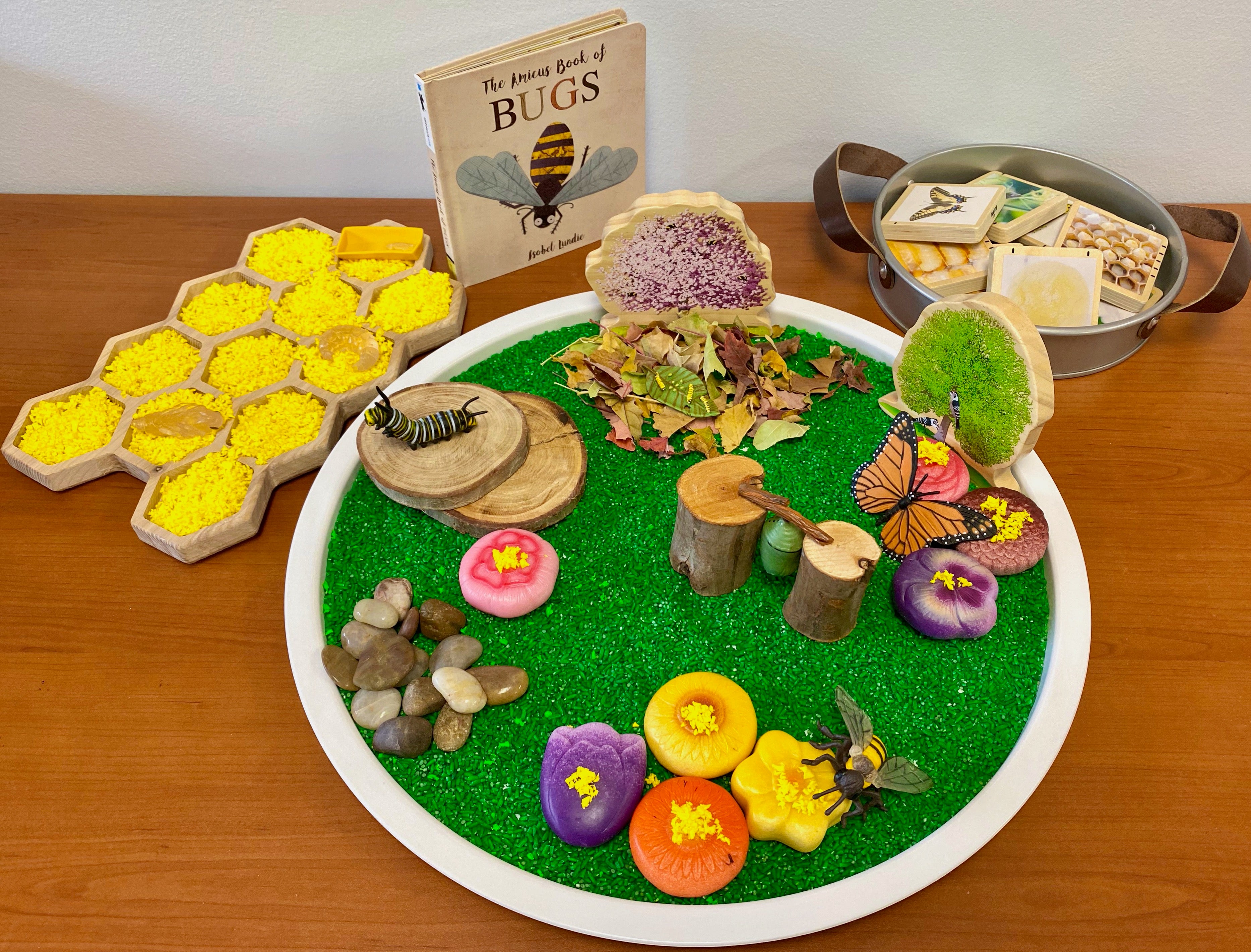

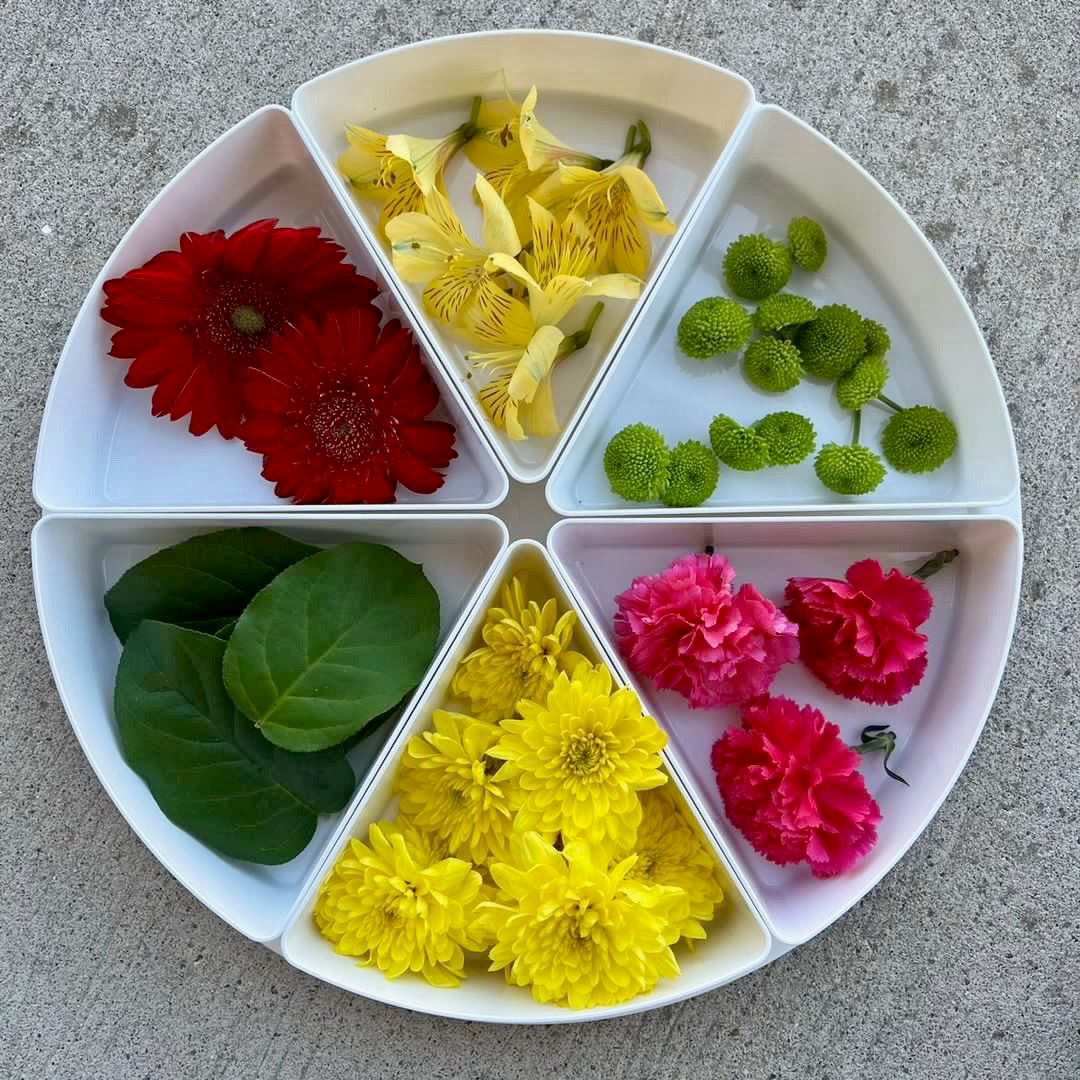

Flower Exploration
Let’s explore the flowers from the garden! This simple invitation is a great opportunity for open ended exploration.
Begin exploring your garden and picking flowers of all colours and sizes and leaves then add them to your playtray compartments. You can offer magnifying glasses, fine motor tools, scoops and pourers and then children will lead based on their interests.
Invitation ideas:
-Use the magnifying glasses to look at the flowers and leaves up close! What do you notice?
-Arrange a bouquet or nature mandala with the flowers
–Offer paper and crayons or paints to create art inspired by them
–Add water to the playtray container with scoops and pourers to create flower soup!
Bug Habitats
Can you create bug habitats for our little friends? This is a great activity to add to a bug inquiry and to learn about what bugs do for you ecosystems!
In your playtray begin crafting a habitat for all your bugs using nature items collected from your local community, a nature walk and playdough! In the compartments add playdough tools, playdough, sticks, rocks, glass, wood rounds & tree blocks, insects and insect stones.
Add magnifying glasses and clipboards to with writing materials for observation!
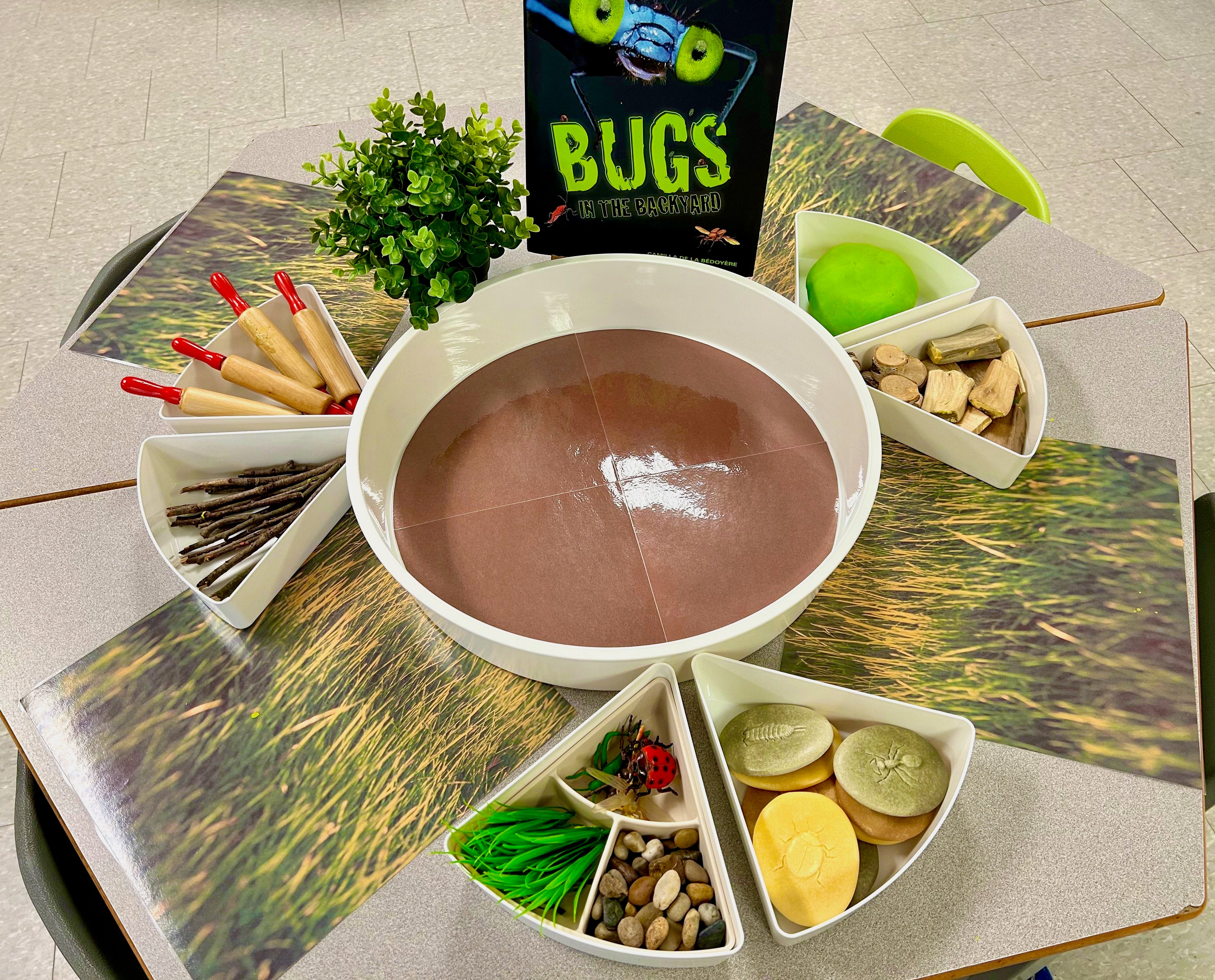

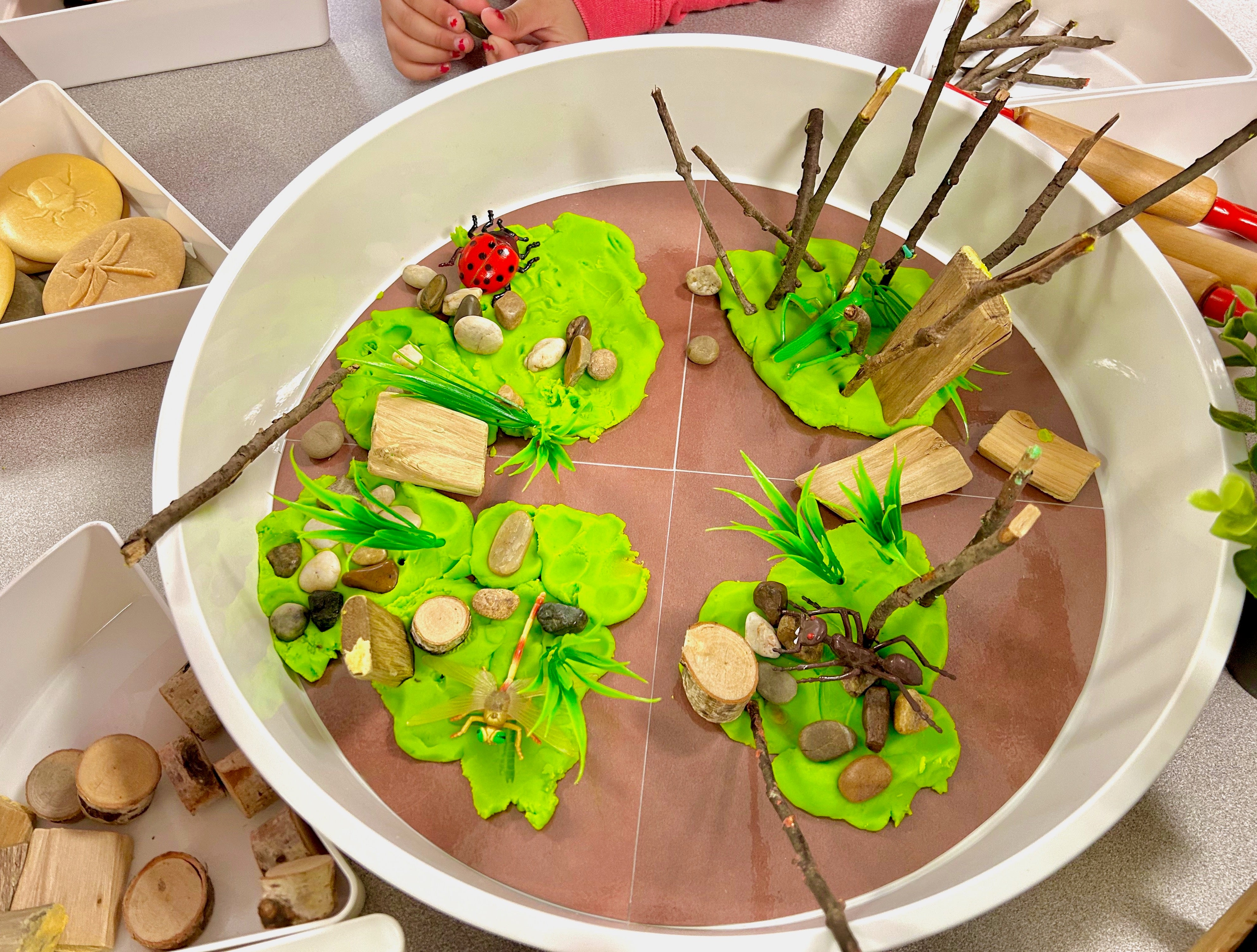

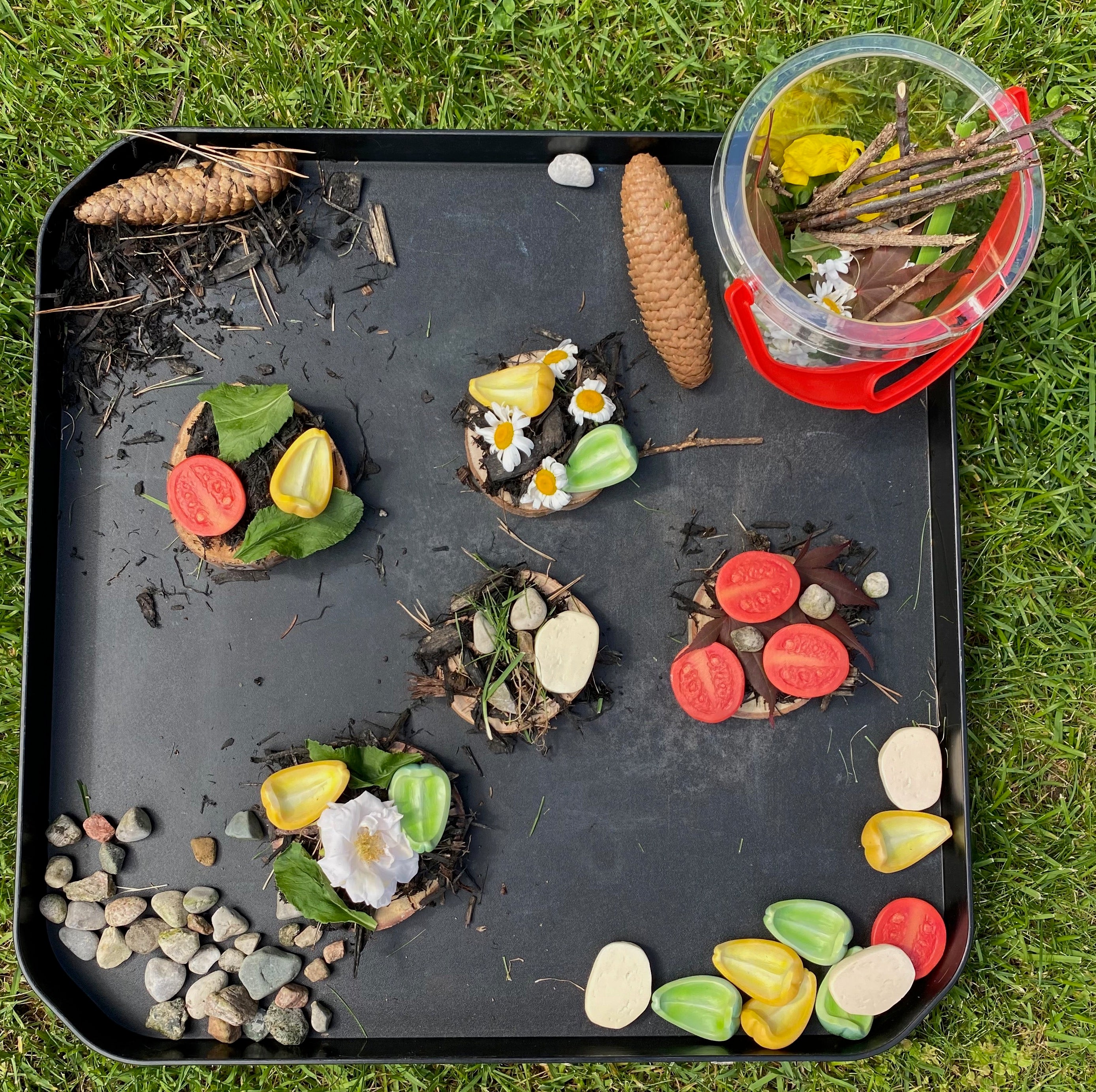

Nature Pizzas
Can you make a pizza with the tastes of nature inspired by your local park, backyard or forest?
To create place wood slices on a tray and offer each child a bucket. Explore your backyard, local forest or a park and collect some unique nature treasures in your bucket! Once you have found lots of different items place your bucket in the corner of the tray with the pizza stones and encourage children to create their nature pizzas!
Ways to extend the play:
-Create recipe cards for children to follow
-Create themed pizzas (flowers, rocks, items that are green)
Nature Paint Silhouettes
This activity is a great way to explore nature and creativity!
All you need is:
-Nature treasures from a nature walk
-Liquid Watercolour Paint
-Easel paper roll
-Paint Spritzers or spray bottles
Step One: Roll out Easel Paper and place your flowers, leaves, sticks, and whatever other treasures you have on your easel paper!
Step Two: Fill your spray bottles with liquid watercolour paint and spray your nature items and around them on your paper
Step Three: Remove your nature pieces and reveal their painted silhouettes!
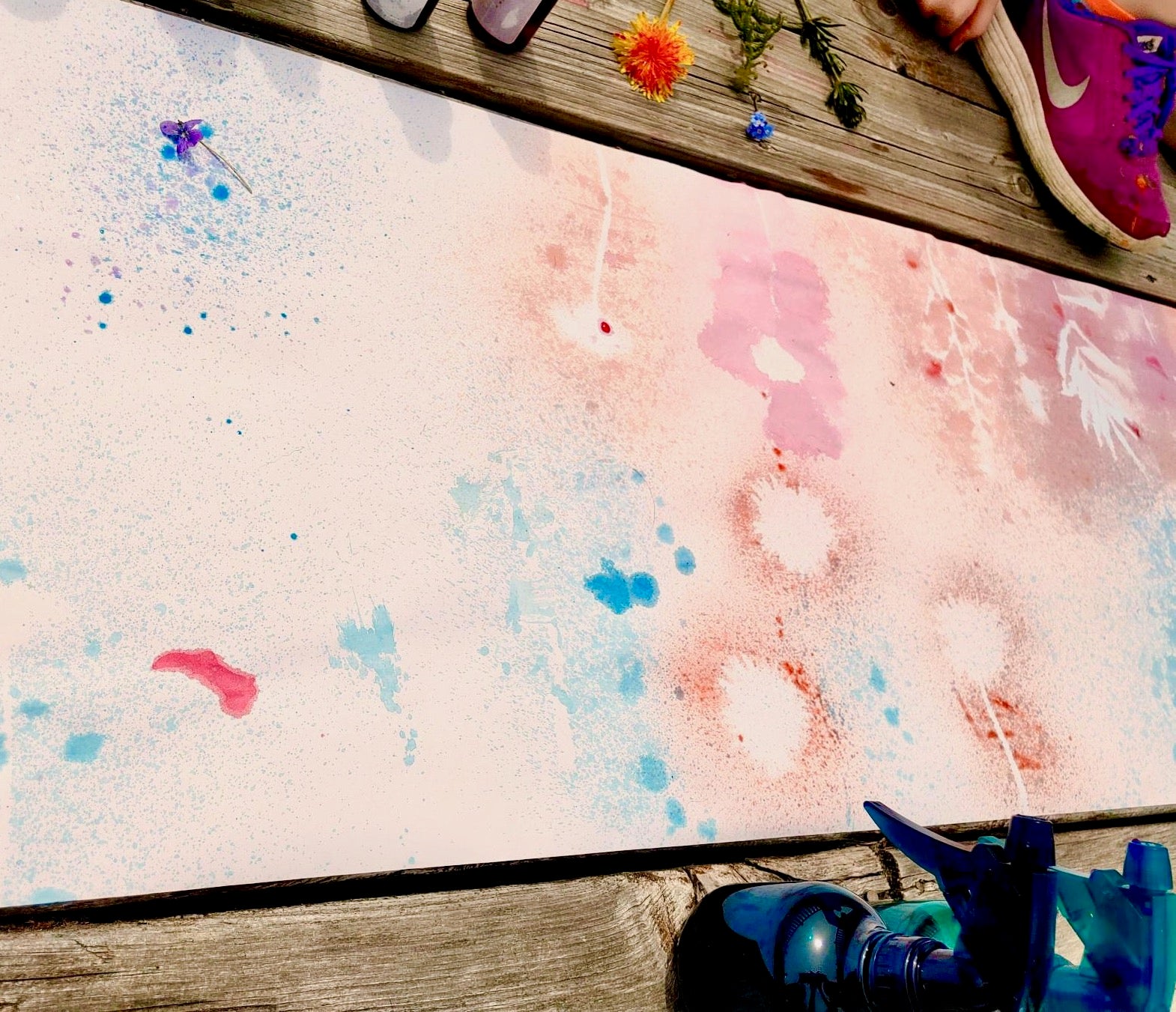

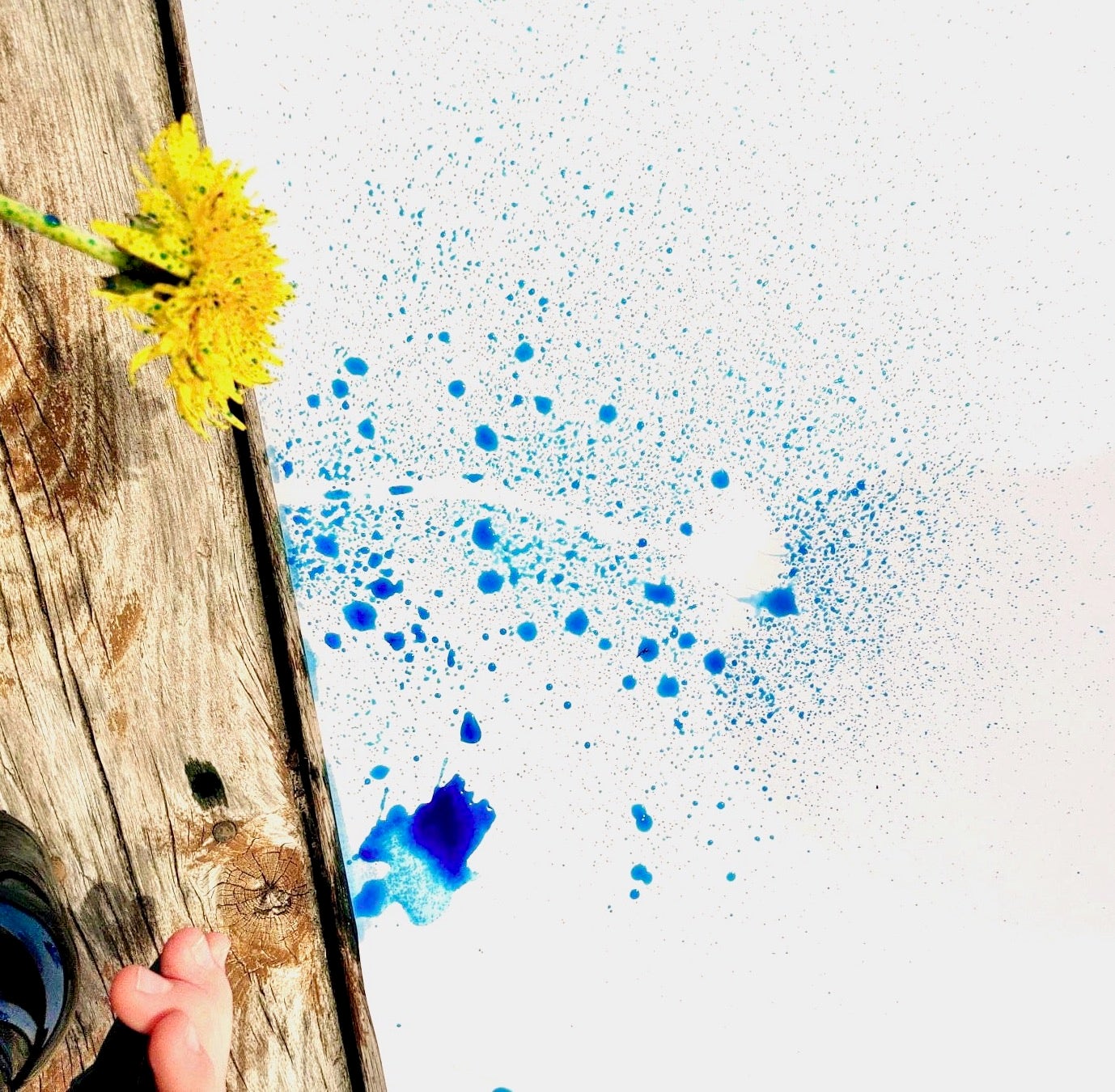

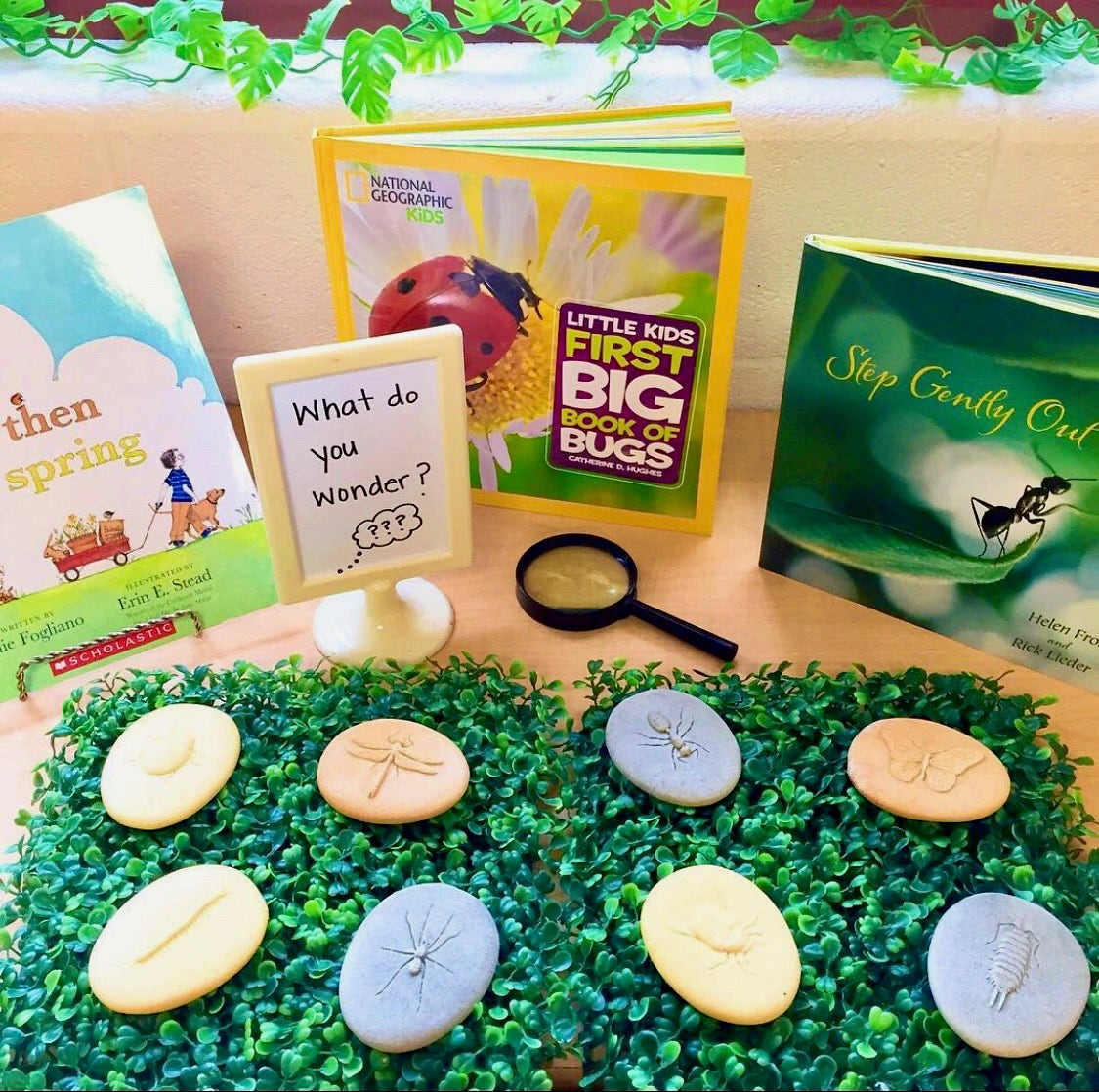

Let's Investigate Bugs
These stones allow children to investigate insects up close in detail. They can observe an ant, beetle, butterfly, centipede, dragonfly, ladybug, spider, and woodlouse, this interesting set of bugs invites children to learn close up about the living creatures they will encounter in their gardens and the world around them!
Ways to extend the play:
-Take your bug stones outside and search for bugs that match!
-Take an imprint of the bugs to create fossils or make bug rubbings with crayons!
-Take a magnifying glass and study them up close. Tell us what you notice!
-Sort them based on which ones have wings and which don't!
-Order them based on which insects have the most legs!
-Read books and point out the bugs you see!
Nature Frame
This activity is a fun way to create and frame the nature and beauty of your own outdoor community!
Simply cut a frame out of recycled cardboard and on the reverse of the frame add strips of clear tape to be the sticky part of your frame! Then go explore your local community, park, forest trail or backyard for interesting nature finds to add to your sticky frame! Create a beautiful nature inspired capture frame!
To extend the play you could create frames with nature finds of one colour or have a stick in the middle and create a symmetrical design.
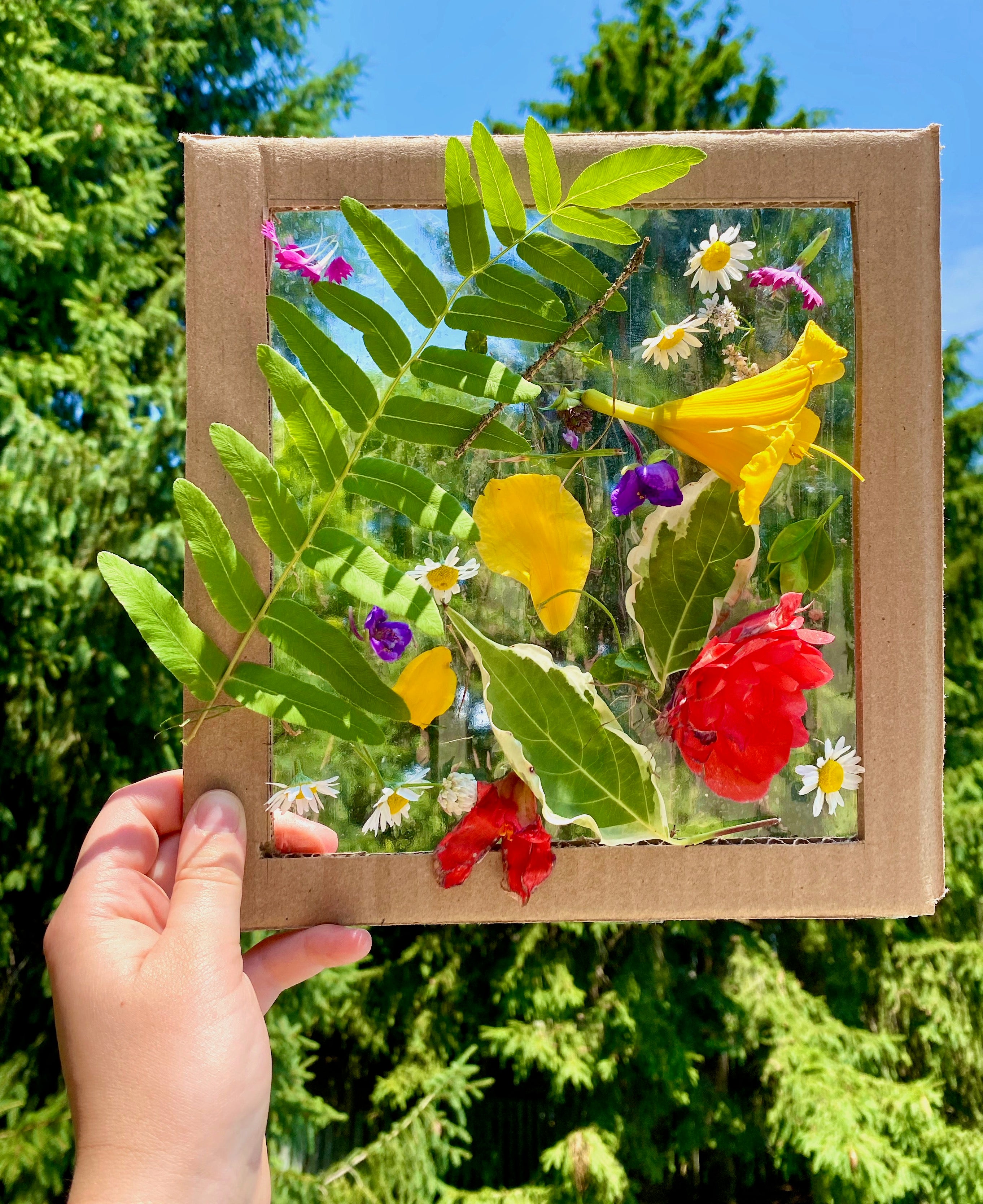

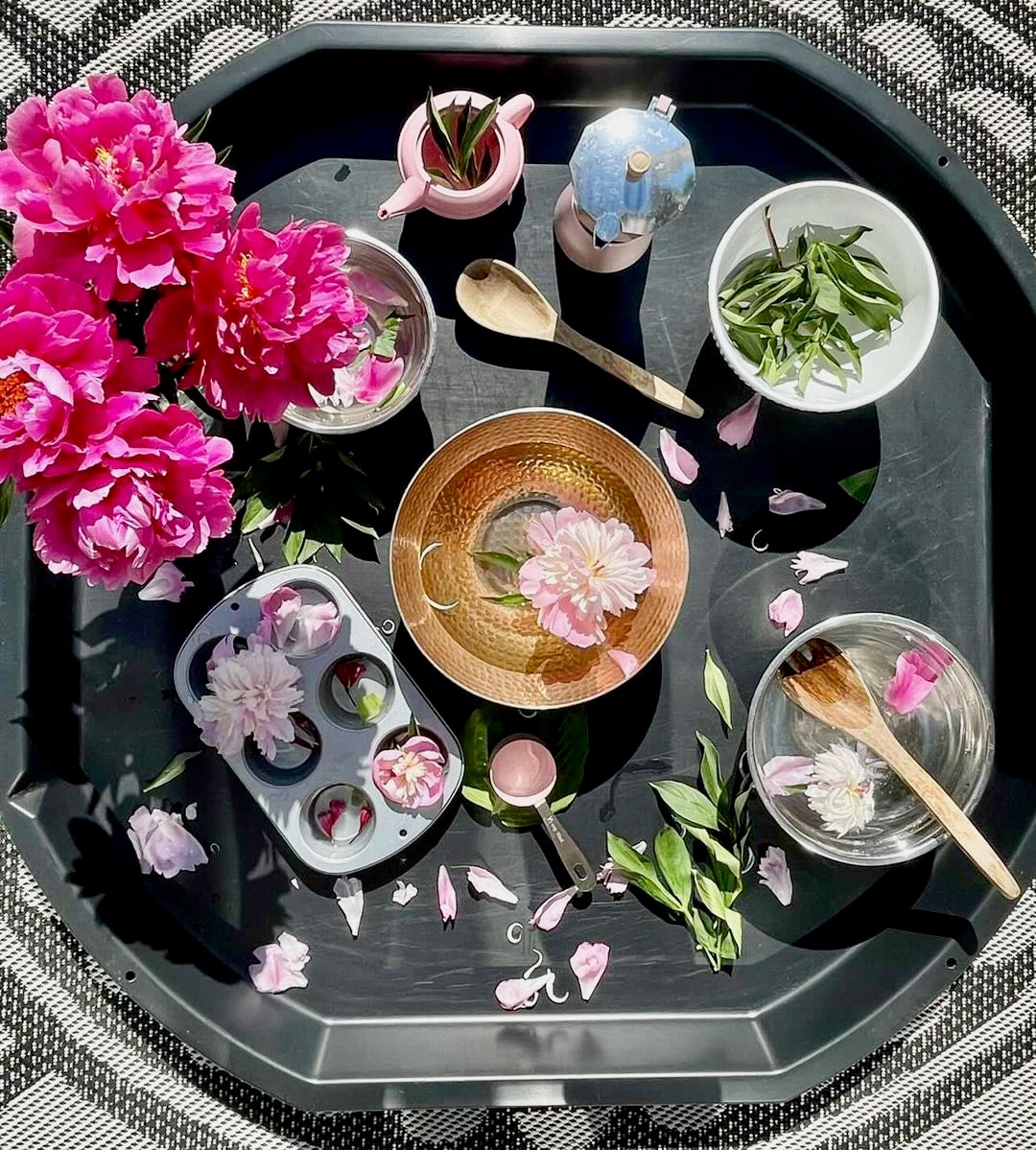

Peony Potions
Children love to explore mixing and creating with simply water and nature pieces - in this case leaves and flowers! They can pour and mix different potions and include more ingredients like the peony petals and leaves to make their potions more magical and even change the fragrance.
As they play they explore concepts of measurement, creativity, build motor skills and enjoy open ended creativity!
How to extend the play:
-Offer a couple of different colours of water to practice colour mixing as well!
-Ask children to predict what they think will happen to each ingredient when you mix it together if you add different compounds
-Encouraging children to later write or draw their potion or a recipe
-Have children write out a list of materials they could use for potion making or encourage them to find other items in the yard to add!
-Writing a story about the magical potion they made and what it does, etc.
Addition Garden
Can you match the flowers with their stems in the garden?
This fun addition activity is a great fun way to welcome spring and encourage children to practice adding, number recognition and matching!
Take a piece of bristol board and grass all across the bottom of the page page. Then draw multiple stems of different sizes and write basic addition equations above the stem. Cut flower shapes out of construction paper and in the middle write the numbers between 0 -10! Place the flowers along the top of your board and encourage children to match the flower with the number that is the correct answer for the stem!
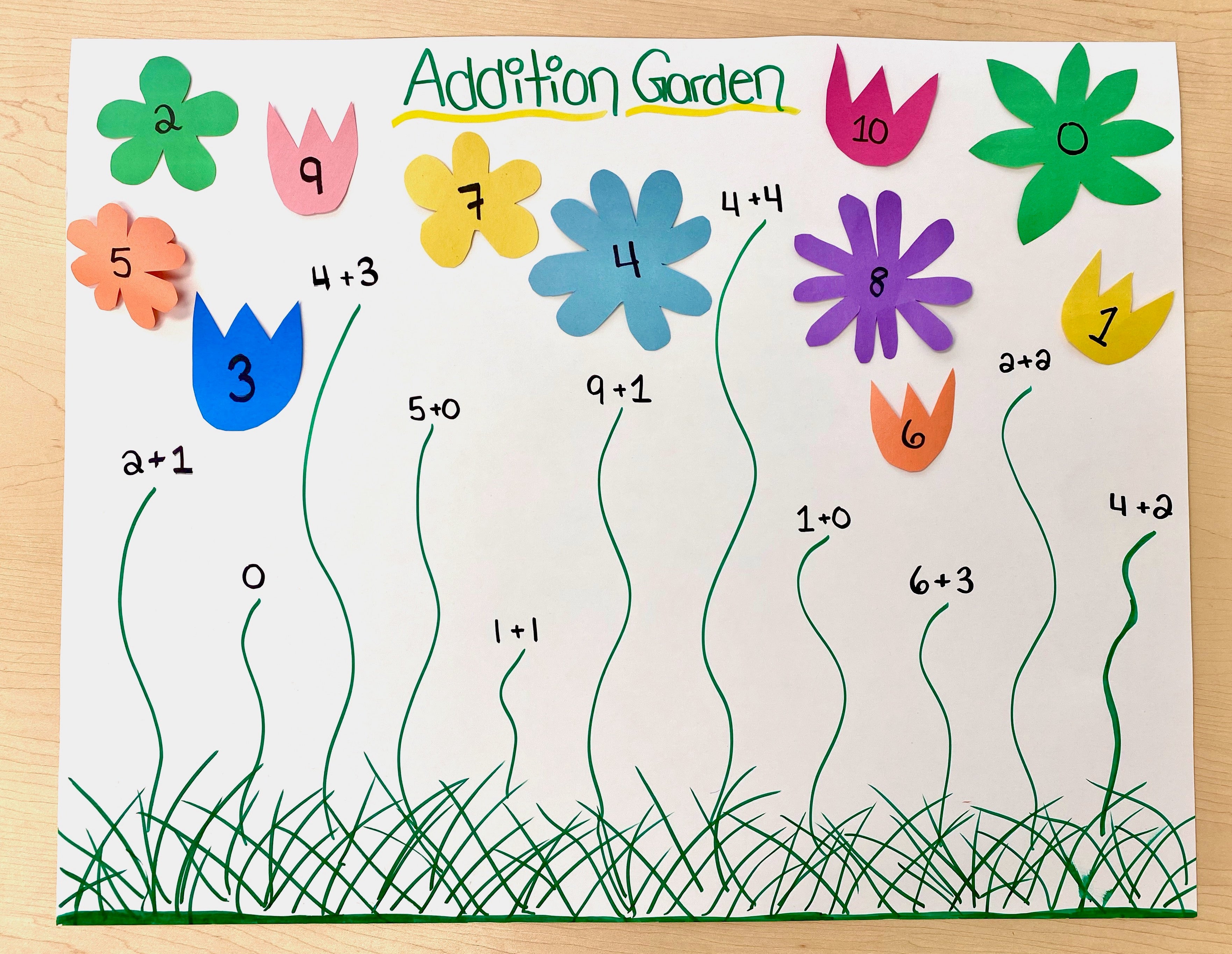

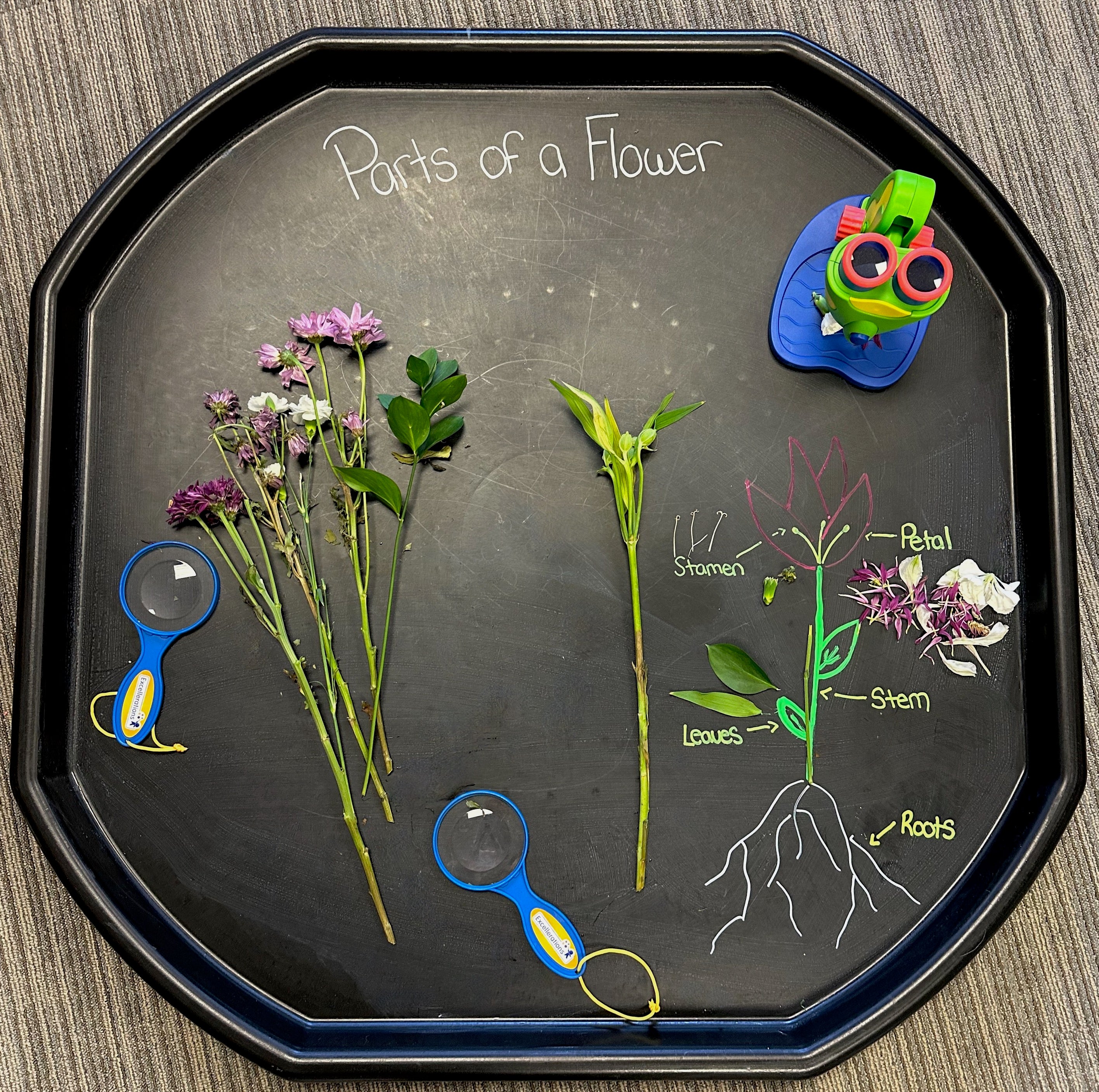

Can you investigate the flowers and disassemble them to find all the different parts of a flower and identify them? This is such a fun way to explore early stem concepts in your nature play!
Go on a nature walk in your community and collect flowers or give new life to an old bouquet of flowers. Place them in your tuff tray and with chalk markers draw a flower and label the parts to help aid your little learners identification and inquiry! Add different materials to help aid your dissection like magnifying glasses, a microscope, tweezers, child safe scissors, etc. Then do a simple flower dissection to identify and name the parts of a flower.
Though flowers differ widely in appearance, there are a few characteristics that remain the same
-Petal: This is usually brightly coloured to make them attractive to insects.
-Stem: The plant part that holds it up and carries water to the rest of the plant.
-Leaves: The part of a plant that uses sunlight to make food
-Stamen: Produce pollen and make it available for pollinators such as butterflies, birds, insects, bees etc
-Roots: The plant part that holds a plant in the ground and helps it get water from the soil.
Can you create flowers for the garden?
This activity is a fun way for children to explore being inspired by nature and loose parts! On a tray (or piece of paper) lay down dirt to act as the base of your garden and use a green chalk marker (or green marker) to create flower stems. Then place loose parts in a bowl and encourage children to create!
Ways to extend the play:
-Offer your children photos of flowers or a book about flowers and encourage them to be inspired by those flowers as they create!
-Encourage them to name their flowers!
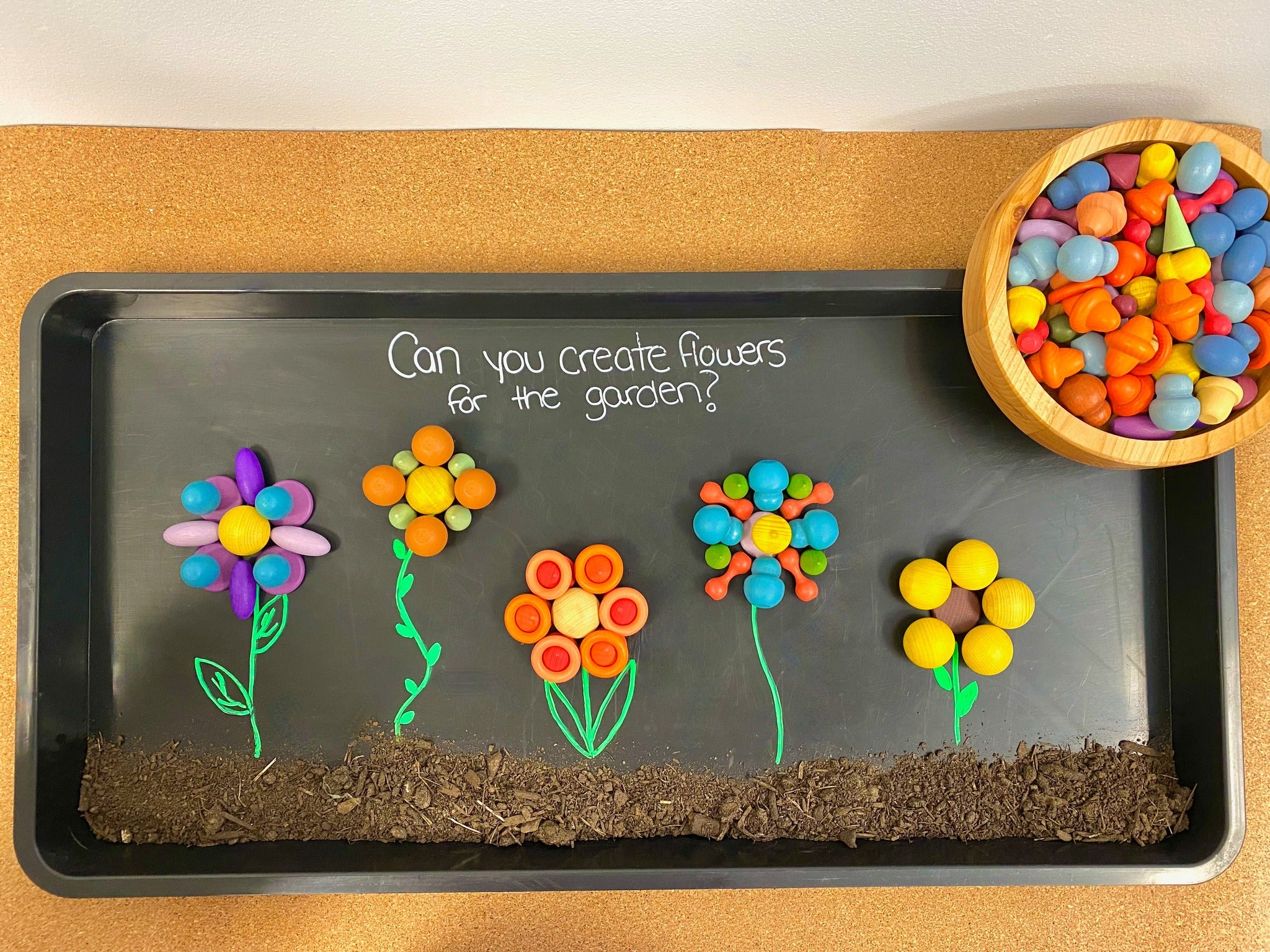

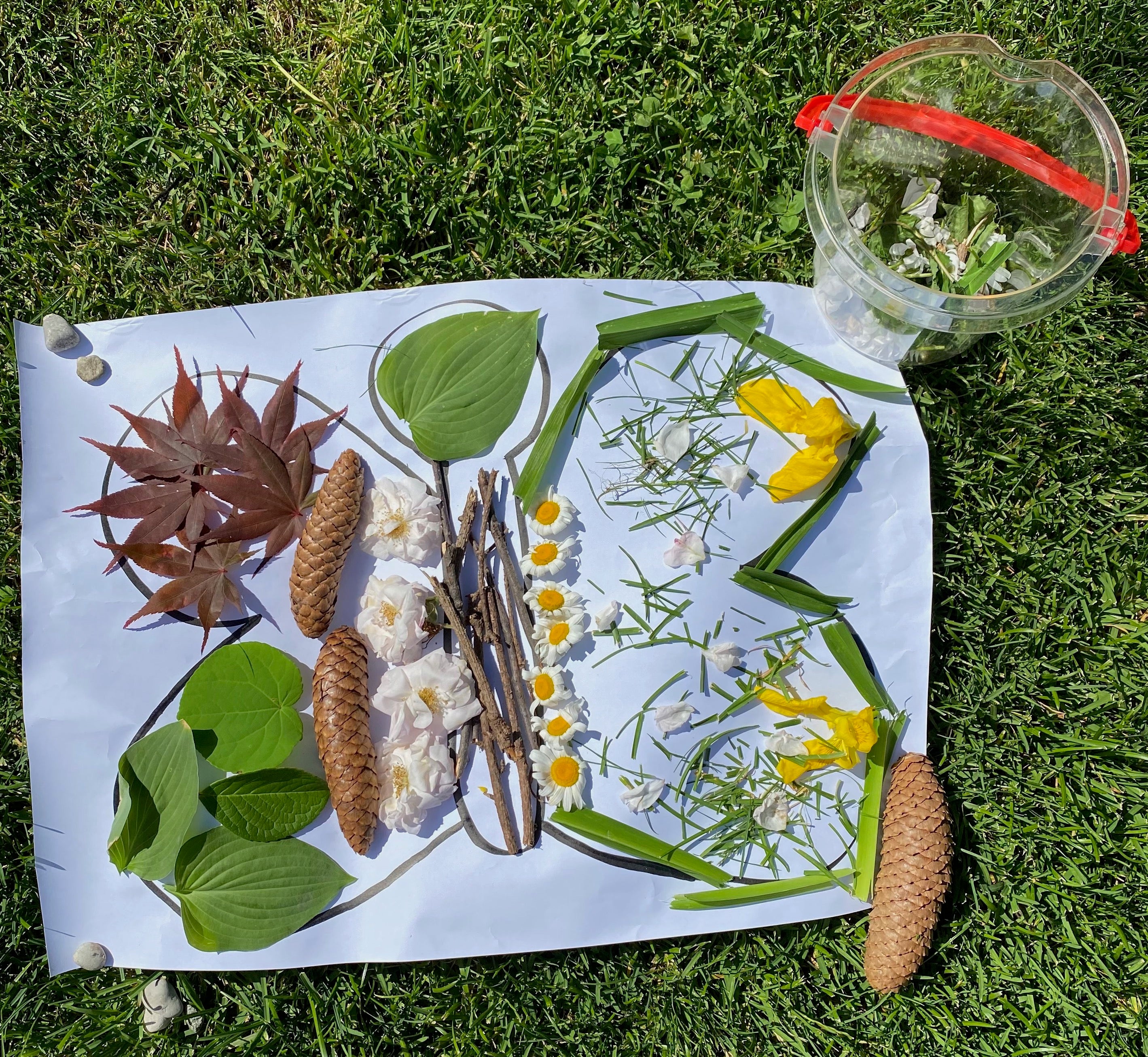

Nature Butterfly
This activity is a great way to offer children an opportunity to be inspired by nature and let it show through their creativity.
To create, take a large white piece of bristol board and draw the shape of a butterfly on it (cut it out or leave as a poster) and offer each child a bucket. Explore your backyard, local forest or a park and collect some unique nature treasures in your bucket! Once you have found lots of different items place your bucket in the corner of the butterfly board and encourage children to design their own nature inspired butterfly!
Let's Explore Nature & Bugs
What bugs are hiding in the grass for you to find? This insect and nature inspired small world is a fun and easy way to explore bugs up close with your children and the nature they live in.
In your tuff tray add green play scarves to act as your grass as well as different nature items from your yard. Then add different loose parts inspired by nature and a trunk! Then add bugs amongst your grass and nature items. Add books and your insect x-rays with magnifying glasses to aid children's observation!
Ways to extend the play:
-Match the bugs you see with bugs in the books and on the x-rays!
-Talk about the habitats of these bugs!
-Study them up close with magnifying glasses and talk about what you notice
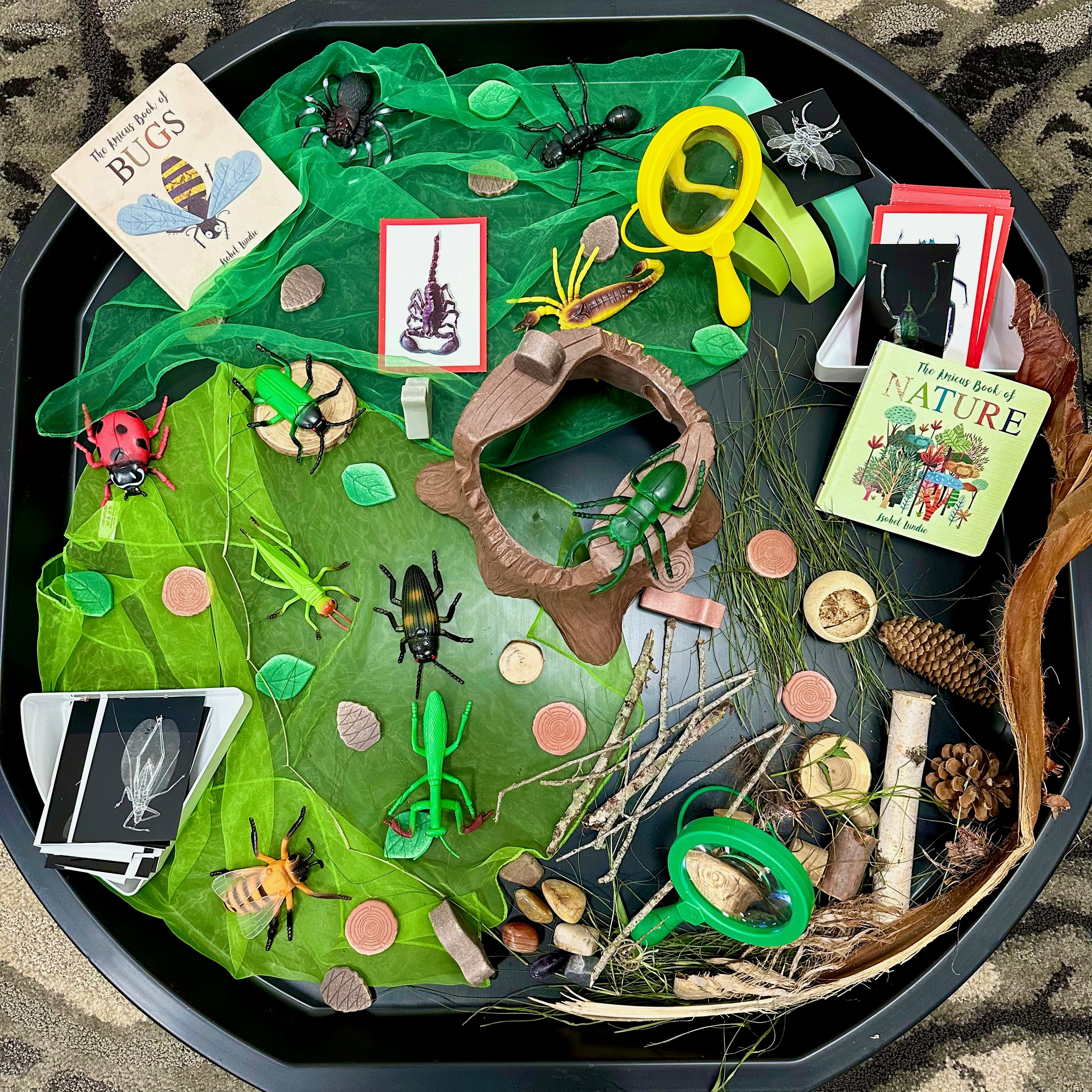

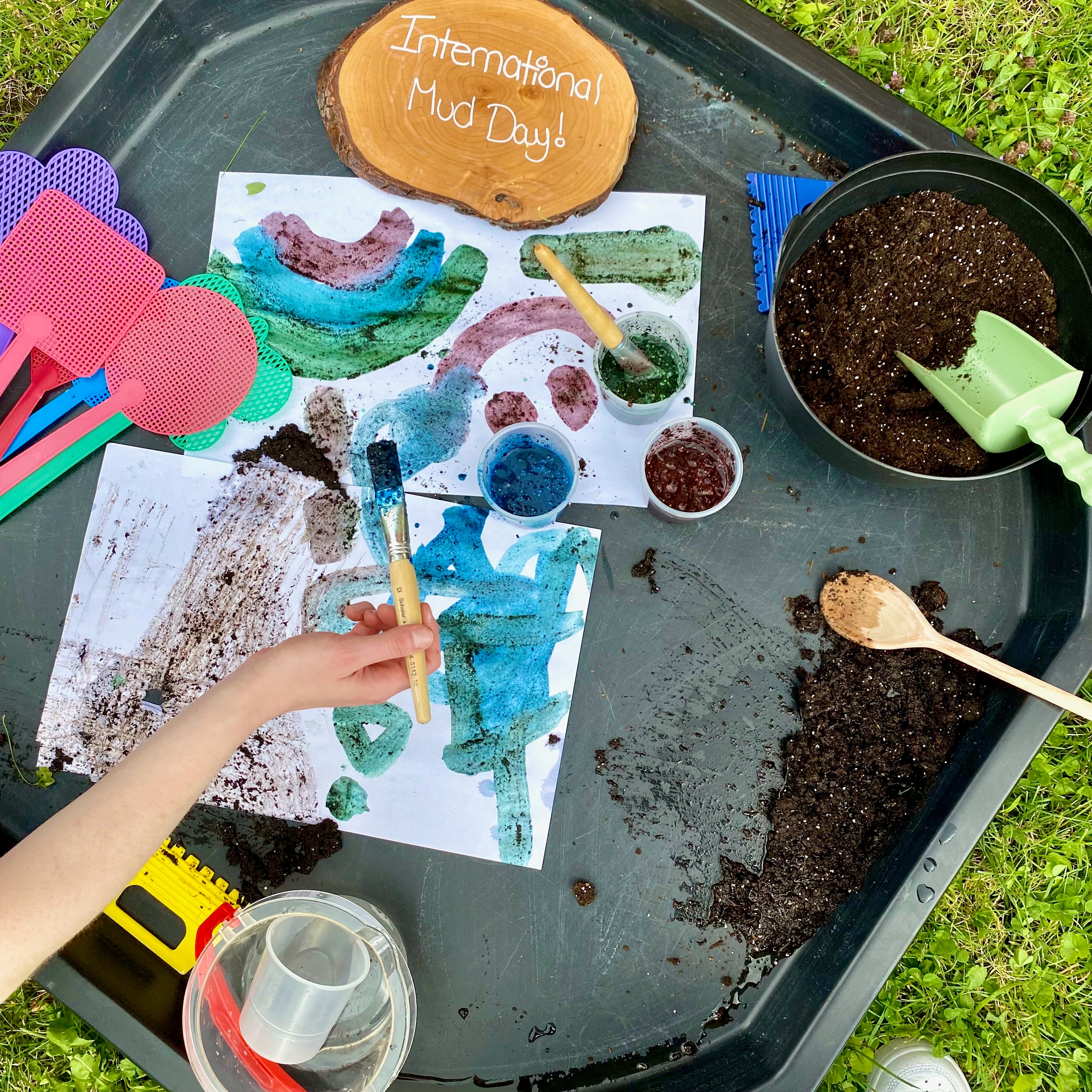

International Mud Play Day!
Children love to get messy and play in the mud and good thing because it is incredibly important to their early development. So we decided to celebrate International Mud Day by getting outside and playing two ways in our tuff tray!
In your tuff tray place down paper, paint scrapers, paint swatters and different paint brushes! In a paint pot mix dirt and tempera paint to create a thick paint like paste. Explore painting different ways!
Benefits of Mud Play:
-Mud Play encourages creativity in children. It is important has they play imaginatively outdoors and experience nature. This facilitates opportunities for them to problem solve, come up with and explore ideas and exercise their minds!
-Playing in the mud is also important for children so they can develop and practice their fine and gross motor skills, increase awareness of their senses, particularly touch, improve hand/ eye coordination!
Shape Button Butterfly Puzzle
Can you match all the buttons to create the butterfly?
This activity is so much fun and takes no time at all to set up! All you need is colourful markers, a piece of white bristol board and your shape buttons. On your bristol board draw the outline of a butterfly and take shape buttons of every colour and trace them to fill in the butterfly outline. Once finished, place the shape buttons you traced in a bowl and offer to children to match and create their butterfly!
This activity works on childrens ability to match and identify shapes and colours! You can also extend the activity by calling out a shape of a certain colour and ask children to find and match it.
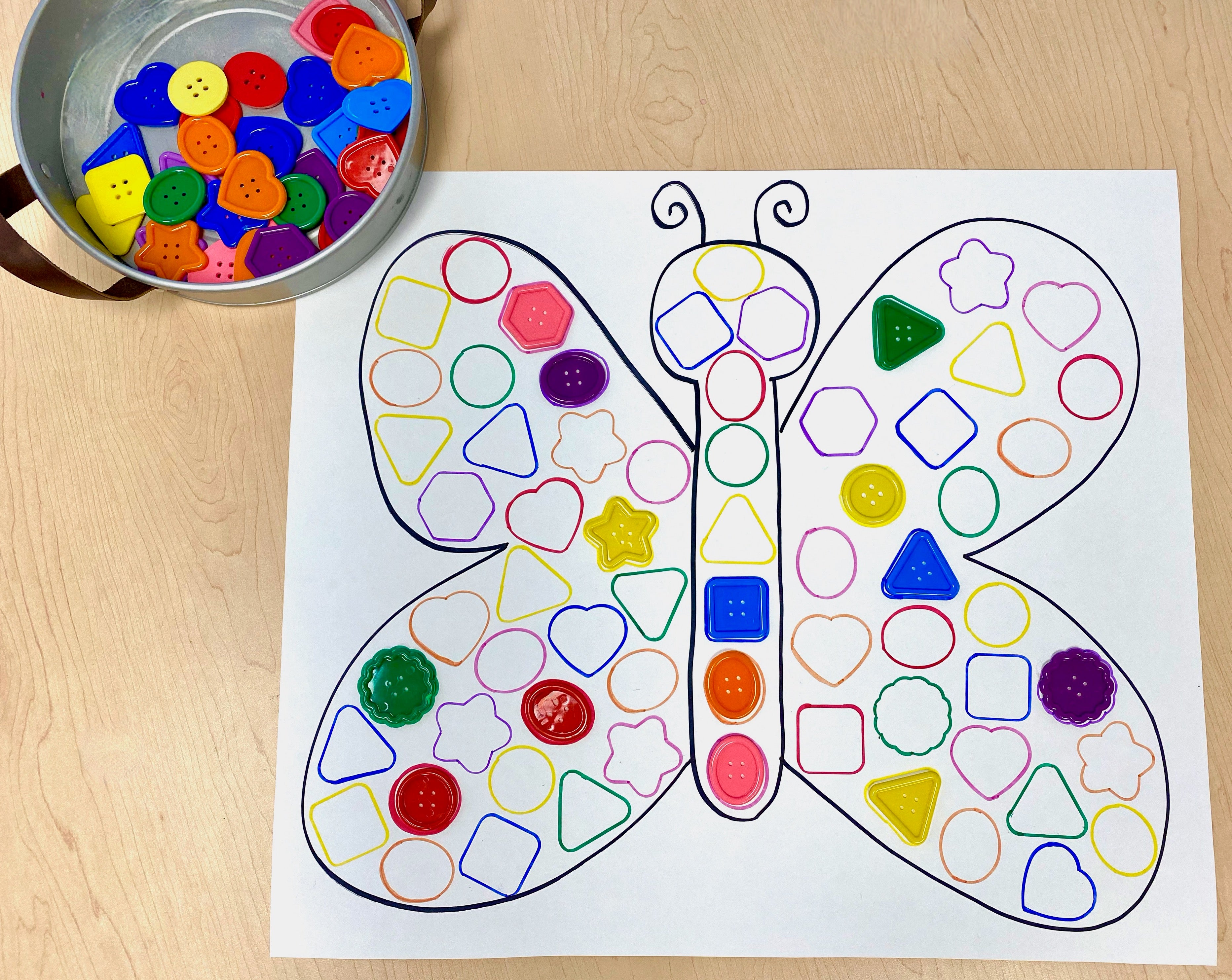

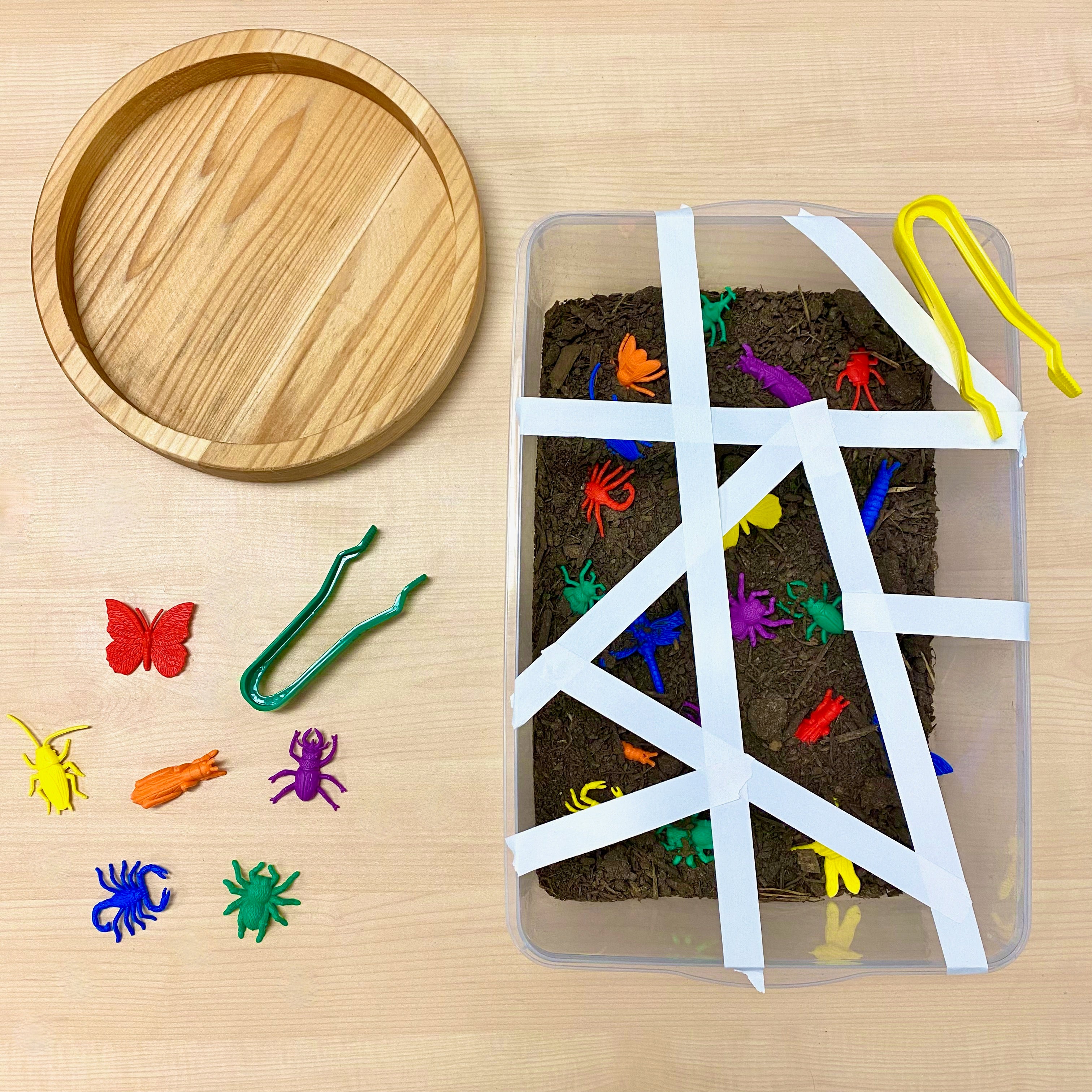

Free the Insects!
Can your child use the tweezers to free the insects? This activity is a fun and easy way for children to build fine motor skills as they explore early math concepts and play!
Ways to extend the play:
-Sort the insects by colour!
-Sort the insects by type!
-Count how many of each you have based on what way you chose to sort
-Create colour or bug patterns
-Identify the insects!
As we wrap up this delightful journey through spring crafts and activities, we hope your little ones have enjoyed the blossoming creativity and the joy of exploring the wonders of the season. From vibrant art projects to outdoor adventures, these activities are not only a source of entertainment but also opportunities for learning and bonding.
Remember, the beauty of spring extends beyond the flowers and sunshine—it lies in the shared moments of laughter, discovery, and hands-on experiences. As the days get longer and nature comes to life, take the time to cherish these precious moments with your kids.
Feel free to revisit this blog whenever you're in need of inspiration or a burst of springtime energy. May your days be filled with colorful crafts, outdoor explorations, and the warmth of shared memories. Happy crafting and embracing the joys of spring with your little ones!

